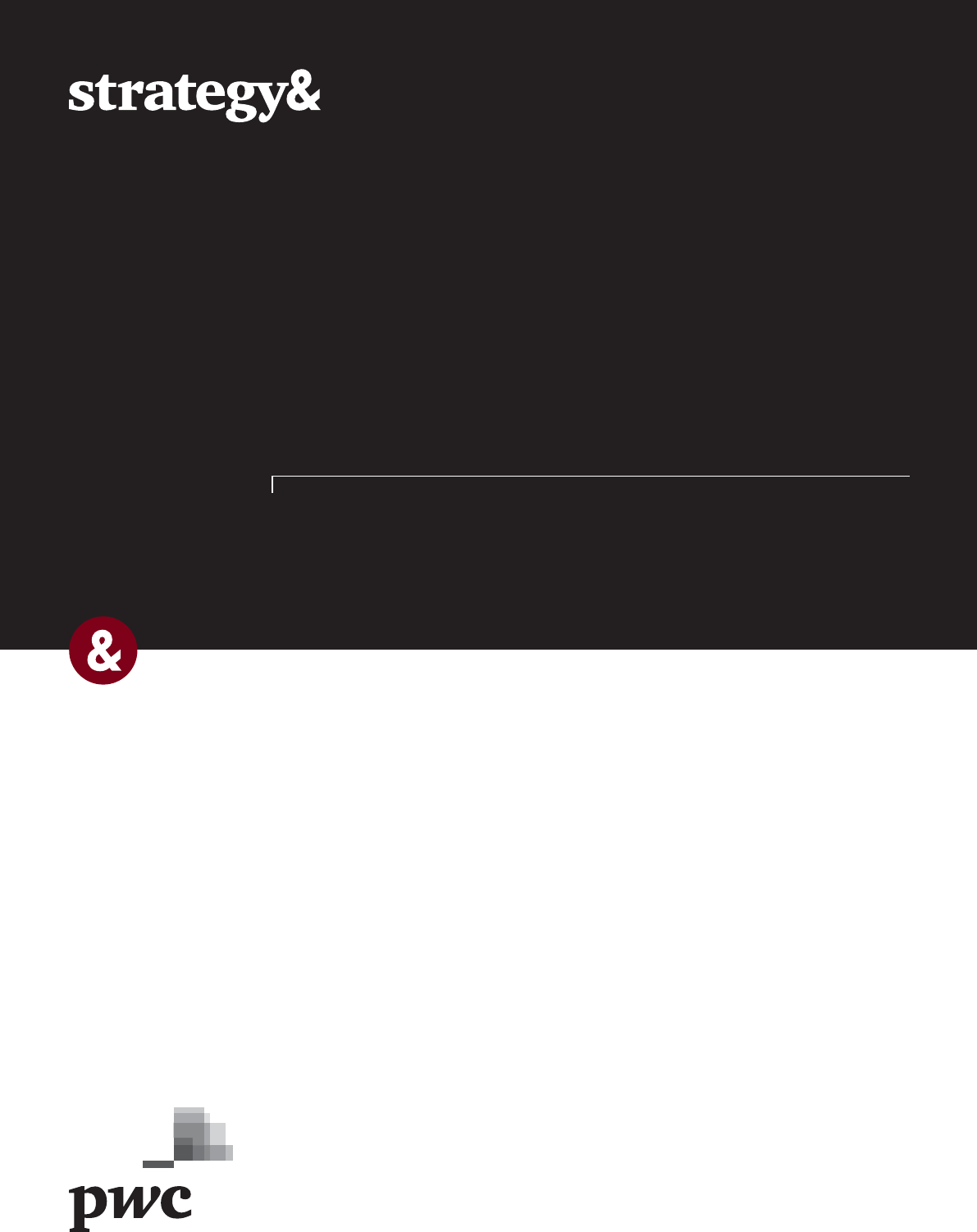
How the Internet
is fueling the
growth of creative
economies
Content
democratization

3Strategy&
About the authors
Jayant Bhargava is a Dubai-based partner with Strategy& and a
member of the firm’s communications and technology team. He leads
the firm’s work within the media and entertainment vertical and
focuses on the convergence of media, telecoms, and technology,
working at the intersection of traditional and digital media. His recent
client assignments include working with broadcasters, publishers,
advertisers, telecom operators, and technology players on strategy
and business models, M&A, and operating models, and supporting
government institutions on media sector policies and development
strategies.
Alice Klat is a Dubai-based manager with Strategy& and a member
of the communications and technology team. She leads consulting
assignments in the Middle East across the media, telecom, and
technology sectors. Her recent client work has included digital
transformation of traditional media companies such as broadcasters
and publishers, content and digitization strategies for telecom operators,
and growth strategies for technology service providers.

4 Strategy&
Contents
Methodology 5
Acknowledgments 6
Highlights 8
Introduction 10
Chapter 1
Japan: Growth in a contracting economy 38
Chapter 2
India: Digital infuses innovation and diversity 48
Chapter 3
Australia: The revival of content 63
Chapter 4
South Korea: Opening the creative sector to the world 80
Chapter 5
Thailand: Transition to digital creative content 100
Conclusion 113
Endnotes 115

5Strategy&
Methodology
The amount of digital content created, exchanged, and consumed is
growing by the day across the world, and because the Internet has
democratized access to creation and distribution tools, boundaries
between professional and amateur content are blurring across all
parts of the creative sector. The objective of this report is to provide a
comprehensive view of the eect of the Internet on content providers
and distributers, emerging artists, and consumers in five very dierent
countries— Australia, India, Japan, South Korea, and Thailand. We
selected these countries because they feature highly varying levels of
Internet connectivity, infrastructure development, and media reach.
Studying the commonalities and dierences among them contributes
to an understanding of how the Internet can bring value to the creative
sector regardless of a country’s institutional and technological
framework.
We analyzed the impact from the consumer perspective as well as from
the creator and industry perspectives, providing a dierentiated
perspective on each player.
Our methodology combined desk research with one-on-one interviews
with representatives of leading companies in each of the five countries.
Our desk research was based on respected industry sources such as
PwC’s Global Entertainment and Media Outlook, Ovum, and the World
Bank, to name just a few. We assessed the impact of the Internet on
both a quantitative and a qualitative perspective. Some of the key
quantitative figures we analyzed were the market size and growth of
the creative sector, the evolution of consumer time spent across media,
and indicators of each country’s degree of digitization. Examples
of qualitative factors we assessed include creative industry players’
business models and evolution, and strategies for integrating traditional
and digital media, as well as market dynamics and competitive
strengths.

6 Strategy&
Acknowledgments
We would like to acknowledge the central role of numerous participants in
meetings and interviews across Australia, India, South Korea, and Thailand.
Without their expert insights, the study would not have been possible in the
present form.
We thank the following individuals and organizations for their time, insights,
and thoughts.
88KeysToEuphoria (India)
A.ble (South Korea)
AIB (India)
Alan Adcock (Thailand)
Allens law firm (Australia)
Arirang TV (South Korea)
Australian Digital Alliance (Australia)
BKI (South Korea)
Baker & McKenzie, Sydney
(Australia)
Bandi/Luni’s (South Korea)
Courtney Barnett (Australia)
Beamafilm (Australia)
Bookmoby (Thailand)
BuzzBean (South Korea)
Casbaa (APAC)
K. Chaiyan (Thailand)
Channel 7 (Thailand)
Choc Chip Channel (Thailand)
Chung-Ang University (South Korea)
Crikey.com.au (Australia)
Dotty (South Korea)
Draw with Jazza (Australia)
Dymocks (Australia)
Electronic Frontier Foundation
(Australia)
Flipkart (India)
Gaana (India)
GrabTaxi (Thailand)
Hearst-Bauer Media brands
(Australia)
iFlix (Thailand)
I Quit Sugar (Australia)
KT Olleh Music (South Korea)
Khajochi (Thailand)
KledThai (Thailand)
Korea’s Game Association
(South Korea)
Loen Entertainment (South Korea)
Mahidol University (Thailand)
Manodio (South Korea)
Mint (India)
Mun FM (Thailand)
NHN (South Korea)
National Programme on Technology
Enhanced Learning (NPTEL)
(India)
New Media Communication
(India)
Nexon (South Korea)
Olleh Games (South Korea)
Ookbee (Thailand)
OpenNet (South Korea)
Ormschool (Thailand)
Pandora Australia and New Zealand
(Australia)

7
Pantip (Thailand)
Phonographic Performance
Company of Australia
(Australia)
Rajshri Entertainment (India)
Rich World Record Label
(South Korea)
SBS (South Korea)
SM Entertainment
(South Korea)
Screenrights (Australia)
Shemaroo Entertainment (India)
SketchShe (Australia)
Sony Music Entertainment Australia
(Australia)
Southern Cross Austereo (Australia)
State Library of New South Wales
(Australia)
Thai Rath (Thailand)
TrueVisions (Thailand)
Turner Asia (Thailand)
Universal Music (Australia)
Van Vuuren Bros (Australia)
YG Entertainment (South Korea)
YoBoHo (India)
Whacked Out Media (India)
This report was financed by Google Inc., and independently researched
and written by Strategy&, PwC’s strategy consulting business. It draws on
expertise from Strategy&’s communications, media, and technology practice
and from its digitization team, as well as on academic and public research,
public information, and primary research.

8 Strategy&
Highlights
• The growth of digital content, and especially paid digital
content, is driving the growth of the creative sectors in all of
the five countries we studied. And it is growing more rapidly than
the nominal GDP in most of these markets. In fact, in Australia,
South Korea, and Japan, all of the growth in creative industries
is being driven by digital media. Digital media contributed
$14.5 billion in revenues across these three markets from 2012
through 2014.
• People are spending more time consuming both the traditional
and digital output of the creative sector, almost entirely due to
the Internet. Time spent consuming content has been increasing
across all five countries in our study as people spend a greater
portion of their leisure and entertainment time with creative
content. In Australia, for instance, people spend an average of 9.7
hours a day consuming content,
1
up from six hours a day four years
ago, with almost half of this time being spent on the Internet.
Similarly, growth in time spent consuming content on the Internet
ranges from 5 to 11 percent annually across Thailand, India, and
South Korea.
• We are witnessing the rise of a consumer-creator model that has
broken down the barriers to the creation and distribution of content.
Consumers are increasingly participating in infotainment and video
content creation through forums, blogs, and social networks, and
social media platforms have enabled users to convert their passions
into careers by making their work accessible to millions of users
around the world.
• Digital content is at the heart of the emergence of a cultural
renaissance thanks to the opportunity for niche content creators to
distribute their products on the unlimited shelf space of the Internet.
Broadcasters, publishers, and other traditional media distributors
that were constrained by limited space for their content oine have
seen their business models disrupted.

9Strategy&
• Digital is also enabling the spread of content across large and
previously underserved populations, especially in markets such as
India, where a vast majority of the population does not have access
to traditional media such as newspapers, books, and pay TV. These
populations are now able to access content on the Internet, in many
instances through their mobile phones.
• The export market for content from these countries has grown
rapidly, as the Internet permits easier access to international
markets, yielding significant revenues. Content creators and
distributors across all creative sectors now have access to previously
untapped markets.
• Emerging artists are benefiting from open, instant, and, in many
cases, free access to a critical mass of users via online distribution
platforms, as well as from dedicated platforms providing assistance
in production, distribution, monetization, and audience
development.
• Local content consumption is rising, as exemplified in Australia,
where short-form audio/video content is much more popular on
digital platforms than on long-form box oce platforms. Local
YouTube artists in Australia are capturing and engaging with a much
larger share of the country’s audience than is the box oce, where
just one of the top 20 movies for each year between 2010 and 2015
was local.
• Content majors can now access larger audiences while increasing
loyalty and tailoring their oerings to user preferences. They also
benefit from cost-eective access to new talent.
• Distributors are monetizing digital, international, and long-tail
content and building more agile and cost-eective new business
models. Social media has also allowed them to capture more
audiences and increase content usage.

10 Strategy&
Introduction
As of July 2016, almost 3.41 billion people around the globe
(46 percent of the world’s population) were connected to the Internet.
The Internet has reduced the distance between them, allowing for
instant communication and exchange of data, news, opinions,
information, entertainment, and more. In so doing, the Internet has
transformed many industries— from telecommunications and finance
to retail and travel. The five creative sector industries that we consider
in this report have been no less transformed.
Indeed, the creative sector has become a prime example of the
convergence of the digital and the non-digital. The line between a TV
show or a newspaper article and its digital extensions— everything
from online videos to apps— is fading away, even as the line between
artists and audiences is fast blurring as well.
The benefits of the Internet for the creative sector, however, have so
far been unevenly distributed. Some industries, such as gaming,
have rapidly reaped extraordinary rewards; others, including music,
newspapers, and magazines, which have been slower to adapt to
digital models, have experienced limited growth. However, there is
no doubt that for the sector as a whole, the Internet has unleashed
an unprecedented burst of creativity— artistic, technological, and
commercial. And the biggest beneficiary of all? The consumer.
Defining the creative sector
There is no single, uniform definition of “the creative sector.” This
report defines it as all creative eorts directed at consumers, within the
larger information and entertainment business, where the works are
designed to generate a for-profit commercial return. The report focuses
on five industries— video (film and television), periodical print
publishing (newspapers and magazines), book publishing, electronic
gaming, and music— all of which depend to varying degrees on
copyright to support the generation of revenue, from both digital and
non-digital sources. Ultimately, the creative sector should be seen as
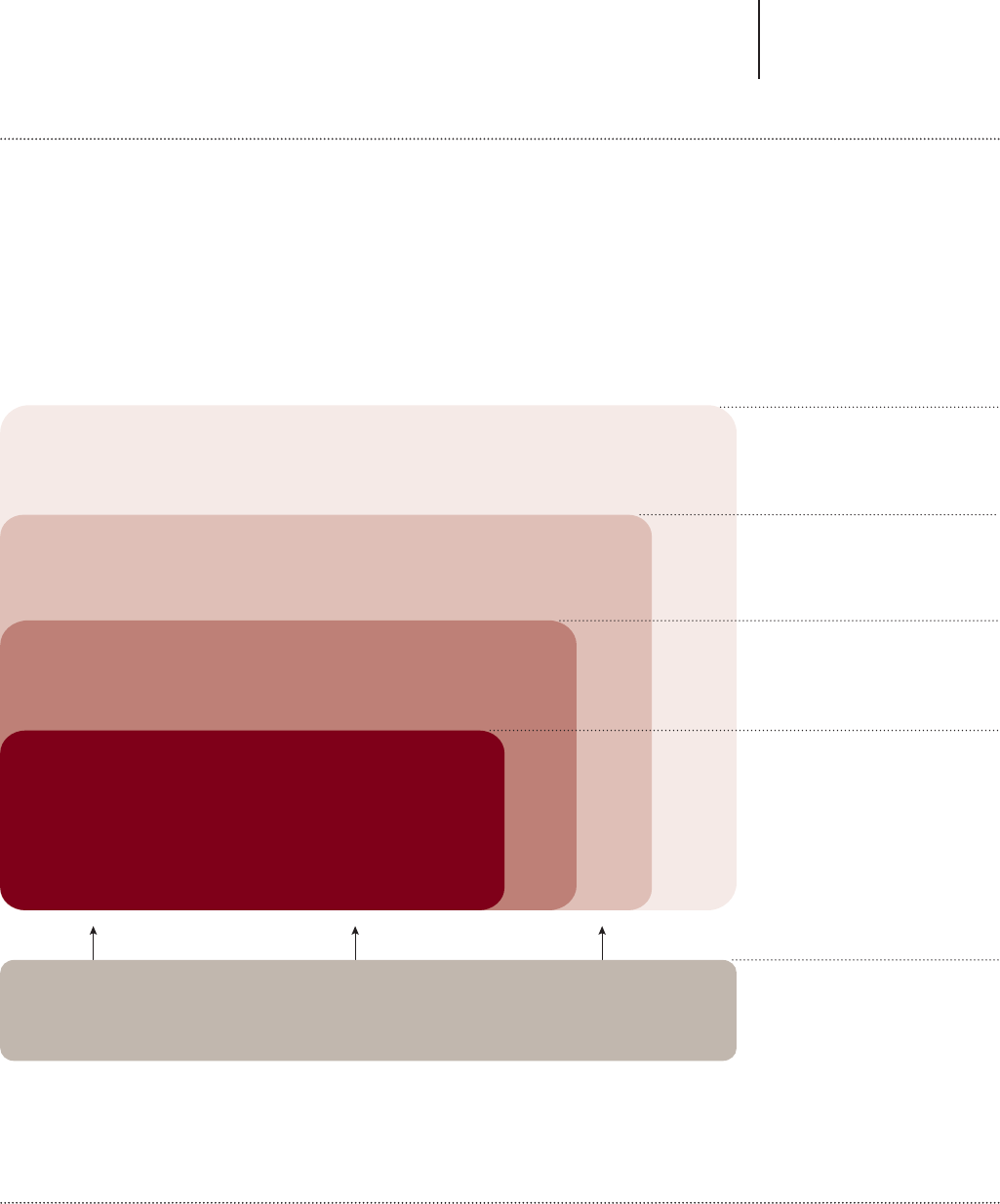
11Strategy&
part of a larger social system that includes, at the outer layer, the
culture and language of a country or region on which all creative
production is based (see Exhibit 1).
Source: Strategy& analysis
Exhibit 1
The creative industries defined
The study focuses on the largest end-user-directed creative industries
Culture and language
Denition of focus sectors
Description
Creative ecosystem
– Organized creative industries,
directed toward businesses
as well as individuals
– Overall environment of
people in a local culture/
country (e.g., language)
– Unorganized creative
production (e.g., blogs)
– Organized creative industries,
mostly profit-oriented
– End-user-directed creative
industries in the larger
information and entertainment
business
– Enabling industries that
support the distribution and
monetization of creative
content (e.g., ad sales)
Enabling industries
Organized creative industries
Creative industries in focus:
Film and television
Periodical print publishing
Book publishing
Music
Gaming
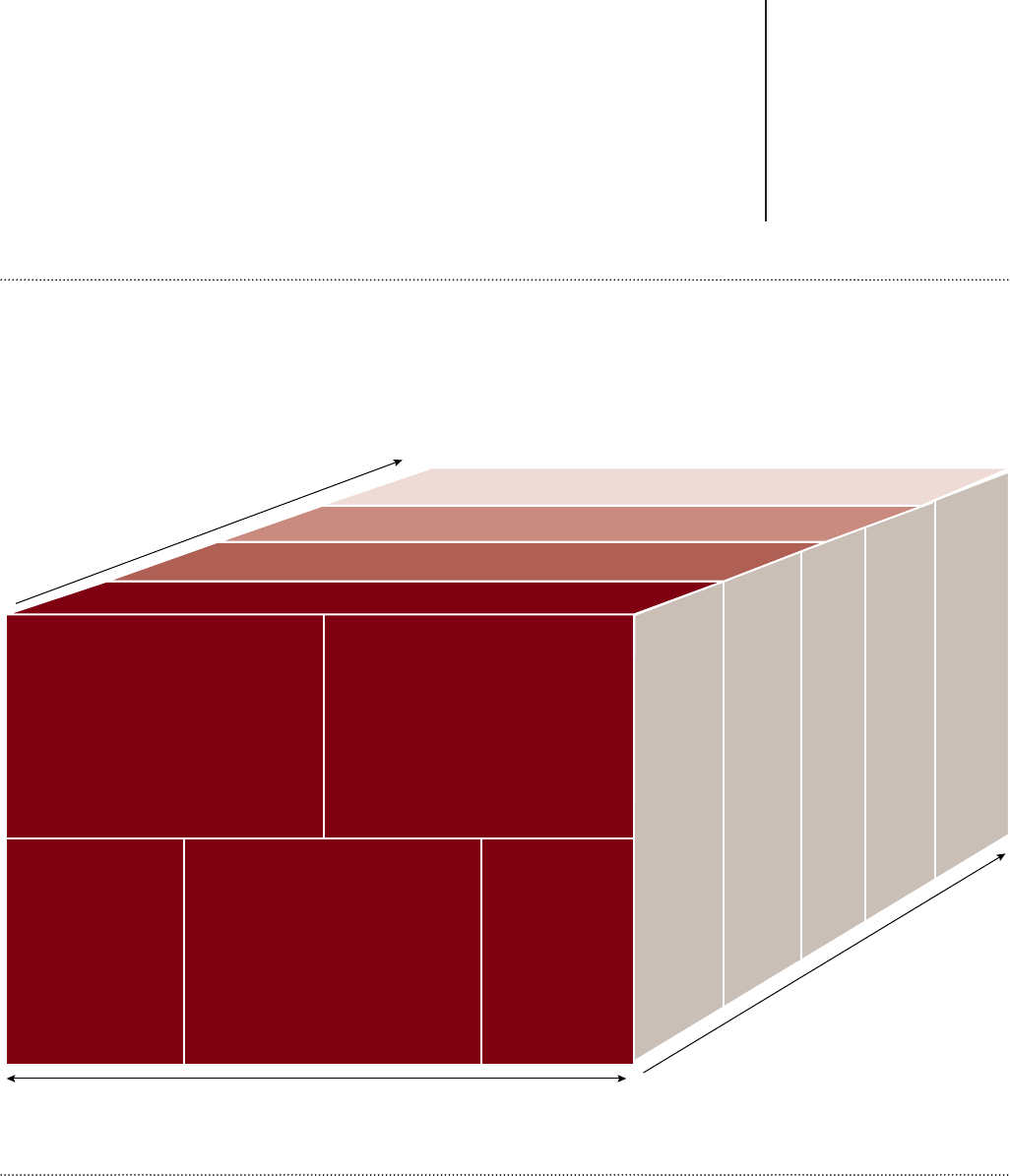
12 Strategy&
This definition explicitly leaves out the live performing arts and sports
events, fine arts such as painting and photography, and any B2B-
directed creative production, including product design and architecture.
Moreover, although the creative sector is supported by numerous
“enabling industries” such as advertising agencies, search engines,
and social media, these providers are also excluded from our definition
(see Exhibit 2). Thus, we include advertising-supported media, such as
television and online newspapers, but not the advertising industry itself.
Source: Strategy& analysis
Exhibit 2
Our focus industries across the value chain and platforms
Videos
(television, film)
Music
(radio, recorded music)
Books
Print
(newspapers,
magazines)
Gaming
Creation
Production
Distribution
Consumption
Creative industries
Value
chain
Delivery
platforms
Traditional
(offline)
PC
Mobile
Tablet
Set-top
box

13
Stages of Internet evolution
To study the many dierent ways the Internet has aected the creative
sector, we selected five countries, at varying stages in the process of
digital evolution. Specifically, we classified those countries into four
categories based on their level of traditional media reach and Internet
connectivity. Traditional media reach— the level of penetration of
traditional content distribution platforms such as television and print
into a market’s households— allows us to understand the accessibility
of content in each country without the Internet. Connectivity is
measured by the level of penetration of fixed and mobile broadband and
smartphones across the market’s population (see Exhibit 3, next page).
These are the four stages we identified.
• India is a next-generation market. It features low fixed broadband
and smartphone penetration, and its level of traditional media
distribution is not particularly strong. However, high and increasing
mobile broadband penetration— 73 percent in India— is vastly
improving the ability of consumers to access informational,
entertainment, and educational content and fast-tracking the
growth of the country’s creative sectors overall.
• Thailand is in the transitional phase, having reached a more
developed state of Internet connectivity. Fixed and mobile broadband
connections and smartphone penetration are at acceptable levels,
and traditional media distribution is strong. As such, the Thais
benefit considerably from the tools required to consume creative
content both through traditional means and on digital devices.
• Japan is fully equipped for digital, as is Australia in its major urban
areas (Australia’s more remote communities fall more closely into the
transitional stage). These markets enjoy highly developed fixed,
mobile, and smartphone penetration that allows their people to
consume high-quality, high-resolution content.
• Finally, in hyper-connected South Korea, digital is in the population’s
very DNA. South Koreans are among the largest consumers of digital
creative content in the world, and can access ultra-high-resolution
videos and games anywhere, anytime, and anyhow.
Overview of each creative sector
The impact of the Internet on each of the five creative industries has
been uneven. Although video remains the largest creative sector in
terms of revenue, the gaming sector has been the largest contributor to

14 Strategy&
1
Based on the average
of fixed and mobile
broadband penetration and
smartphone penetration.
2
Based on the maximum
penetration of TV and
newspaper per household.
3
Represents digital media
size per connected Internet
user.
Source: Informa Telecoms;
WBIS; Strategy& analysis
Exhibit 3
Internet maturity and media penetration
Transitional
digital markets
Digital
DNA
markets
Next-generation markets
Low smartphone
penetration (below 10%)
Medium smartphone
penetration (10%–50%)
High smartphone
penetration (above 70%)
Nascent Developing Mature
Medium
Penetration of traditional
media 20%–60%
High
Penetration of traditional
media above 60%
Low fixed broadband
penetration (below 10%)
Medium fixed broadband
penetration (10%–50%)
High fixed broadband
penetration (above 70%)
Digital media size
3
Focus countries’ stages of Internet evolution, 2015
Digital-equipped
markets
South
Korea
AustraliaJapan
India
Thailand
Traditional media
reach, 2015
2
State of Internet connectivity, 2015
1

15
the growth of creative content. Across all five countries between 2011
and 2015, gaming, mainly driven by digital, has been growing most
rapidly, at 13 percent per year. Video and books have been growing at
4 and 1 percent per year, respectively, while music and print have each
dropped 1 percent.
2
(These numbers combine both digital and non-
digital content.) A closer look at each industry explains why.
Video. Traditional platforms such as satellite and cable TV remain
the dominant sources of revenue coming from creative content, while
revenues from digital video content have not yet reached their full
potential across all five countries. Still, viewership of online and mobile
videos is soaring. Internet TV platforms have already had a significant
impact, increasing the breadth of content oered and providing the
ability to upload content, both professional and user-generated. Interest
in short-form content (on sites such as YouTube, Vine, and Dailymotion)
is booming, while short- and long-form premium content (films and TV
series) is increasingly available at aordable prices on so-called over-
the-top platforms such as Netflix and Hulu that carry their data over
traditional telecom networks. For linear TV channels, dual screening
and multi-platform experiences have become a must to retain and
engage a highly connected audience.
Already, many broadcasters have expanded their revenues by following
their consumers online. They have successfully introduced a variety of
new business models to make money from their content and create new
experiences, and such innovations will continue to drive the industry’s
growth. The digital landscape is also allowing for the emergence of
niche video producers bringing non-mainstream content to audiences,
thanks in part to a growing ecosystem of players oering support, from
production and funding through to distribution.
The revenue contribution from digital TV remained low in all markets
in 2015, varying from just 1 percent of total video revenues in Thailand
to 5 percent in Japan. Going forward, digital videos, including TV and
home entertainment, are expected to fuel the overall video industry
growth at annual rates between 16 and 25 percent from 2015 to 2020.
3
Periodical print publishing. The Internet has had a huge and in many
ways disruptive impact on periodicals, which continue to experiment
with new ways to extract value from digitization. Although demand for
news in general has been on the rise, how people consume it is changing
fast. Younger people typically don’t consume news in print or on TV, and
are much more likely than people over 45 to get their news through
mobile devices and social media.
4
This suggests that traditional news
providers should be able to capture more value if they can develop truly
appealing digital ecosystems and innovative business models.
Although
demand for
news in general
has been on the
rise, how people
consume it is
changing fast.

16 Strategy&
In countries with more mature digital capacity, traditional news-
oriented business models are increasingly shifting from a platform focus
to a content focus: People get their news from multiple formats— from
TV and newspapers to publishers’ websites, citizen journalism sites such
as the Hungton Post, blog sites like BuzzFeed, and, increasingly, social
media networks (Facebook, Twitter, and others) and mobile apps.
Periodicals at a global level have seen revenues and profits decline, but
are now experimenting with new business models and revenue streams.
The five markets in our study have been facing this decline at dierent
intensities: The drop has been strongest in the digital DNA and digital-
equipped markets. The Australian newspaper industry has seen annual
revenue losses of 3 percent between 2011 and 2015; in South Korea and
Japan, the industry has lost around 1 percent per year. Thailand, which
is in the transitional phase, witnessed a stable growth of 0.5 percent per
year. In next-generation markets, however, digital has not yet disrupted
the print players; India has seen annual growth of 4.8 percent.
5
Several studies have assessed the role of each media platform across
each step of the news consumption journey. They have found that
discovery increasingly occurs on social media or through a publisher’s
breaking-news app. News amplification occurs on social media and
forums, while validation and investigation occur only on the most
credible publishers’ branded sites.
Print publishers have great assets with their established brands and
existing content capabilities. The future success of print media
businesses will depend on their ability to continuously create relevant
consumer experiences that utilize their unique strengths and the
perceived credibility of their brands to more eectively leverage their
existing assets.
Book publishing. This will be the next industry to be fully
revolutionized by digitization. Up to now, the financial impact on books
in the countries we studied has been small, but that, too, will change.
Revenues for physical books are growing or stable in all five of our
countries, and the share of digital revenues was still only about 15
percent in 2014. South Korea is at the upper range of digitization, with
e-books contributing a 24 percent share of sales in 2014, while next-
generation markets such as India are still hovering around a 2 percent
share.
6
Traditional publishers in every market are moving online to oer larger
book libraries and the convenience of home delivery, while also
distributing hard-copy editions. The Internet has become a supplement to
traditional book retailers, which use it to drive trac to their bookstores,
acquire new customers, and promote their brands and products.

17Strategy&
While traditional bookstores are increasing their focus on online
distribution, book aggregators and e-readers such as Amazon’s Kindle,
Apple’s iBooks, and Google Play Books are entering the e-books market
in Asia-Pacific. As a result, the number of e-book releases in Japan has
increased from 260,000 in 2011 to more than 1 million in 2014. This
development oers consumers a large range of books that are easily
carried, are aordably priced, and can be stored in large numbers.
The new phenomenon of self-publishing is also emerging in the form of
platforms that nascent writers can use to publish their work, gain access
to a community of readers with whom they can interact, and leverage
an end-to-end publishing solution from content preparation to storage
and delivery to billing. In Thailand, for example, authors who self-
publish capture 70 percent of the revenues from sales, compared with
just 10 percent for traditional authors (see Exhibit 4).
Electronic gaming. The electronic gaming industry has reaped
extraordinary rewards from the Internet. Enabled by a higher-
performance broadband infrastructure, online and mobile games have
been fully embraced by the industry and across all age groups. The
emergence of new gaming platforms such as Facebook, the iTunes Store,
Google Play, YouTube Gaming, and many others has also reduced
Source: PwC’s Global
Entertainment and Media
Outlook; interview with
manager at TCDC; Forbes
Thailand; Strategy& analysis
Exhibit 4
Financial benefits of self-publication
70%
45%
30%
10%
15%
30%
Online book
distribution
Traditional book
distribution
Publisher
Distributio
n
Production
Author
Revenue allocation from books in Thailand

18 Strategy&
barriers to entry for game publishers, thanks to lower distribution costs
and the lower production requirements of producing social games.
The shift in platforms is also attracting new consumers who might not
have used a console but will spend time playing games online or on a
mobile device because it is convenient. In fact, although users of casual
games would not call themselves “gamers,” they end up spending more
time playing than hard-core gamers.
Globally, games have rapidly become one of the largest paid-content
categories online, thanks primarily to the growing preference for
“freemium” models, in which the basic app is oered free but additional
options are available for a price. In fact, freemium-based models,
featuring either in-app purchases or desktop-game micro-transactions,
have been growing more rapidly than the overall gaming market
everywhere. Freemium-based games grew by an average of 13 percent
per year from 2011 to 2015 in Japan, compared with 11 percent for the
total game market, and by 21 percent per year in South Korea compared
with 19 percent for the total market. Online micro-transaction and
social/casual games, which are mainly based on freemium models,
contributed 73 percent and 91 percent to Japan’s and South Korea’s
gaming revenues, respectively, in 2015.
Music. The market for paid music has been experiencing a revival over
the past decade or so, thanks to live music events and the success of
legal international distribution platforms such as iTunes, Apple Music,
Spotify, Pandora, and YouTube, as well as many local players such as
MelOn and Mnet in South Korea. These companies have been able to
convert casual pirates to paying consumers through a value proposition
focused on content variety, accessibility, and flexible pricing. In turn,
this has fueled a revival in recorded music sales.
With the establishment of digital downloads as an alternative to
physical recordings, beginning with the rise of iTunes in the early
2000s, the economics of the industry fundamentally changed. Today,
about 66 percent of revenues from a download go to the artist and label,
compared with about 32 percent for a CD sale. The additional share for
artists and labels is coming almost entirely from the reduction in
intermediary and distribution costs as a result of the new formats (see
Exhibit 5, next page).
Music consumption patterns vary from country to country; in Japan and
Australia, for example, the culture of downloads is still dominant,
whereas in Thailand, Korea, and India, streaming is the preferred way
of listening. Overall, however, music is slowly shifting toward a culture
of “access,” rather than ownership, as streaming platforms become the
main source of music consumption. In Australia, for instance, the
The shift
in gaming
platforms is
attracting new
consumers who
might not have
used a console
but will play
games online
or on a mobile
device.
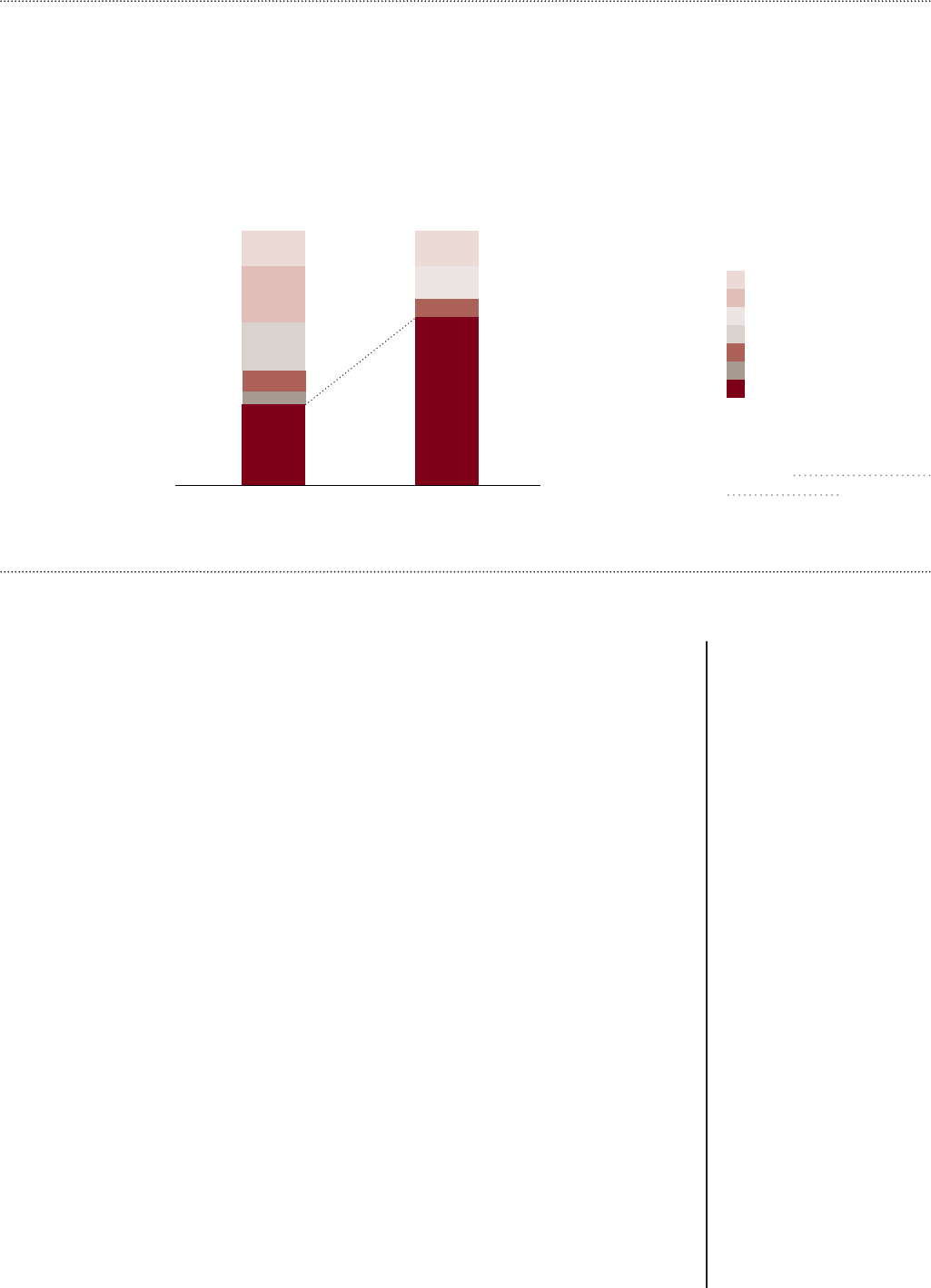
19Strategy&
streaming model grew 183 percent between 2014 and 2015 and
download services grew 90 percent. It is worthwhile to contrast these
countries with Norway and Sweden, which have the highest share of
streaming penetration. We expect the portion of revenue from
downloads to continue to decline over time in most countries worldwide
(see Exhibit 6, next page).
Streaming platforms provide both leading and nascent artists with ways
to distribute their music at limited cost, promotional platforms with
international reach, and direct channels of communication with their
fans. The shift from downloads to streaming has created its share of
controversy, however, as artists and songwriters raise concerns about
the amount of royalties they receive from their streamed music. What is
clear is that streaming is becoming an increasingly important source of
revenue for the music industry. For example, Australia grew digital
music revenues by more than 29 percent per annum between 2011 and
2015, adding AU$405 million (US$306 million) to the total of AU$2.7
billion.
7
Source: “The digital future of
creative Europe” (Strategy&
white paper, 2013)
Exhibit 5
Profit redistribution in the music business
14%
8%
5%
22%
19%
32%
14%
7%
13%
66%
CD sales Online download
Intermediary fe
e
Publishing
Distribution
Sales tax
Trade
Manufacturing
Artist and label
Profit distribution of physical sale vs. online download (% of sales price
)
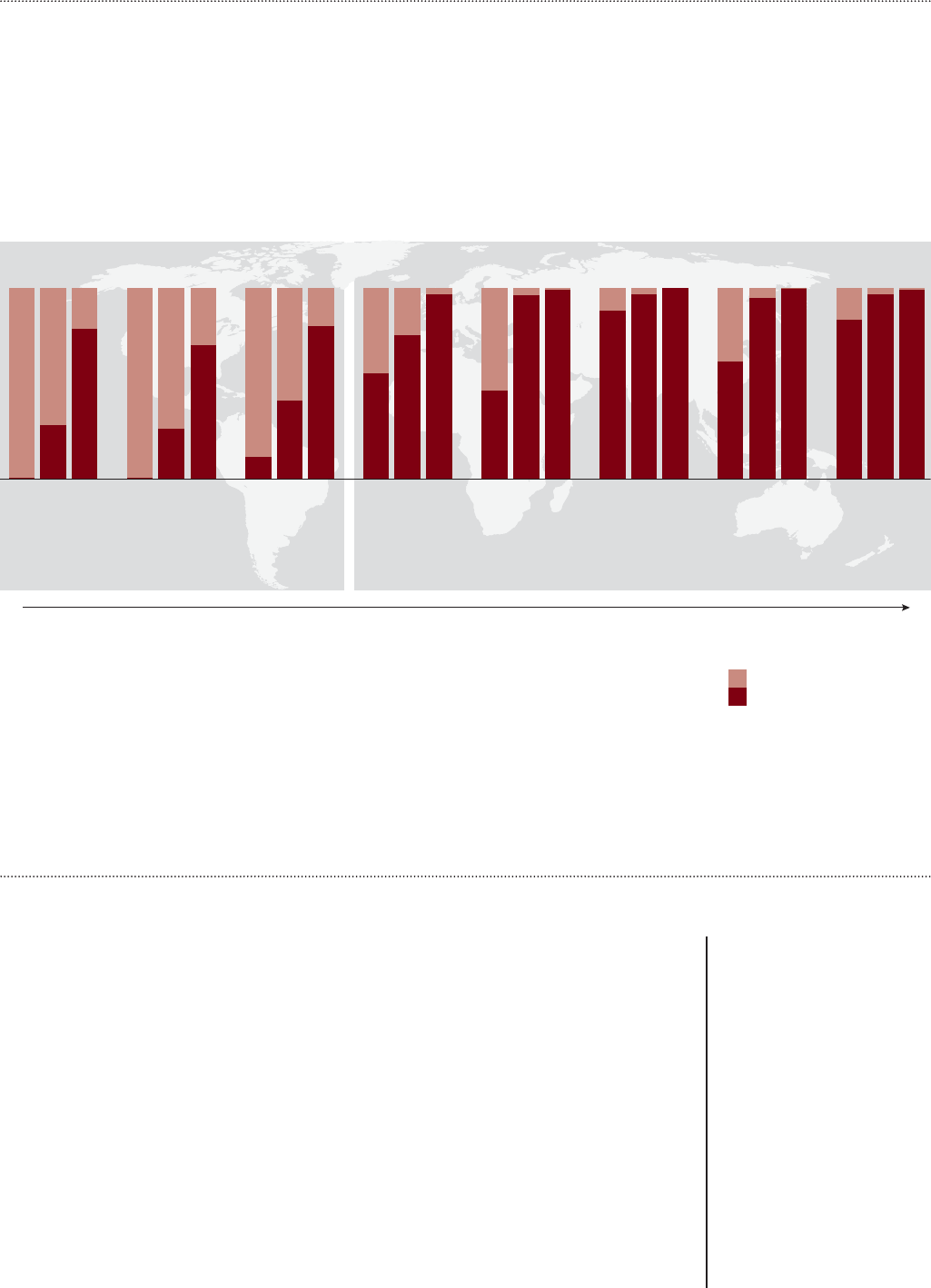
20 Strategy&
Growth in the creative industries is digital
As dierent as the countries and creative industries we studied are, six
common themes unite the overall eect of the Internet on the creative
sector and on these countries’ economies as a whole.
1. The time spent consuming creative products is increasing.
Consumer media usage is growing across every country in our study,
from those with relatively low Internet penetration to those with
penetration rates close to 100 percent. The amount of time devoted to
oine and online media consumption has increased fastest in countries
Source: PwC’s Global
Entertainment and Media
Outlook; Strategy& analysis
Exhibit 6
Increase in music streaming
Digital music market revenues by downloads vs. streaming
(select countries in US$ millions)
Streaming markets —
culture of access to music
Download markets —
culture of music ownership
Australia U.S.Japan Norway SwedenSouth Korea
2020F
99%
1%
2015
96%
5%
2011
61%
39%
2020F
100%
59%
2011
12%
88%
2020F
70%
17%
2020F
99%
2015
95%
2020F
99%
4%
2011
46%
54%
2020F
97%
1%
2015
97%
3%
2011
83%
30%
2015
27%
73%
2011
1%
99%
2020F
79%
21%
2015
29%
71%
2011
1%
99%
12%
2015
97%
3%
2011
88%
45%
2020F
80%
20%
2015
41%
3%
2015
75%
25%
2011
55%
General trend
Thailand India
1%
Music streaming
Music downloads
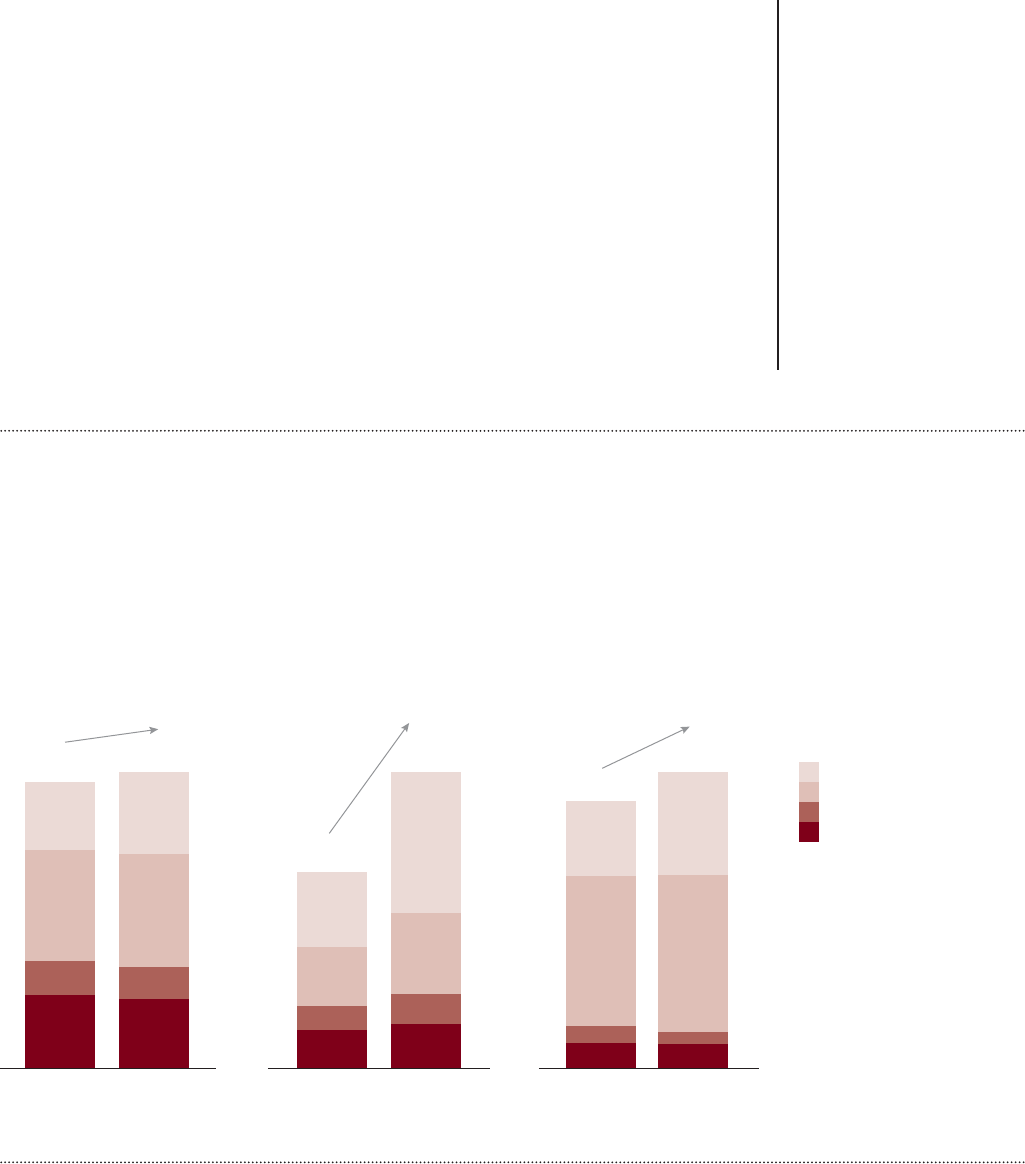
21Strategy&
with strong Internet penetration, such as Australia and South Korea
(see Exhibit 7).
• The increase in time-consuming media is the highest in Australia,
up from 6.4 hours per day in 2011 to 9.7 hours in 2013, an annual
increase of 11 percent. That increase is occurring without
cannibalizing users’ consumption of traditional TV, radio, and print.
TV consumption increased by 13 percent from 2007 to 2013, and
consumption of print media rose 7 percent during the same period.
• Online video consumption in India doubled between 2011 and 2013,
while traditional viewing platforms such as TV and cinema
continued to grow in popularity.
Note: Results of
calculations may not be
exact due to rounding.
Source: Brand
Connections; Nielsen and
Videology 2014 report;
Statista (from GroupM);
Newswire, 2014
Exhibit 7
Increased time spent on media, by country
Print
Internet
TV
Radio
Thailand
Time spent on media
(hours per day)
23%
2010
12%
39%
9
26%
28%
11%
9
2014
38%
23%
+1%
Australia
Time spent on media
(hours per day)
30%
38%
9%
16%
6
47%
27%
2007
11%
21%
2013
10
+7%
South Korea
Time spent on media
(hours per day)
2010 2013
8%
10%
53%
5
35%
6%
4%
56%
6
28%
+4%

22 Strategy&
2. Users are willing to pay for creative products. Some observers
question the sustainability of the Internet as a revenue source for the
creative sector, and many believe that consumers are less willing to pay
for digital products than for their physical equivalents. Indeed, this has
proven to be a challenge for news organizations. Yet sales of digital
content show that consumers, as they spend more time online, are
willing to pay for content, especially if it provides variety, is of high
quality, is aordable, and has the convenience of anytime, anywhere,
anyhow consumption.
In every country in our study, consumers are spending more on digital
creative products than ever before— from 15 percent annual growth in
Japan between 2011 and 2015 to 35 percent annual growth in Australia
for the same period (see Exhibit 8, next page, which shows data for
Thailand, Australia, and South Korea, the markets for which we had
analogous data).
The rapid international growth of distribution platforms— such as
Netflix, a TV streaming service; Spotify and Apple Music, streamers of
music; and local players such as Hollywood HD and iFlix in Thailand—
provides strong evidence of the increased willingness to pay for digital
content.
• With a flexible pricing model and a unique content library, Netflix
attracted 1.6 million sign-ups and 900,000 paying users in Australia
less than six months after its launch there, Citi Research estimates.
8
• Digital games are large drivers of online payments, particularly in
Korea and Japan, where the Internet is driving increased per capita
gaming spend for both PC and app-based games. Game apps are
leading the surge in Japan, where expenditure per capita grew by a
total of 232 percent between 2010 and 2015, mainly driven by the
rapid adoption of smartphones and tablets.
9
3. The overall value of the creative sector is increasing. As more
time is spent online and consumers can legally and more cost-eectively
access content, the overall value of the creative market is growing. In
South Korea, the Internet’s contribution to the total value of the creative
sector is particularly high— fully 35 percent in 2015— since digital is
increasingly part of most consumers’ DNA there. Japan’s and Australia’s
creative sectors are moderately digitized; their proportion of digital
media content is in line with that of other developed markets such as
the U.S., the U.K., and France.
Moreover, every country’s creative sector has been growing faster than
its nominal GDP, although that growth is faster in developing markets,
as developed markets become more mature. In South Korea, for

23Strategy&
Source: PwC’s Global
Entertainment and Media
Outlook; eMarketer;
Statista; Strategy& analysis
Exhibit 8
Payments for digital content are rising
Pay monetization by hour of usage
(in US$ per 1,000 capita for print and video, and per 1,000 Internet population for digital)
Thailand Australia South Korea
Internet
$10.4
$7.9
$36.9
$32.9
$28.3
$21.4
$411.8
$244.9
$304.1
$208.3
$77.2
$85.6
$135
$262
$116
$111
$719
$737
Print
Video
+3%
2014
2013
2010
-12% +1%
+7% -9% -1%
+7% +3% +25%

24 Strategy&
instance, while GDP increased by 3 percent annually from 2011 to
2015,
10
payments for creative content increased by 6 percent and for
digital content by 21 percent for the same period
11
(see Exhibit 9,
next page).
The creation of real value, in the form of actual revenue, however, is
moving more slowly in mobile-heavy next-generation markets, since
money made from mobile channels through advertising and content
payment still lags behind revenues from larger screens such as TV and
theaters, even though consumers spend much more time consuming
content on mobile devices. Still, digital media in all five countries grew
at double-digit annual rates, with Australia, India, and South Korea
growing at 25, 24, and 21 percent, respectively, between 2011 and
2015 (see Exhibit 10, page 26).
Overall, across all five countries in our study, the creative sector grew
at an average of 3 percent per year from 2011 to 2015, with most of
the growth coming from paid digital content (see Exhibit 11, page 27).
In fact, digital growth represents as much as 86 percent of the creative
market growth from 2011 to 2015, compared with 14 percent for
traditional content over the same period.
Total paid content also increased slightly faster than advertising, at 3.5
percent compared with 2 percent, for the same period, demonstrating
consumers’ increased willingness to pay for content. Paid content
growth represented 83 percent of the creative market growth from
2011 to 2015, compared with just 17 percent for advertising.
12
4. Entrepreneurship is on the rise. Traditional creative platforms
came with limited inventory space and high distribution costs, giving
the platforms’ owners most of the control and the lion’s share of the
revenue. The Internet has allowed independent artists and small and
medium-sized enterprises to build direct relationships with consumers
and get closer to the revenue stream.
The low costs of digital content production— sometimes requiring
little more than a smartphone— and the proliferation of distribution
platforms have opened up real opportunities for individual and small-
scale content creators to experiment with original oerings, showcase
their work, and instantaneously reach a critical mass of people. Indeed,
all five of the creative sector’s industries have witnessed a growth in
entrepreneurship, from video blogs, or vlogs, to indie music, microblogs,
self-published e-books, and indie games.
Individual creators also benefit from the availability of alternative
funding models and supporting mechanisms such as multichannel
networks (MCNs), which provide assistance to new video artists when it
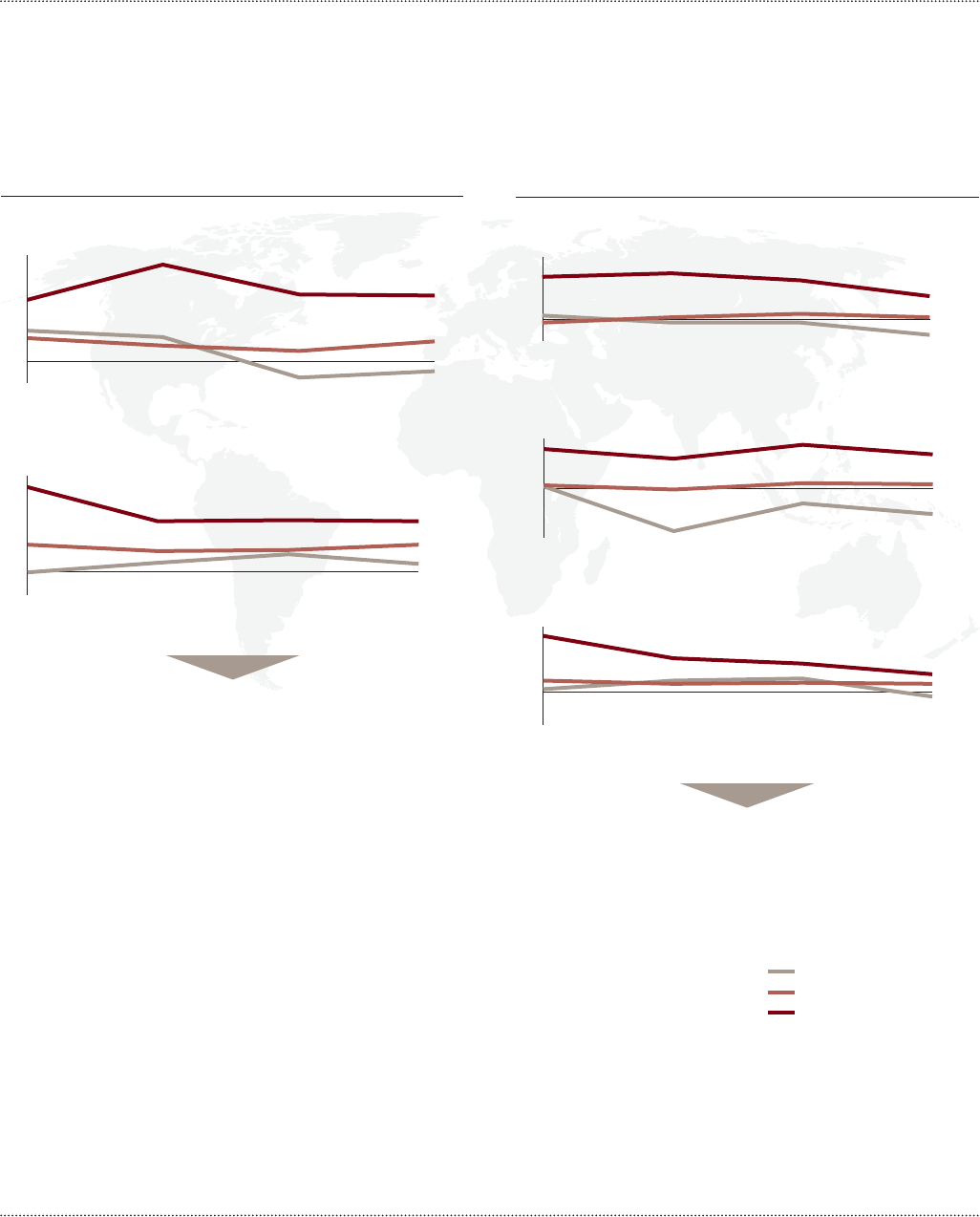
25Strategy&
Source: PwC’s Global
Entertainment and Media
Outlook; Euromonitor;
Strategy& analysis
Exhibit 9
Growth in the creative sector compared with nominal GDP
Digital media experiencing faster growth than GDP
and still growing faster or as fast as in previous years
Digital media experiencing faster growth than GDP
with growth rate slightly decreasing as market
reaches mature levels
25
15
5
-5
20
10
0
15%
5%
15%
5%
30
40
20
0
10
-10
2013–14
21%
11%
3%
2012–132011–122010–11
35%
11%
-1%
-4%
-4%
36%
44%
41%
0
40
60
20
-20
2
%
-15
%
22
%
4%
Developing countries Developed countries
-10
%
-6
%
-17
%
1
%
1
%
17
%
12
%
16
%
13
%
10
-10
20
0
7%
2%
17%
21%
34%
11%
20
0
40
2011–12
-2
%
2014–15
5
%
8
%
2012–13 2013–14
Media market
Digital media market
GDP
Thailand
India
Australia
Japan
South Korea
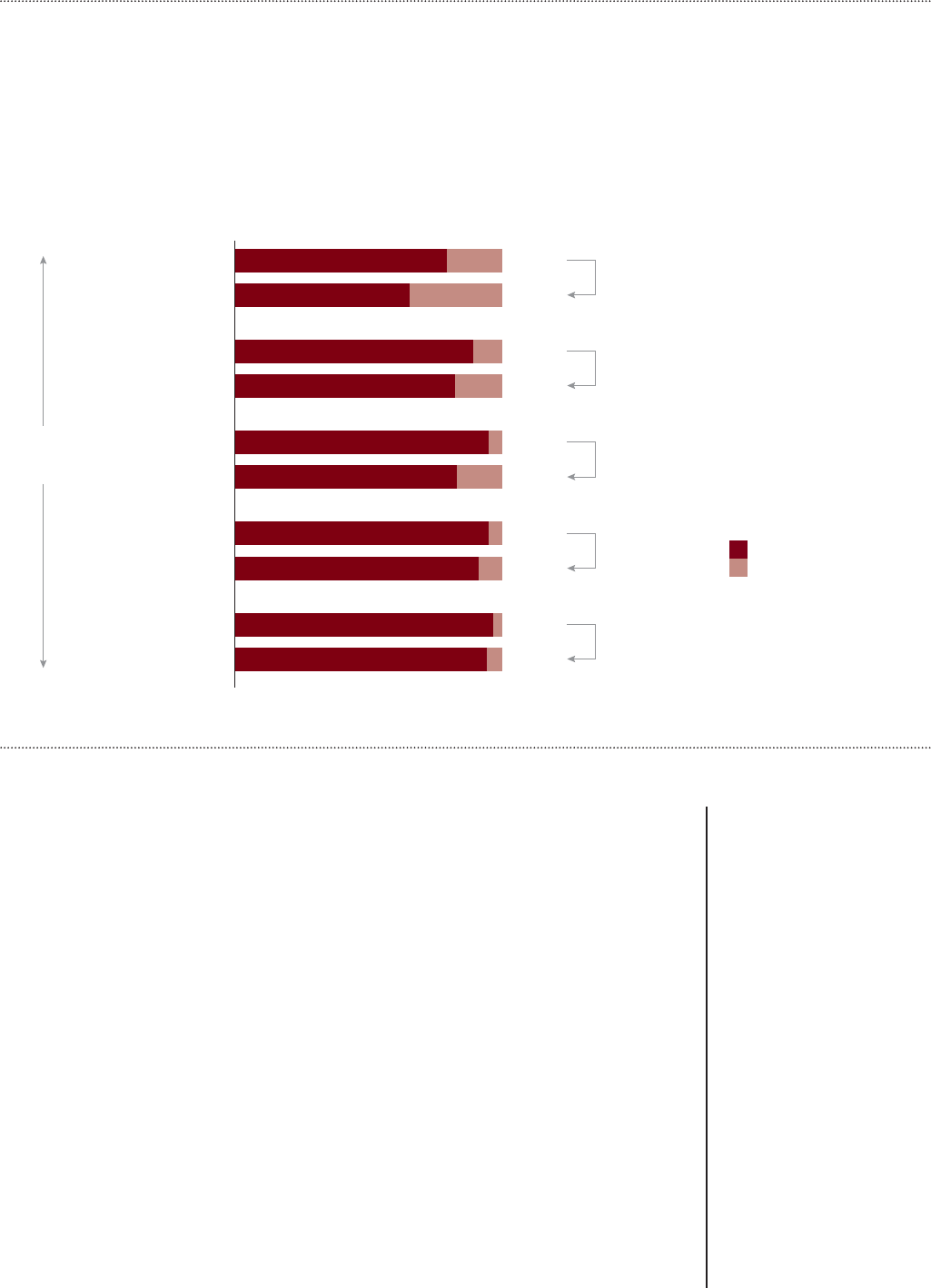
26 Strategy&
Source: PwC’s Global
Media and Entertainment
Outlook; Strategy& analysis
Exhibit 10
Digital contribution to creative sector growth
95%
83% 17%
2011
$15.9
5%
2015
$16.7
Creative
sector
digitization
15%
21%
24%
96%
94%
$13.6
4%
2015
$19.7
6%
2011
89%
82% 18%
2011
$69.9
11%
2015
$72.6
79%
65%
21%
35%
2015
$25.6
2011
$20.4
95%
91%
2015
2011
$5.6
5%
9%
$6.5
25%
17%
India
Australia
Thailand
S. Korea
Japan
Traditional
Digital
Creative sector value breakdown,
traditional vs. digital
(in US$ billions)
High
Low
Digital
content
CAGR
comes to production, distribution, monetization, and audience
development. This support helps create jobs and contribute to the
expansion of small and medium-sized businesses.
In Australia, user-generated and independent artists’ content is widely
popular; in May 2016, it made up nine of the top 10 Australian YouTube
channels, seven of which are represented by MCNs.
13
In India, in the words of the late Rajjat Barjatya, who was managing
director and CEO of Rajshri Media: “Platforms such as YouTube have
‘democratized’ the content creation process and led to the removal of
‘gatekeepers.’”
14
New entrants such as singer Shraddha Sharma now
find it easy to showcase their talent to a wide audience. Sharma’s
records had captured almost 200,000 subscribers and more than
14.4 million views by April 2016. After being discovered through
YouTube by an MCN, she signed with Universal Music and released
her first album, Raastey, in 2014.

27Strategy&
Source: PwC’s Global
Media and Entertainment
Outlook; Strategy& analysis
Exhibit 11
Growth fueled by digital and paid content
$141
81%
19%
$125
89%
11%
$141
70%
$125
69%
31%
30%
Creative sector digital vs.
non-digital breakdown
(focus countries, in US$ billions)
Creative sector ads vs.
paid content breakdown
(focus countries, in US$ billions)
Digital +18.6%
Non-digital +0.6%
Ads +2.0%
Paid content +3.5%
20152011 20152011
+3.0% CAGR +3.0% CAGR
5. Local content industries are getting stronger. A further eect of
the Internet’s ability to boost entrepreneurship and reduce barriers to
entry for independent creators is the increased supply of local content,
a significant benefit to consumers. In Australia, for example, despite
ever-expanding access to international content, trac to local sources
has risen over the past few years. In 2015, 61 percent of total trac on
the country’s top 12 sites went to local news websites, a 55 percent
increase since 2012. And according to Nielsen, the number of visitors
to “.au” websites is increasing faster than it is for “.com” websites.
15
6. Creative exports are soaring. Internet platforms have removed the
physical borders between markets and thus fueled the export of
creativity across all five creative industries. In countries where a
particular creative industry has traditionally been strong, the Internet
has enabled easier access to international markets and yielded
significant export revenues for the industry’s products.
For instance, the gaming industry in Korea took in a total of US$9.29
billion in revenues in 2015,
16
and exports accounted for a third of that,

28 Strategy&
up from a quarter just four years earlier. Mobile games have become the
key driver of the growth in exports, up 40 percent annually between
2011 and 2013.
17
Many of the new Internet-based social media stars in Australia, such as
Troye Sivan, SketchShe, and Josiah Brooks (Draw with Jazza), have
established themselves in markets across the globe. Unsurprisingly,
Australia’s cultural exports are especially popular in English-speaking
countries like the U.K., the U.S., Canada, South Africa, and New Zealand.
18
India’s HooplaKidz, an animated, Web-based children’s series, has also
reached markets around the world, eventually attracting foreign
investment. In 2015, U.S.-based MCN BroadbandTV acquired YoBoHo,
the MCN of HooplaKidz.
19
A boom for consumers
Perhaps the greatest beneficiaries of the content revolution brought
about by the Internet are consumers themselves. The Internet has given
them more entertainment avenues, more access to information, and the
ability to interact with content and its producers. As a result, consumers
spend more time on media activities than ever before. And it isn’t just
passive consumption— the Internet is enabling a whole new culture of
remixing that allows consumers to co-create content and generate their
own content. Among the benefits:
1. Increased social inclusion. The rise in digital media consumption
has significantly increased the level of social inclusion around the world,
bringing together often disparate and widely disseminated populations.
This is especially true in next-generation markets, thanks to the greater
reach and more timely sharing of content, as well as a growing number
of payment options. In these markets, a vast majority of the population
does not have access to traditional media such as newspapers, pay TV,
books, and the like. The Internet has changed the situation.
The proliferation of mobile phones has fast-tracked this phenomenon,
especially in remote rural areas, where creative, informational, and
educational content is increasingly available to communities with limited
access to traditional distribution platforms such as cable and pay TV.
• Thanks largely to the proliferation of mobile devices, more than
73 percent of rural connected users in India use the Internet for
entertainment.
20
• Content providers are designing new forms of distribution for
consumers with bandwidth limitations, including content-light
Consumers
spend more
time on media
activities than
ever before.

29
versions and oine viewing. India’s Shemaroo, T-Series, Saregama,
and Yash Raj Films, for example, are oered through YouTube’s
oine feature that is available on Android and iOS platforms.
• And Hotstar, a mobile app, allows videos to be downloaded for oine
viewing; downloads of the app drove its popularity rank in India
from number 339 to 38 just between January and May 2016, and it
reached a peak as the most downloaded app on March 31, 2016.
21
2. Mobility brings greater flexibility. The Internet provides consumers
with the ability to access creative content anywhere, anytime, anyhow.
This level of mobility and flexibility is becoming the norm in both
developing and mature countries, although mobile usage is particularly
high in developing markets, which have come to depend on more
cheaply built-out wireless infrastructure.
South Korea is particularly advanced in this regard. Consumers there
can access games through multiple devices, physical and mobile, while
mobility allows users to play music anywhere, anytime (see Exhibit 12,
next page).
Consumption of music and games on mobile devices in Korea more than
doubled between 2013 and 2014. In Thailand, dual-screening— watching
traditional and online TV at the same time— is particularly high; in 2015,
40 percent of TV consumption took place on dual screens, and that is
expected to reach 50 percent by 2020.
22
By 2014, the percentage of Thai
Internet users consuming online and traditional TV simultaneously had
reached 94 percent, with 76 percent doing so on a daily basis.
23
3. More choice. Consumers also benefit from a wide and increasing
variety of online content: Content archives are readily accessible,
content is updated instantaneously, and innovative niche and indie
oerings are on the rise. Major distribution platforms such as Netflix,
Hollywood HD, and iFlix oer an enormous menu of top TV shows and
movies as well as original content at aordable prices, while further
benefiting the sector by helping reduce the extent of casual piracy.
Niche players can enter the content market more easily, providing
previously unavailable content such as independent movies, indie music
genres, and self-published books of all kinds. Audiences also have access
to a large supply of local content, thanks in part to the emergence of local
independent artists in every genre. And audiences can gain access to the
archives of libraries and universities, as well as the content majors.
4. Increased user participation. The Internet has enabled consumers
to engage with content in a variety of ways, from ratings to uploading
videos to commenting on articles. The Internet also lets audiences form
their own communities of interest and interact more directly with

30 Strategy&
Source: “Mobile Gaming
Cross-Market Analysis”
(InMobi report, 2014);
TNS Infratest; Statista;
Strategy& analysis
Exhibit 12
Mobile usage in South Korea
Koreans’ time spent on mobile game play
(% respondents, 2014)
Music and game usage on smartphones in Korea
(% respondents, 2013–14)
47%
43%
23%
20%
12%
While
watching TV
At work/
school
While
commuting
At
home
While
waiting
Games
Music
58%
21%
18%
43%
2014
2013
+176%
+139%
artists and public figures in the news. Consumers are fast becoming
actors in the very content they consume, through online communities,
video sharing, and citizen journalism sites such as Internet giants
Facebook and YouTube as well as local players such as Kakao in South
Korea, Line in Japan, and Pantip in Thailand.
Opportunities for content majors
The community of traditional content creators— including traditional
film and TV production groups, broadcasters, record labels, and
newspaper and book publishers, among others— used to control a
large part of the content value chain, integrating the creation,
production, and distribution processes. They also aggregated content
and commissioned a large portion of the output of content creators.
Now, however, they are feeling the impact of the new forms of creation

31
and distribution enabled by the Internet, which has pushed them to
adapt by creating new business models.
New technologies are being broadly used by most of the content majors.
The Internet has revolutionized the way creators work and collaborate.
This trend is true for most markets, including the next-generation
markets. Even data-heavy film production in Bollywood is now being
put online, allowing collaborators from around the globe to access the
same video material in real time.
The Internet has also benefited these content majors in five key ways:
by giving them broader reach and a greater understanding of their
audiences (allowing them to find ways to sell content more eectively);
by facilitating closer relationships with audiences; by providing easier
access to talent; by opening up international markets; and by opening
up significant new revenue streams.
1. Greater audience reach and insights. By expanding their content
to digital platforms such as websites, online videos, and mobile apps,
and by distributing their content on third-party platforms, the content
majors have significantly increased their reach. In Australia,
newspapers have seen revenue from traditional sources, such as print
advertising, decline as a result of online advertising, and digital
revenues do not always make up for those losses. At the same time,
however, the absolute number of subscribers to content is growing,
thanks almost entirely to digital platforms. While the Australian print
newspaper audience decreased by 10 percent from 2013 to 2015, the
incremental audience online and on mobile devices increased by a total
of 50 percent during the same period, contributing to a net increase in
newspaper audiences of 7 percent.
24
TV broadcasters have also increased their audiences, primarily through
online video oerings. In South Korea, for example, TV broadcaster
MBC generated incremental revenues of $41.9 million in 2012 and
$46.8 million in 2014 from its online streaming oerings, and increased
its YouTube subscribers from 500,000 in 2013 to 4.4 million in April
2016, leading to additional incremental revenues.
25
2. Closer relations with audiences. While traditional media players in
such industries as television, newspapers, and music are accustomed to
managing the content value chain from creation and production to
distribution, the digitization of content has brought any number of
specialized players across every step of the value chain, especially in
creation and distribution. Now, however, a new, fully digitized
ecosystem architecture is on the rise, presenting great opportunities for
the traditional content majors as well. At the heart of the most
successful business models is the creation of a seamless consumer

32 Strategy&
experience and the development of a deeper understanding of, and
closer relationship with, audiences through online tools.
Thailand’s TrueVisions, a cable TV operator, for example, has been a
pioneer in integrating TV and social media, engaging with viewers on
social networks and adapting its content accordingly. Said Birathon
Kasemsri, the chief commercial ocer at TrueVisions: “Engaging with
TV audiences is better and easier with the Internet,” and “combining
event data with our audience’s habits and preferences [allows us to
significantly improve] targeting content and advertisements.”
26
3. Easier access to talent. In the past, the content majors spent
considerable amounts of time and money finding and grooming new
artists. Now, digital distribution platforms have given them much better
and more ecient access to new talent. As noted above, Universal Music
identified the young Indian Shraddha Sharma through YouTube and
signed her for her first album, Raastey. Sharma now finds it easy to
showcase her talent to a wide audience. Her records had captured
almost 198,000 subscribers and more than 14.4 million views by
April 2016.
Similarly, South Korea’s Applegirl rose to fame through her uploaded
YouTube videos, which feature her singing and playing songs by Lady
Gaga and Beyoncé. Her videos gained much interest— her Lady Gaga
video alone garnered 5.3 million views by May 2016— and facilitated
her signing with Dream High Music Entertainment as a singer and
songwriter.
4. International reach. The Internet has opened up important new
markets that leading content majors can tap into, benefiting the entire
creative sector. The independent Australian film industry, for instance,
has gained international exposure through such platforms as
Beamafilm. A promoter and distributor of independent Australian
movies, Beamafilm reaches audiences across Australia and New Zealand
as well as in the U.K., the U.S., France, Germany, and Mexico.
27
5. Greater eciencies and revenue streams. Content majors are
already benefiting from the generation of new revenue streams such as
the monetization of their digital content, the scaling of their oerings to
international markets, and the online distribution of older “long tail”
content that was not previously available digitally. Moreover, thanks to
large reductions in the cost of production, manufacturing, distribution,
and warehousing, the Internet allows content majors to operate much
more eciently. And the increased insight into their audiences helps
content majors to optimize their content costs to extract the highest
value from customers.

33
Many publishing companies have already shown that digital content
can be eectively monetized through new value propositions. Marina
Go, former general manager of Hearst-Bauer in Australia, notes, “The
Internet enables blue-sky thinking. It has unlocked a whole new world
of creativity for publishers.”
28
The company’s most popular magazine,
Cosmopolitan, has doubled its online audience since the mid-1990s,
from 1 million to more than 2 million, and now reaches a new digital
audience, many of whom are in their 20s, compared with the mid-30s
for the title’s print readership. Even as circulation and advertising
revenues decline, the company is leveraging the Internet to learn more
about its subscribers while also exploring new revenue streams such as
events and licensing.
Emerging artists: Unlimited value in a new digital ecosystem
By building a larger pipeline of creative material developed by
consumers, the Internet has created broader communities of creative
involvement, and opened up opportunities for emerging artists. These
artists benefit from open platforms, better access to funding, the ability
to reach international audiences cost-eectively, and increased support
from sources such as MCNs, which help promote artists on sites like
YouTube. Among the benefits:
1. Access to audiences. Thanks to a wide range of digital distribution
platforms and aordable technologies, new artists can reach consumers
directly by complementing or circumventing intermediaries and
gatekeepers. South Korea’s Sungha Jung, a previously unknown guitar
player, now has 4.2 million subscribers to his YouTube channel.
29
In 2009, Thailand’s Kirakorn Chimkool developed the Unblock Me app
game using a Mac Mini bought with a 10-month installment loan. Within
a few days of its release, the free version of Unblock Me became the 60th
most downloaded game in the U.S. App Store and the most downloaded
app in every category during the month of its release.
30
Since then, the
game has been released for Google Play, HTML5, and the Tizen OS. By
May 2016, it had been downloaded almost 120 million times.
31
2. Access to funding. New artists have benefited greatly from better
access to local and global Internet-based crowdfunding platforms. A
long-standing major obstacle for the “consumer-creator” model has been
access to the financing needed to make professional products that
consumers are willing to pay for. The Internet is enabling new sources
of funding that support new niche markets, where everyone can pitch
projects to the “crowd” in an eort to receive financing by multiple
(mostly small) donors.

34 Strategy&
In India, for instance, online crowdfunding platforms such as Wishberry
are contributing to the growth of local nascent creators. The rock band
Parvaaz was able to raise $4,000 in less than two months and build a
solid fan base along the way. Following the release of their album in
2014, the band was invited to perform at popular music festivals and
later toured India.
32
And Tim Lea, an independent film director and
writer from Australia, financed his sci-fi feature film 54 Days by raising
$45,000 through Pozible, an Australian crowdfunding site, in just one
month. The critically acclaimed film was made available to the public on
three video-on-demand platforms.
33
3. Increasing support from dedicated platforms. The rise of the MCNs
has added considerably to the ability of new video artists to bring
attention to their work, providing them with assistance in production,
distribution, monetization, and audience development. In fact, seven of
the top 10 YouTube channels in Australia and five in India feature new
artists supported by MCNs. Australian teen Troye Sivan emerged as an
online star thanks to the success of his YouTube channel, produced by
Boom Video, an MCN; it boasted 4 million subscribers in May 2016.
34
Time
magazine listed Sivan as one of the 25 most influential teens of 2014.
A variety of new digital distribution platforms now focus on distributing
the work of independent artists in various fields while providing them
with other kinds of support. India’s OK Listen! allows up-and-coming
Indian artists to make their songs available on its platform, while also
helping the artists create the artwork for their songs and promoting them
across online channels. The site supports more than 200 new artists.
4. Greater bargaining power. By removing the middleman from the
value chain, the digitization of Thailand’s book industry has allowed
authors to receive a larger share of the revenues from the sale of their
books— 70 percent versus 10 percent in the traditional print model—
while readers benefit from lower prices for e-books.
Like the music industry in other countries around the world, South
Korea’s music industry used to be firmly controlled by the country’s
record labels, which created and developed talent, managed the careers
of artists, and saw to all content promotion and distribution. The
Internet has increased the bargaining power of independent artists by
providing them with a platform to showcase their work and reach
audiences directly, in a cost-eective manner. (See “The changing value
chain in the South Korean music industry,” page 36.)

35
New dynamics brought by the Internet
Digital models, driven by the proliferation of the Internet, are fueling a
renewed growth in creative sectors. Increasingly, the power is shifting
to consumers, who decide what they want to make, what they want to
consume, and how and when they want to consume it. This change has
been the primary driver of innovation and investment in creative
sectors. Succeeding in this digital environment requires a dierent
approach and recipe than in the past. Players that have managed to
adopt these new models have benefited from this growth.
Although this report focuses on the impact of the Internet on creative
sectors, the Internet is a powerful tool that has had a significant impact
on society as a whole. As transformative as the Internet is to individuals’
lives, it also creates new economic opportunities. The expansion of
Internet activity has stimulated economic expansion, job growth, and
poverty reduction (especially in developing countries).
The Internet’s impact on the creative sector follows a similar evolution.
The penetration of mobile broadband increased at a compound annual
growth rate (CAGR) of 5 percent and smartphones by a CAGR of 31
percent from 2011 to 2015 across the five countries, and the digital
creative sector grew at a rate of 7.5 percent during this period. In
aggregate, 84 percent of the $15 billion in revenues added to the
creative sector can be attributed to digital. Consequently, the digital
share of the total creative sector in these countries increased from
11 percent to 18 percent in the same period.
Consumers have embraced the digital world. They are spending more
time consuming creative products. The quantity and relevance of
creative products have increased steadily, and the barriers to becoming
a creator have been lowered. Consumers are actively engaged in the
creation of content themselves, with many reaching global audiences.
New creators and companies that have emerged are providing locally
relevant content in new genres, adding to the variety of local content.
In developing nations such as India, the Internet is also driving
social inclusion by enabling consumers in remote areas to access
informational, educational, and entertainment content for the first time.
While the demand for creative content is increasing, it is also
fragmenting. Traditional media players must now compete with purely
digital brands and platforms for the time and attention of the consumer.
In this world, traditional oine media strategies will be very hard to
defend. Agility and speed are as important as size, often favoring new
players. Cannibalization of traditional revenue streams and fear that
their current assets will be devalued have been holding back some of
the established players. New propositions, frequently led by technology,
While the
demand for
creative content
is increasing,
it is also
fragmenting.

36 Strategy&
need to be launched rapidly, tested in the market, and adapted quickly
based on consumer feedback. This approach can be challenging,
especially in large corporate settings. But as long as the consumer
benefits and spends more time with media, the creative sector will find
a way to thrive. Many new digital media possibilities will not replace
old media channels but rather augment them.
We are in the early stages of digitization of the creative sectors. The
evolving digital ecosystem in creative sectors will be much more fluid,
but it will also present abundant opportunities for all players. We expect
the Internet to contribute $15 billion more to the creative sectors of the
five countries in the next five years. Traditional players that are able to
embrace the new models, in the same way that consumers have, stand
to benefit immensely.
The changing value chain in the South Korean music industry
The Internet has already had a significant
impact on the music industry in South
Korea, which had long been controlled by
just a few major record labels that tightly
managed every aspect of the business.
Exhibit A, next page, illustrates how the
industry used to be organized, and how
that’s changing under the influence of the
Internet. Traditionally, labels controlled
content creation and talent discovery,
auditioning, hiring, grooming, and
training the artists, and then producing,
marketing, and distributing the music.
Without a contract with a record label,
artists found it very dicult to get
exposure for their music. Distribution and
sale of CDs was the largest revenue stream
for both the large and small record labels.
The barriers to entry for new artists
have dropped, thanks to lower costs
of production, distribution, and
promotional methods such as viral
marketing. And because the Internet
oers transparency into an artist’s
popularity, talented newcomers now
have easier access to funding from record
labels. The user feedback available on
various platforms such as social media
allows artists to adjust their styles and
songs based on that information.
For record labels, costs are lower,
audience reach has risen, and they can
find new artists more easily through
techniques such as online video auditions
and metrics such as hits and downloads.
Meanwhile, revenues no longer have to
be split with CD manufacturers.
Smaller labels in South Korea, however,
face a more dicult environment. The
commissions they must pay to the top
music distribution platforms are actually
higher than the cost of producing CDs
and DVDs, and top artists, who can
demand a higher percentage of sales,
often prefer signing contracts with the
large record labels.
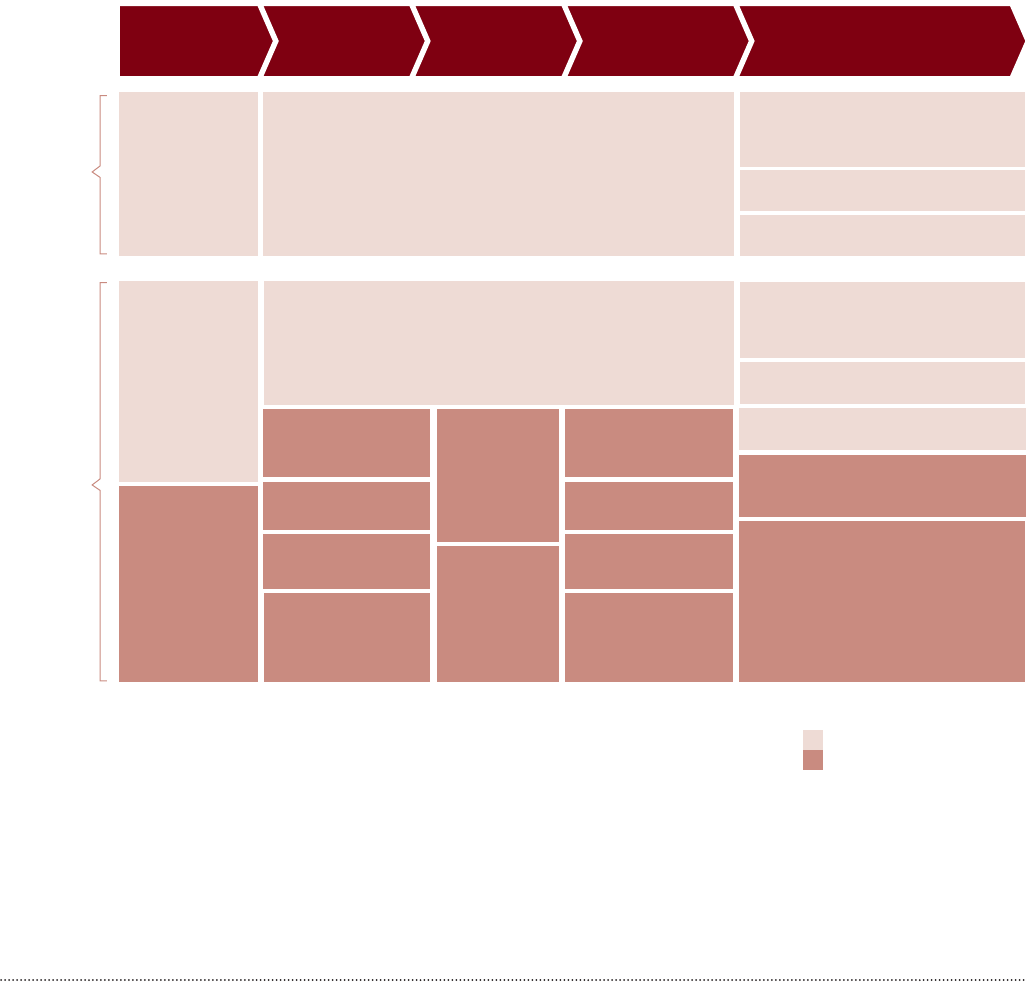
37Strategy&
Traditional process
Online process
Content
creation
Talent
discovery
Production Marketing Distribution/monetization
Professional
artists groomed
by record labels
Traditional record labels
Major South Korean record labels audition, hire, groom,
and train talent, then produce music and market and
distribute it to consumers, monetizing it through
brick-and-mortar outlets as well as concerts
CD/DVD sales in
physical stores
Concerts
Merchandise
Traditional record labels
(e.g., S.M. Entertainment, YG Entertainment)
Digital
labels
Self-
production
CD/DVD sales in physical
and online stores
Concerts
Merchandise
Artist websites and/or
dedicated apps
Online music
distribution platforms
(e.g., Olleh Music, MelOn, Mnet)
Digital marketing
platform (e.g.,
PMC Musical)
Artist website
(e.g., A-Ble)
Social media
(e.g., YouTube)
Online music
distribution
platforms
Independent
artists
Traditional
model
Internet
model
Professional
artists groomed
by record labels
Digital marketing
platform (e.g.,
PMC Musical)
Artist website
(e.g., A-Ble)
Social media
(e.g., YouTube)
Online music
distribution
platforms
Source: Interviews with
large and medium-sized
record labels; Strategy&
analysis
Exhibit A
A changing value chain: South Korea’s music value chain before and after the advent of the Internet

38 Strategy&
Chapter 1
Japan: Growth in a contracting
economy
Although Japan’s overall economy continues to struggle— it contracted
by 9 percent yearly between 2011 and 2015— its media sector actually
grew annually by 1 percent over the same period, to $73 billion in total
revenue, and is expected to continue to grow through 2020. Much of that
increase has and will continue to come from the rapid growth of digital
content. In 2011 digital content made up 11 percent of the overall sector’s
total revenues; by 2015 that proportion had reached 18 percent, and by
2020 it is expected to rise to 25 percent (see Exhibit 13, next page).
Trends shaping Japan’s creative market
The digital share of Japan’s total creative sector revenue is quite high,
and compares favorably to that of India (6 percent), Thailand (9
percent), and Australia (17 percent). Only South Korea’s digital sector is
significantly more developed, at 35 percent. The strength of Japan’s
digital media sector is largely attributable to its high level of fixed
broadband penetration (76 percent), mobile broadband penetration
(119 percent), and smartphone penetration (77 percent) in 2015.
Driven largely by broadcast TV, Japan’s video market is still the largest
contributor to its overall creative sector. In fact, Japan is the largest TV
advertising market in the Asia-Pacific region, and it is expected to
remain so until 2020 and beyond. At 2 percent annual growth between
2015 and 2020, Japan’s TV market is expected to reach $24 billion in
2020. The home entertainment portion of the video sector is expected
to grow revenues at a slow but steady 1 percent annual rate between
2015 and 2020, reaching $6 billion in 2020. Local box oce content is
key for audiences in Japan, in which nine of the top 20 movies of 2015
were Japanese-made.
Digital compensates for traditional sector revenue decline. Japan’s
digital creative sector is projected to grow at 11 percent during this
decade (2011–20) to reach $19 billion by 2020. The growth in digital
content has more than compensated for the decline in revenues on
traditional platforms and is expected to continue to do so.

39Strategy&
Note: Results of
calculations may not be
exact due to rounding.
Source: PwC’s Global
Entertainment and Media
Outlook; Strategy& analysis
Exhibit 13
Strong growth in Japan’s creative content sector
Japan’s media market size by sector
(per capita gaming expenditure in US$ billions
)
CAGR
(2011–20F)
+1%
+1%
2011
$70
34%
33%
14%
10%
9%
2020
(forecast)
$78
39%
26%
13%
17%
-3%
2015
$73
35%
29%
13%
14%
8%
-1%
+3%
+0%
+7%
-3%
2011
$8
3%
8%
11%
65%
13%
2020
(forecast)
$19
12%
15%
13%
57%
4%
2015
$13
11%
13%
10%
62%
5%
CAGR
(2011–20F)
+16%
+32%
+13%
+9%
-3%
Japan’s digital media market size by sector
(in US$ billions)
+15%
+8%
Books
Print
Video
Music
Games

40 Strategy&
Japan’s digital media sector is dominated by online gaming, which will
likely continue to take in more than half of all digital revenues through
2020, owing to its consistent growth rate of 9 percent. In fact, Japan’s
online gaming industry is among the largest in the world, and it’s driven
by the growth of social gaming, which made up 52 percent of the
gaming market in 2015.
World’s largest app-based gaming market. In recent years, Japanese
gamers have shifted in huge numbers from playing games on consoles,
PCs, and handhelds to playing them on smartphones, and now games
played on smartphones account for 70 percent of all game-related
spending. Much of that comes from the so-called in-app purchase
of upgrades to popular free-to-play titles. The result is that Japan
accounts for a quarter of the worldwide $24.9 billion smartphone
gaming market, which explains the growing interest in the Japanese
market by foreign developers such as Europe-based King and
Supercell, which have brought local versions of Candy Crush and
Clash of Clans, respectively, to Japan. Today, Japan leads the globe
in terms of per capita gaming expenditure on app-based games (see
Exhibit 14, next page).
Digital platforms have come to provide virtually all the growth in
Japan’s creative sector. In the following sections, we analyze key
benefits of the shift to digital platforms, including the emergence of
indie creators across creative sectors, the role of smartphone-based
digital communities in stimulating growth, use of the Internet by
content majors to drive eciencies and larger audiences, and the
Japanese passion for games and other digital creative content
successfully crossing international borders.
The rise of the independents
Thanks to the rise of digital distribution platforms and the power of
crowdfunding, many new independent artists have emerged across
numerous creative sectors, including games, music, and educational
content.
New gaming channels. Traditionally, independent game makers in
Japan struggled to release their new games on console players, because
the console manufacturers exerted full control over the games they
allowed on their machines. But the increased prevalence of digital
distribution platforms such as Steam, the App Store, and Google Play
has allowed the independents to distribute and sell their games without
having to negotiate costly deals with the console publishers. These
platforms are an easy way for indie game makers to release their
creations with minimal distribution costs, and new titles pop up

41Strategy&
Source: PwC’s Global
Entertainment and Media
Outlook; Strategy& analysis
Exhibit 14
Per capita gaming expenditure on app-based games
China
+13%
Increase
U.S.
-2%
France
+0%
South Korea
+8%
Japan
+3%
Gaming expenditure per capita
(in US$)
$4
$6
$46
$43
$43 $43
$54
$60
$70
$93
2015
2011
China
+13%
% CAGR
U.S.
+2%
France
+5%
South Korea
+4%
App-based gaming expenditure per capita
(in US$)
$1
$2
$4
$4
$3
$4
$14
Japan
+6%
$18
$7
$8
2015
2011

42 Strategy&
regularly. Their popularity has allowed local platforms such as Playism
to emerge and even expand beyond Japan.
Two examples stand out: Downwell, a 2D platform game for mobile
devices, was developed by the independent developer Ojiro Fumoto.
The game was picked up by Devolver Digital, a U.S.-based game
distributor, after it saw a picture on Twitter and reached out to the
developer. Devolver Digital published the game in 2015, and made
it available on PCs as well as iOS and Android devices. Similarly,
Astebreed was developed by a company called Edelweiss, a developer
of social games that has been active since 2005. The game was first
distributed on Playism’s platform, and more recently released on
established platforms such as Steam, PS4, and Vita.
35
Money from crowds. Among the driving forces behind the increased
success of independent game makers is crowdfunding, a real alternative
to traditional funding, which small-scale game developers struggled to
gain access to. Popular global crowdfunding platforms like Kickstarter
and Indiegogo have often featured Japan-based projects— and now local
alternatives like Campfire and Shooting Star are entering the market.
For example, Inafune, the co-creator of thepopular Mega Manseries of
games, chose Kickstarter to raise funds for his new project, called
Mighty No. 9. The project hit its goal of $900,000 in less than 24 hours.
On a smaller scale, indie developers Team Grand Slam chose Campfire
to help fund Monken, which became the first Japanese indie game to be
successfully crowdfunded on a Japan-only platform. Although the
amount raised is relatively modest— just $25,000— it’s the largest
ever raised for a game on the platform.
New music on YouTube. As we’ve seen in other countries, YouTube has
become a hotbed of activity among undiscovered young musical talents.
Japanese beatboxing is a musical form in which performers vocally
imitate percussion machines. Hikakin, perhaps the most popular
beatboxer, first joined YouTube in 2006, and by May 2016 boasted 1.8
million subscribers to his YouTube channel; he has collected more than
381 million views. In 2011 he created the HikakinTV channel, which
has 3 million subscribers and 2 billion views, and in 2013 he launched
HikakinGames, which had 2 million subscribers and more than 1.2
billion views by May 2016. By then, Hikakin’s soundtracks had become
so popular that they were made available on iTunes.
Cultural content on YouTube. Born in Japan and raised in the U.S.,
Chika Yoshida returned to Japan as a young woman and soon became a
Japanese YouTube celebrity through the videos she creates to teach
English to the Japanese. She calls herself Bilingirl (i.e., “bilingual girl”),
and released her first self-made YouTube video in 2011. Within four

43
years, her videos went from an average of fewer than 50 views total to
145,000 views in April 2016. Yoshida has posted 430 lessons on her
YouTube channel, which now has more than 561,000 subscribers. In
2013 she launched a new YouTube channel, called Japanagos, through
which she introduces Japanese language and culture to foreigners, and
in 2015 she published her first book. “There is so much that I still don’t
know about Japan and I want to share what I learn— its culture and
history,” she says.
Local digital communities as a platform for growth
Japan’s digital media industry has benefited considerably from the rise
of all forms of social media, especially mobile apps, through which
Japanese players actively compete in mobile games with friends.
Originally, Japanese mobile games were played on feature phones and
integrated with social networks based on gaming. More recently, most of
the activity has moved to messaging apps, with Line leading the market.
Launched in 2011, Line began as a messaging app, and has become best
known for distributing “stickers”— large images that users pass around
to one another. But it has since expanded into developing games for the
platform, introducing a series of internally produced and third-party
releases that appeal to casual social gamers. Its growth has been
phenomenal: Between January 2013 and March 2014, the number of
registered users grew 300 percent, to 400 million, and game downloads
grew 329 percent, to 300 million. The company has also expanded to
China, Taiwan, and Thailand, where it now competes with major
messaging apps such as WeChat.
With its Line Manga app, launched in 2013, Line leveraged its 45 million
users to diversify into books as well as games. Manga are a popular type
of comic books aimed at both adults and children, and Line’s
smartphone platform includes a store, a viewer, and a bookshelf to view
previously purchased manga, all in one app. By April 2014, the app had
been downloaded more than 5 million times, growing into Japan’s
largest digital manga platform, and it now oers 60,000 dierent
publications— manga from major publishers such as Kadokawa and
Kodansha, as well as more than 4,000 novels, including the popular
Haruhi Suzumiya series and Nanana’s Buried Treasure.
36
Content majors: Adding value by using the Internet for
marketing and distribution
In Japan, in addition to purely digital content such as online games,
traditional oine media such as books are beginning to move online as

44 Strategy&
well. Publishers are moving to the Internet to market and sell their
books, while large traditional bookstores are boosting sales through
online ordering.
The preordering of books, for instance, has become much more
common. Traditionally, publishers would try to estimate demand for a
particular title, and then print and distribute that number of books.
Now, armed with preorders from customers through online bookstores,
publishers can optimize the number of copies they print. Thanks largely
to the many preorders received, Haruki Murakami’s latest novel,
Colorless Tsukuru Tazaki and His Years of Pilgrimage, sold 1 million
copies in just the first week after publication.
Among the beneficiaries of preordering are the traditional publishers
that have moved into online sales, making their databases of titles
publicly available on the Internet and delivering orders via door-to-door
delivery or customer pickup at local convenience stores. Maruzen was
the first major Japanese bookstore to oer an online database, in 1995;
since then, a number of big chain stores have begun oering online
bookselling services. The largest, Honto, currently oers 262,000
Japanese titles online.
Stronger creative exports for Japanese content
The Japanese creative sector has always benefited from strong export
revenues. The shift of content consumption to digital platforms has
given a further push to Japan’s positioning in the global content market.
Japanese have embraced digital content, and as more and more of
Japan’s creative output moves online, its popularity throughout the
world has grown rapidly. The Internet knows no geographic barriers,
and the country’s gaming, video, music, and publishing industries have
seen their international revenues increase significantly.
Global games. Thanks to companies like Sony and Nintendo,
Japanese games have long been popular internationally. Now, app-
based games have become just as popular, and Japanese publishers
and developers are among the top performers globally, with the
revenues to prove it. In fact, four of the top 10 revenue-generating
game apps worldwide in 2015, and three of the top 10 publishers,
were based in Japan (see Exhibit 15, next page). To take just one
example, Monster Strike, developed by Mixi, made more than $4
million in revenues per day in 2015.
Anime videos go global. Japanese anime, a style of animated action
cartoons that is wildly popular domestically and has attracted
considerable attention internationally, had struggled until recently to

45Strategy&
Source: App Annie; Think
Gaming; Strategy& analysis
Exhibit 15
Considerable revenues from online games
Top apps (developer) HQ
Top publisher HQ
1
Clash of Clans (Supercell) Finland Supercell Finland
2
Game of War — Fire Age (Machine Zone) U.S. King U.K.
3
4
Candy Crush (King and Tencent) U.K., China
5
Puzzle & Dragons (GungHo Online) Japan
6
Candy Crush Soda (King) U.K. Tencent China
7
Bai Mao Puroziekuto (Colopl) Japan Machine Zone U.S.
8
Disney Tsum Tsum (Line) Japan Netmarble S. Korea
9
Boom Beach (Supercell) Finland NetEase China
10
1
2
3
4
5
6
7
8
9
10
Fantasy Westward Journey (NetEase) China Electronic Arts U.S.
Worldwide top revenue-generating app-based games and publishers, 2015
Monster Strike (Mixi and Tencent) Japan, China Mixi Japan
GungHo Online Japan
Line Japan
Japanse game publishers
make money in markets outside Japan. Now, however, specialized
online anime platforms are going global, oering day-and-date releases
and more local content, including translations into local languages.
Thanks to global online distribution, anime is rapidly becoming among
the most recognizable symbols of Japanese culture.
Case in point: Since it was founded in 2007, Crunchyroll has built the
world’s premier over-the-top video services for Japanese anime content
and moved quickly to cement its international presence. For example,
Brazil, the country with the largest number of Japanesedescendants
living outside Japan, has embraced Crunchyroll, which oers streamed

46 Strategy&
anime content with Portuguese subtitles. The platform also delivers
more than 25,000 episodes and 15,000 hours of video across France,
Spain, Germany, and Latin America. The company had reached 750,000
subscribers by May 2016.
World music. Online platforms have also enabled Japanese musicians
to export their songs to receptive new audiences. Beatbox artist
Hikakin, for example, became a global Internet sensation when Yahoo
featured one of his videos on the home page of its U.S. website; over the
next five days, his videos garnered more than 1 million views.
YouTube, too, has been instrumental in the worldwide interest in
Japanese music. Kiriko Takemura, known by her stage name Kyary
Pamyu Pamyu, released her first single, “PonPonPon,” on YouTube in
July 2011. The song reached the top 10 in Japan, and went viral when
Katy Perry tweeted about it. The song topped the iTunes Electronic
Songs Chart in both Belgium and Finland in 2011, and was ranked
number 15 on the World Hot Digital Songs chart in 2012 and 2013.
Since then, Takemura’s singles have been released internationally on
iTunes, propelling her to international fame; she toured the world for
the third time in 2015.
Books across borders. The market for Japan’s books, too, has
blossomed thanks to the Internet. For example, Kinokuniya, which was
founded in 1927 and is now one of Japan’s largest bookstores, launched
its online bookstore website, BookWeb, in 1996, and has since expanded
it to eight countries worldwide. The website oers about 80,000
Japanese titles, and sells versions for several e-readers, including
Android phones, iPhones, tablets, and PCs. By September 2015,
Kinokuniya had a 13 percent share of the e-book market in Japan,
second only to Amazon in the region, and receives more than 400,000
unique visitors from around the world.
Conclusion
Japanese people are truly embracing digital platforms for consumption
of creative content, exhibiting a strong “mobile first” mind-set even
when compared with most other digitally advanced markets. This has
greatly benefited the country’s creative sector, which grew during the
past few years even when Japan’s GDP contracted. All of the creative
sector growth is attributed to the fast-growing digital creative sector,
which will continue to grow at double-digit rates, outpacing the decline
in revenues on traditional platforms.
The shift to digital platforms is enabling a wide range of benefits
for key stakeholders in the creative sector. Japan’s creative sector is

47
experiencing a rise in independent content creators, fueled by the
easing of barriers by the online distribution platforms for content
production and distribution. The emergence of crowdfunding platforms,
such as Campfire, is further enabling this trend. New artists are adding
to content variety in local markets and to the overall appeal of Japanese
content in international markets. Digital community apps like Line are
integrating creative content oerings in a shared environment and
creating fresh demand for the content produced by emerging artists and
established content majors alike.
Content majors, too, are reaping the benefits of digitization by
leveraging the Internet to drive marketing- and distribution-related
eciencies. For instance, the emerging trend of preordering in the book
industry is helping publishers optimize the printing and inventory costs
of their business. Most leading publishing houses have expanded into
online bookstores, which are counterbalancing the decline in sales in
physical bookstores.
Finally, digital has enabled a stronger position for Japanese creative
content in international markets. The global reach and export revenues
of Japanese anime on the video side, app-based games, and Japanese
music have all benefited in the digital age. Kinokuniya, one of Japan’s
largest bookstores, has a majority of its online trac emanate from
international markets, and it has expanded operations into eight
countries since 1996.
Digital creative content is a bright spot in Japan’s ailing economy,
contributing to local market growth as much as export revenues. Digital
platforms contribute roughly 18 percent to Japan’s creative sector today
and are expected to continue driving the growth in future years.

48 Strategy&
Chapter 2
India: Digital infuses innovation
and diversity
Few large economies have grown as quickly as India’s over the past
several years. Between 2011 and 2015, the subcontinent enjoyed
annualized GDP growth of 3 percent, a rate that is expected to increase
by as much as 9 percent a year between 2015 and 2020. This level of
growth is in turn fueling even stronger growth in the country’s creative
sector; overall, India’s print, video, music, and gaming industries grew
at an annualized rate of 10 percent between 2011 and 2015, to $19.7
billion, and they are expected to maintain a similar growth rate to
reach a size of $31 billion by 2020 (see Exhibit 16, next page).
Trends shaping India’s creative market
Unlike other countries covered in this report, traditional media
continues to generate the great majority of the creative sector revenues
in India. India’s creative sector has long been dominated by the video
industry, including movies and TV, which accounted for 63 percent of
the sector’s total revenues in 2015, and video’s dominance is expected to
continue through 2020. India is the second-largest pay-TV market in the
Asia-Pacific region, with 144 million households subscribing in 2015.
And box oce revenues continue to drive Bollywood, the country’s
internationally acclaimed film industry. Traditional print media, too,
remains healthy— India is the world’s second-largest market for
physical print circulation, with 138 million copies sold in 2015, and
it is among the fastest-growing newspaper markets by circulation.
Meanwhile, digital media is also booming in India; it increased by
24 percent per year from 2011 to 2015, and is expected to more than
double from 2015 to 2020. The digital creative sector is led by the
rapidly growing consumption of online video and the increased use of
mobile devices on which to consume it. Nevertheless, digital accounted
for 6 percent of the total creative sector in 2015, compared with 35
percent in South Korea. But a variety of eorts designed to further
monetize digital media are being put in place; indeed, digital media
is destined to loom large in the country’s overall creative sector in the
coming years.

49Strategy&
Source: PwC’s Global
Entertainment and Media
Outlook; Strategy& analysis
Exhibit 16
India’s booming creative sector
$0.5
22%
32%
32%
Creative market size, by sector
(in US$ billions
)
CAGR
(2011–20F)
+10%
+10%
2011
$13.6
58%
23%
13%
2020
(forecast)
$31.1
70%
15 %
9%
2015
$19.7
63%
20%
11%
+4%
+12%
+5%
+6%
+16%
2011
12%
2020
(forecast)
$2.6
18%
27%
15%
7%
33%
2015
$1.2
15%
28%
38%
13%
CAGR
(2011–20F)
+1%
+25%
+23%
+52%
+21%
Digital creative market size, by sector
(in US$ billions)
6%
2%
+24%
+17%
3%
3%
3%
3%
4%
2%
Books
Print
Video
Music
Games
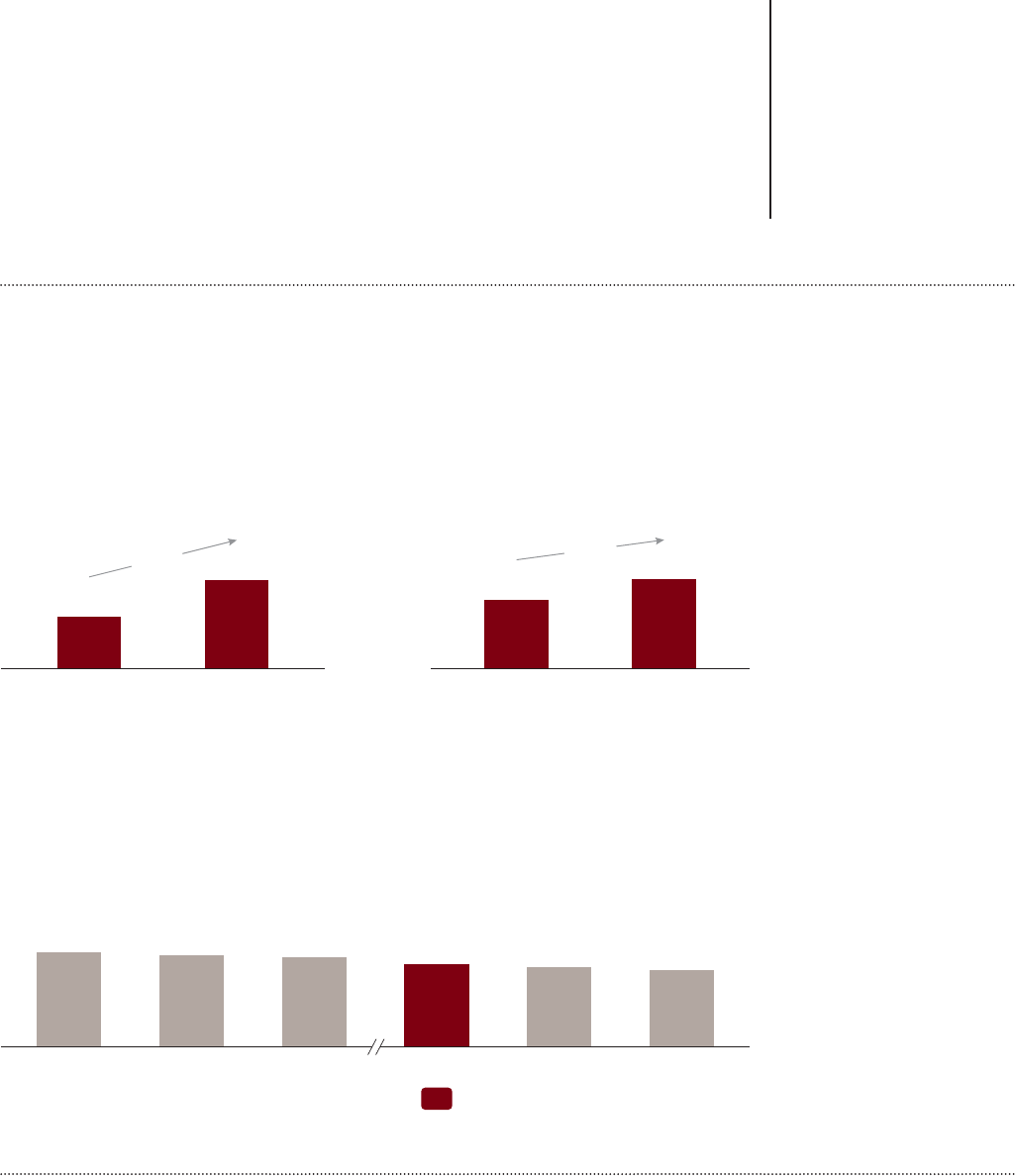
50 Strategy&
Online video viewing among the highest worldwide. Already a key
strength of India’s digital media environment, consumption of online
video increased by 30 percent from 2011 to 2013, driven by the ability
to view content over multiple mobile devices, and put India in eighth
place globally in terms of online video consumption in 2014 (see Exhibit
17 ). Between 2013 and 2014 alone, the number of people viewing
videos on smartphones and tablets rose 27 and 32 percent, respectively,
bringing the total to more than 110 million people.
Online video viewership
(unique viewers, in millions)
Top countries in online video viewing
(% of Internet users who watch online videos, 2014
)
Time spent on online videos
(minutes per month)
2011 20132011
32
338
54
432
2013
+30%
+13%
South Korea
96%
1
Ran
k
Spain
92%
2
Italy
91%
3
U.K.
80%
9
U.S.
78%
10
India
84%
8
Source: eMarketer and TNS
(March–June 2014), 55,000
respondents; Strategy&
analysis
Source: ComScore
Video Metrix (May 2013);
Strategy& analysis
Exhibit 17
Online video viewing patterns in India

51
Smartphone as the primary Internet platform for most consumers.
Indeed, mobility very likely holds the key to the increased consumption
of all kinds of digital media in India. Already, mobile browsers vastly
outnumber desktop browsers in the country, making up more than
two-thirds of the total compared with just 40 percent globally. However,
the amount of time spent browsing on mobile devices is lower, and the
average young user flips between devices 27 times a day, indicating a
shift toward a “snacking” culture.
Says Vivek R, the head of the books category at Indian e-commerce
website Flipkart: “Smartphones continue to dominate the market and
are continuously increasing their market share. In India we are also
seeing an increase in short-read consumption. Smartphones have
relatively smaller screens and multiple media functionalities. This leads
to a shorter attention span of the viewer and hence the preference for
shorter reads. As a result, a lot of short reads are doing well.”
37
An inclusive force: Previously unserved consumers feel the
power of digital platforms
In addition to urbanites, who are the primary consumers of media
content, India’s rural residents and the less privileged have been
empowered by the Internet to enjoy music and videos, read the news,
play games, and learn, and thus participate in the national discussion.
The rapid uptake of mobile devices and of technologies that let people
with low-bandwidth connectivity download content is largely
responsible for this transformation— one that will continue to support
the growth of India’s middle class.
Mobile growth. As in many developing countries, the spread of mobile
networks has been the primary driver of Internet penetration in India,
especially in rural areas. Since 2012, the number of mobile Internet
users in rural areas has grown 137 percent annually. In fact, mobile
data usage by low-income residents is surpassing usage by educated,
urban Indians (see Exhibit 18, next page). Thanks to reduced taris, 3G
networks reached 67 million people in India by 2014, while more than
5.5 million 4G devices had been sold in anticipation of the spread of 4G
networks. Meanwhile, despite the slow connection, 2G continues to be
adopted by many people in rural areas, thanks in part to the low cost of
2G data plans.
As more and more rural Indians gain access to the mobile Internet—
more than 50 million were connected by the middle of 2015— the
mobile phone is increasingly being seen not just as a communication
device but as a “window to the world.” Thanks to its high quality, mobile
video entertainment is especially prized by people outside the city;

52 Strategy&
Exhibit 18
Mobile Internet allows consumers from remote areas to access online content
Source: “Broadband in
India: Realizing the vision,”
Ericsson white paper, Oct.
2014
Source: “India Media &
Entertainment Industry
Report 2015,” KPMG;
Hindustan Times
Mobile Internet users in rural areas
(in millions
)
Educated, urban, affluent
Less educated, low income
Mobile data usage and services
2012 2013
45%55%
4
21
36
49
53
June 2015
(forecast)
March
2015
20142013
2012
+137%
CAGR
61%
39%

53
almost three-quarters of connected rural users watch entertainment
videos on their mobile devices. By 2013, half of the video content
consumed through telecom operator Airtel’s on-demand video store was
downloaded by users in rural areas.
Online, then o. A further key to the increase in video entertainment
among consumers with bandwidth limitations is the rise of new ways to
watch videos oine. In 2014, Google added an oine viewing option
to its YouTube mobile app that allows viewers to download a video and
then watch it within 48 hours. Later, in 2016, Google added its new
Smart Oine feature on YouTube that allows users to take advantage of
cheaper nighttime data rates oered by their mobile operators without
requiring them to stay up late. Viewers can also watch videos oine
through a mobile app called Hotstar, which proved so popular that its
rank among all apps in India improved from 339th to 38th between
January and May 2016, and reached a peak as the most downloaded
app on March 31, 2016.
Information for all. Indians in rural areas aren’t just watching videos
on their mobile phones— educational content is now much more widely
distributed thanks to the Internet. Companies like Rockstand and
NewsHunt are reaching readers throughout India by selling e-books
on popular magazine reading apps installed on most smartphones.
Dissemination of health and medical information has been especially
beneficial, as companies like Hughes Education India help medical
institutions expand their reach and accessibility across India through
their online platforms.
Digital provides emerging artists with easier access to
consumers and content majors alike
By providing greater access to low-cost distribution channels, creative
support from dedicated online platforms, and better access to funding,
the Internet has opened up all kinds of opportunities for India’s
emerging artists in every creative field. Video platforms such as
YouTube, music sites like OK Listen!, and Flipkart’s e-commerce site
for books give independent artists a chance to show o their talents to
audiences around the world. MCNs provide critical production support
to young video artists, along with the chance to distribute their
products to a large audience. Online crowdfunding platforms such
as Wishberry provide much-needed funding so that new artists can
complete and distribute their projects. And perhaps most important,
many new digital artists are being taken on by traditional media
channels, further contributing to the growth of the creative sector.

54 Strategy&
A learning opportunity
The demand for engineers in India is
high, but the country’s top engineering
school, the Indian Institute of
Technology (IIT), caters to just 3 percent
of the country’s student population.
Many new engineering schools have
been founded recently, but they often
suer from poor curriculum quality and
too few teachers. In hopes of helping to
solve this problem, and thus improve the
level of technical education in India, a
consortium of academics from a variety
of institutions founded the National
Programme on Technology Enhanced
Learning (NPTEL) 15 years ago to
provide high-quality classes and content
to a much larger share of the country’s
engineering students. Funding comes
from the Indian government and from
private companies seeking to strengthen
particular areas of education and to
directly sponsor their employees to gain
more knowledge.
Early on, the courses were moved to
YouTube to enable compressed video
formats, while also being oered on
schools’ intranets to serve students without
high-speed Internet connections. And the
courses now allow students to participate
more actively, engaging in Q&A sessions
and adding to the courses’ content.
Since its inception, NPTEL has had a
huge impact on making engineering
education available to a much larger
number of Indians. As of September
2015, it oered more than 900 online
courses to 270 million registered
users, and thousands of students
have “graduated” with engineering
certifications in a wide variety of
subjects. “The Internet is the most
beautiful thing that has ever happened
to this country,” says Dr. Mangala Sunder
Krishnan, a professor of chemistry at IIT
and a founding member of NPTEL.
Each of these new digital content platforms has already made real
contributions to the development of India’s creative sector.
The YouTube connection. YouTube has been perhaps the most
commonly used medium for many new artists to reach large audiences.
For instance, All India Bakchod (AIB) is an Indian comedy group that
started its career by oering its videos for distribution on YouTube.
Since it released its first video, in 2013, its audience has grown to more
than 1.58 million subscribers. And in May 2016, the troupe launched a
news comedy series on the Star India network.
Musicians, too, have found considerable success on YouTube. Since she
released her first video, in 2010, Shraddha Sharma, an Indian teenage
singer, has captured almost 198,000 subscribers and more than 14.4
million views (by May 2016). Her rapid rise to popularity— her
Facebook page has more than 3.6 million “likes”— led to a record
contract with Universal in 2013, and she released her first album,
Raastey, a year later.

55
Rajjat Barjatya, CEO of Rajshri Media until his death in 2016, said:
“Platforms such as YouTube have democratized the content creation
process and led to the removal of gatekeepers— established players
who could control the content being played and the entry of newer
players. New entrants now find it easy to showcase their talent to a
wide audience.”
38
Making music. Alongside the music videos available in India on
platforms like YouTube are numerous music distribution platforms that
contribute further to the rise of the country’s independent artists. OK
Listen! is a particularly successful one. Launched in 2012, it lets the
independent artists it specializes in make their songs available for
purchase at whatever price they choose, and gives them 70 percent of
each song’s net profits. The site also helps artists create their album’s
artwork and promotes them across other online channels. For example,
its partnership with the Orchard, the largest online aggregator and
redistributor of digital music worldwide, enables its artists to sell their
music through more than 700 digital platforms, including iTunes,
Amazon, and Spotify. In 2013 alone, OK Listen! supported more than
200 indie artists, and the most popular ones— bands such as Agam
and Lagori— are typically downloaded 300 or more times a month.
Publish yourself. Thanks largely to Amazon’s Kindle Direct Publishing,
self-publishing has risen rapidly as a way for Indian authors to publish,
market, and sell their books with minimal investment. The platform
really took o in August 2012, when Amazon allowed authors and
A career in music videos
Aakash Gandhi, an American
composer, performer, and entrepreneur,
was working in finance when he began
uploading videos of Bollywood music
to YouTube in 2008. Since then, he has
released more than 136 videos (by May
2016), which have been watched more
than 50 million times, and the number
of subscribers to his YouTube channel,
88KeysToEuphoria, has grown to more
than 155,000.
In 2011, Gandhi moved to Mumbai to
pursue his music career further. He
began collaborating with
other musicians around the world,
entirely over the Internet, and
launched 88keystoeuphoria.com, a
website oering music contests and
polls, as well as piano tutorials. More
recently, he has worked with traditional
media outlets Sony Music and Yash
Raj Films. “A lot of traditional labels
are looking into the digital space to
catch new talent,” Gandhi told PwC
and Strategy& in an interview on
Oct. 12, 2015.

56 Strategy&
publishers to set prices in Indian rupee on the Kindle Store; self-published
books now account for 20 percent of the bestsellers on Amazon in India.
Author Ashok Banker, for example, set up his own e-book store in 2011,
attracted primarily by the ease and low cost of distributing and
purchasing books online. And after self-publishing his Shiva trilogy
online, author Amish Tripathi earned a $1 million advance from
Westland, a traditional publisher. The print edition of the first book in
the trilogy sold more than 2.5 million copies within two and a half
years, and retail sales of the entire series have now brought in more
than $9 million, making it the fastest-selling book series in the history
of Indian publishing.
Says Vivek R, category head at Flipkart: “Lots of young authors and
self-publishers now have the opportunity to publicize their work directly
to their audience and build a brand for themselves.”
39
Rise of the MCNs. The number of independent content creators
specializing in made-for-Internet content has grown rapidly, and they
have attracted a large and loyal audience. That, in turn, has fueled the
emergence of the MCNs; usually aliated with video platforms such as
YouTube, MCNs provide creators with assistance in production and
distribution, monetization, and audience development.
Whacked Out Media is a case in point. Launched in 2011 as an online
and mobile aggregator of traditional broadcast, Bollywood, and online-
only content, Whacked Out has always tried to drive trac to its site
through both traditional content and the work of new artists, whose
careers it helps to develop. It moved to YouTube to benefit from the
greater number of eyeballs and multiple revenue models to be found
there, including advertising, licensing, and branding. It attracts a large
audience through its traditional content, and then directs that trac to
new artists, enabling it to fund their rise to popularity.
In 2015, through October, Whacked Out Media had been viewed 4
billion times over YouTube, compared with just 1.5 billion times in all
of 2014, and it is targeting a total of 3 billion views a month in 2017.
With 58 percent of its audience outside India, it expected to double the
number of YouTube subscribers, to 10 million, by the end of 2015, and it
already has 130 million followers on social media. And thanks to its low
production costs and high profit margins, it is hoping to grow its $1
million in 2014 revenues to $30 million in 2015.
New funding sources. The proliferation of crowdfunding sites in India,
both international and local, has allowed independent developers and
artists with no other means of support to bring their projects to life.
Game developers have especially benefited: By putting developers in

57
direct contact with their “backers,” these sites can both raise awareness
about new gaming projects and build demand for a game even before its
ocial release.
The Khel Planet Foundation, a nonprofit educational social enterprise
that helps build 21st-century life skills in children, turned to Wishberry,
an Indian crowdfunding platform, to help it fund an educational game
called King’s Kin. It succeeded in raising $3,550, almost 15 percent
more than its goal of $3,120. Another independent game studio, called
Pyrodactyl Games, chose U.S. crowdfunding site Kickstarter to raise
money for Unrest, its PC role-playing game. Hoping to raise $3,000, it
ended up with more than $36,000 to help develop the game.
Wishberry has financed the careers of musicians as well. In one case,
an independent experimental band called Parvaaz raised $4,000 in less
than two months to finance its first album, while building a solid fan
base at the same time. Following the 2014 release of the album, the
band was invited to perform at several popular music festivals and later
toured all over India.
Content majors leverage digital platforms to innovate their
traditional oerings
New artists aren’t the only ones who have benefited from the rise of the
Internet and mobile distribution in India. Traditional content majors,
too, have succeeded in boosting their reach, gaining insight into their
audiences, and growing closer to their customers as they build their
Internet presence. In the view of the late Rajjat Barjatya, who was
managing director and CEO of entertainment conglomerate Rajshri
Media, “YouTube and social media have enabled us to get closer to our
audience. We oer many dierent shows catering to a diverse audience,
and the number of ‘shares’ and ‘likes’ each show gets gives us a pretty
accurate idea of what viewers think about them.”
40
This has become true of long-standing companies in virtually every
content industry. From video and music to gaming and publishing,
traditional media companies have gained audiences, boosted revenues,
and improved the content they oer— all thanks to the Internet.
A future in music. Perhaps no creative industry has been aected by
the Internet as much as the music business. But traditional companies
that understand the shift to digital music can reap real benefits.
Founded more than 30 years ago, T-Series, now India’s largest music
company, shifted its business model early on to take advantage, in a
variety of ways, of the digitization of the sector. For instance, monthly
views of its YouTube channel have grown 83 percent annually since

58 Strategy&
2012, to 510 million in May 2016; overall, it has attracted more than 8
billion views and 10 million subscribers since its 2006 launch, making it
India’s top-ranked video channel. Every day, the channel posts several
music videos featuring the label’s artists; the most popular video—
“Dheere Dheere Se Meri Zindagi”— had attracted more than 132
million views by May 2016.
The label also promotes its artists, their latest releases, and upcoming
events through its T-Series Music ocial page on Facebook, which had
garnered 3.5 million fans by May 2016. The page gathers fans not just
from India but from around the world, and provides T-Series with
feedback on songs it can use to mold artists’ careers.
From print to digital. Many traditional publishers of newspapers and
magazines have begun the process of going digital, although the
struggle to find the best online business model continues. On the bright
side, the loss of print audiences has been oset by rapid increases in
digital, as the majority of readers have migrated online. Moreover,
digital’s cross-border reach has increased the international audience
by as much as 25 percent.
The Internet, however, has significantly increased the degree of
competition for all news organizations. The barriers to entry are
considerably lower online, and smaller firms such as the independent
Scroll are gaining viewers simply by repurposing and aggregating
content, and counting on it going viral. Indeed, for all news companies,
the success of any story is highly dependent on how readers find it and
whether it goes viral; as a result, a great deal of control over what
people read is now in the hands of the public at large. Competition from
smaller players like Scroll has also brought down advertising revenues.
Ultimately, a more sustainable model will need to be found, but at
present, no one is really sure what it will look like.
HT Media, publisher of the Hindustan Times, is using the Internet
to launch new online ventures. Its Mint, launched in 2007, is now
the country’s second-largest business media outlet. Mint is published
both in print and online, although most of its readers have migrated to
digital, especially on mobile devices. The company aims to run breaking
stories online, while using its print publication to run follow-up stories
and more in-depth content.
Let the viewers decide. India’s content majors are even beginning to use
the Internet to guide decisions about the content they provide their
customers. Like many TV networks, Star Plus, a TV channel owned by
Star India, uses social media to promote its shows, including Satyamev
Jayate, a talk show covering Indian social issues. But the show’s
producers also collect and analyze the social media chatter on Facebook

59
and Twitter in response to the show’s content, and then create future
episodes reflecting what viewers want to see. The buzz created by
Satyamev Jayate— more than 1 million responses each week— even led
to the creation of an oshoot weekly radio program based on the show.
The most powerful impact for content majors, however, has been in the
integration of the digital ecosystem into their traditional worlds. The
continued growth of traditional platforms uniquely positions content
majors in India to explore and experiment with integrated models. On
one end, leading broadcasters are commissioning YouTube creators to
produce content to be aired on prime-time television, while on the
other, studios are actively investing in short-form mobile-phone-
oriented content. Such initiatives have garnered initial success for
content majors that ventured into an integrated approach. For instance,
Star TV partnered with YouTube-born comedy channel AIB to launch a
news comedy series, On Air with AIB, which aired on Star Network in
October 2015. As another example, Yash Raj Films (one of the leading
production studios) created Y-Films, a production house to provide a
platform for young talent and innovative marketing, in April 2011.
Y-Films has been investing in creating short-form digital content
combining mainstream talent with new-age artists, and has produced
several successful Web series like Bang Baaja Baaraat. More recently,
Y-Films branched into short films of five- to 10-minute duration.
Through these initiatives, content majors are successfully promoting
innovation in their traditional oerings, creating incremental
viewership on traditional platforms, and driving youth engagement
for their brands. Y-Films also recently partnered with international
filmmaker Richard Curtis to support the U.N.’s Global Goals for
Sustainable Development by producing the Web series Man’s World
on women’s equality.
Indian digital content and creativity get international
attention
As we have seen, the Internet has done a great deal to develop and
promote India’s cultural wealth domestically. But it has had at least as
significant an impact on the spread of Indian creativity around the world.
India’s cultural exports are by no means limited to movies, however. The
news media, TV broadcasters, music companies, and even small-scale
video producers all have found success in international markets.
The Bollywood factor. Bollywood movie producers and distributors
are partnering with international online distribution platforms and
now reach large audiences around the world by leveraging the power
of digital.

60 Strategy&
M-Go, for instance, a joint venture for on-demand video between
DreamWorks Animation and Technicolor, which was bought by
Fandango in January 2016, has teamed with FilmKaravan to include
Bollywood releases in its oerings.
41
Similarly, Bigflix.com, India’s
oldest on-demand video service, recently signed a content-sharing
agreement with U.S.-based Hulu to bring Bollywood movies to Hulu’s
online video service.
Key to the international success of Bollywood is the ability to tailor
content to the needs of local markets, said the late Rajjat Barjatya, then
managing director and CEO of Rajshri Media. “The Internet,” he noted,
“was a significant help in penetrating newer markets and geographies
by partnering with local operators to provide content that was more
relevant to the local audience.”
42
News across the globe. India’s traditional newspapers, such as Times
of India and Dainik Bhaskar, established their online presence in India
years ago. Now they are going international, and the numbers of
viewers are growing. Indiatimes, for example, reached 77 million total
unique visitors by May 2016, with 18 percent of them living outside
India; that makes it the 11th most read website in India. The numbers
for Dainik Bhaskar are similar: 29 million unique visitors by May 2016,
one-third of them outside India.
TV news broadcasters have also found success internationally. NDTV,
one of India’s most popular news channels, has attracted 44 million
visitors to its website, and fully a quarter of them are visiting from other
countries.
The children’s market. Content for young children is uniquely able to
cross international boundaries, since much of it can avoid cultural and
language barriers. One company that has found considerable success in
this arena is India’s HooplaKidz, a small-scale video producer that has
become one of the most popular YouTube channels for preschoolers.
Launched in 2010, the site features nursery rhymes, original songs, stories,
spelling games, and interactive videos, making it a one-stop learning and
playing destination for preschool children. Since then, HooplaKidz has
become an international phenomenon, attracting large audiences in the
U.S., the U.K., Australia, and Canada, as well as in India itself. The number
of subscriptions to its YouTube channel grew from 1.2 million in 2014 to
2 million in May 2016. And its global success has enabled the company to
expand its oerings to a mobile app and a range of DVDs.
Another notable example is ChuChu TV, a children’s animation channel
launched in 2013 by Indian entrepreneur Vinoth Chander. Its first video
got about 300,000 views in a few weeks, and the second video, “Twinkle
Twinkle Little Star,” got the channel to the 5,000-subscriber mark.

61
Today, ChuChu TV is India’s third-largest YouTube channel, with nearly
5 million subscribers; it is now the most-watched YouTube channel in
Asia-Pacific and the second-most-watched children’s “edutainment”
channel in the world. The channel has amassed more than 5 billion
views with just 115 videos in approximately three years.
Interest from abroad. The growing popularity of India’s creative
output around the world has triggered a number of high-profile
acquisitions of Indian content creators by large international firms.
The popularity of HooplaKidz suggests why.
HooplaKidz is owned by YoBoHo, an Indian digital-first content
producer and multichannel network. With a library of more than 8,000
videos, 40 YouTube channels, and 40 brands and subbrands, YoBoHo
attracts 3 billion YouTube views a year. That level of success drew the
attention of BroadbandTV, owned by European broadcast giant RTL,
which bought YoBoHo in 2015 for more than $10 million.
The acquisition should enable YoBoHo to accelerate the international
reach of all its channels, including HooplaKidz, by scaling up the
business and leveraging BroadbandTV’s cutting-edge technology to
improve its content production.
As a result, BroadbandTV hopes to increase YoBoHo’s average monthly
YouTube views to more than 4 billion, eventually reaching 50 billion
views a year.
According to YoBoHo CEO Hitendra Merchant, “This acquisition has
already opened a lot of doors for us, enabling us to work more closely
with BroadbandTV’s production division, share knowledge, and add
more science to the business.”
43
World music. Indian music has also attracted a considerable amount of
foreign investment. In the case of music, however, the goal is primarily
to participate in the growth of India’s domestic music business,
especially streaming services, although other sectors, such as music
downloads integrated with mobile data plans, are also attracting
investors.
Many foreign funds are focusing on making equity investments in
Indian music services in order to tap into their revenue potential; the
music-streaming business in India is expected to outpace that of other
leading Asian markets within the next five years. In 2012, one such
service, Hungama, received major investments from U.S.-based Intel
Capital and Bessemer Venture Partners. By 2015, Hungama had reached
more than 48 million users, and is now expected to raise $100 million
in its next round of funding.

62 Strategy&
Conclusion
India’s vibrant national culture has long been sustained by its very
active traditional creative sector— its movies, TV shows, music, and
information and news outlets. In recent years, the rise of the Internet
and digital content has only enhanced the value of the country’s creative
sector, both at home and around the world. It has provided new outlets
for young artists, boosted their careers, dramatically widened their
audience, and drawn the attention of the content majors. It has enabled
the spread of Indian content beyond the country’s borders, increasing its
value and attracting lots of foreign investors. And it has brought millions
of otherwise isolated Indians into its sphere, giving them access to news
and information and opening up opportunities in education.

63Strategy&
Chapter 3
Australia: The revival of content
Australia is one of the two markets in our study— the other is Japan—
that we have classified as digitally equipped for creative content: not
quite as far advanced as hyper-connected South Korea, but well beyond
the positions in which transitional Thailand and next-generation India
are at present. Australia benefits from a well-developed Internet
infrastructure with fixed broadband penetration in 2015 of 73 percent
of households, which is comparable to that of other developed markets
such as the U.S. and Germany.
44
Trends shaping Australia’s creative market
High Internet usage is driving the growth in the amount of time
Australians spend consuming media— up 18 percent per annum
between 2007 and 2013. In 2008, Australians spent less than four hours
a day consuming media; five years later, media investment firm GroupM
estimates that they spent more than nine hours a day. This increase,
driven primarily through digital platforms, has not come at the expense
of time spent consuming traditional media such as TV, radio, and print
(see Exhibit 19, next page).
In fact, the large increase in time spent on digital media encompasses
an increase in consumption of traditional media assets as a whole. Each
type of media has benefited— 36 percent more time spent on TV’s
digital extensions, 15 percent on radio content, 76 percent on print
content, and 87 percent on games (see Exhibit 20, page 65).
45
Despite the increase in the amount of time consumers spent
consuming media, revenues in Australia’s creative sector actually fell
1 percent over the same period— due primarily to the decline in print
revenues. Indeed, average daily unit circulation and print advertising
revenues have been falling since 2009 and are expected to keep falling
for the foreseeable future, particularly as consumers of print get older;
people over the age of 65 make up the largest segment of print readers.
Advertising revenue losses in the print business have not yet been
offset by increases in revenue from digital advertising, despite an
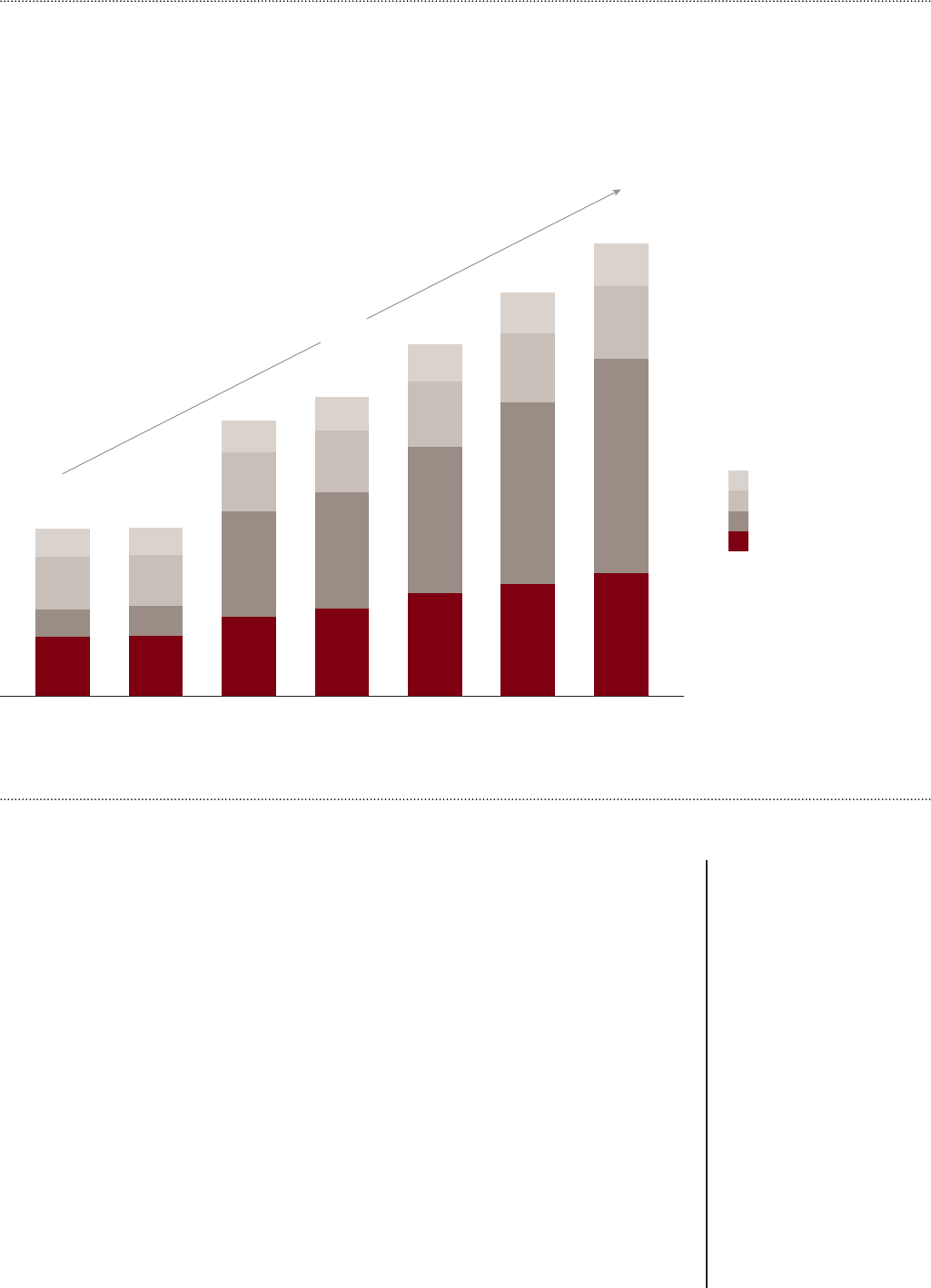
64 Strategy&
Note: Adults ages 18
and older. Results of
calculations may not be
exact due to rounding.
Source: Statista (from
GroupM); Strategy& analysis
Exhibit 19
Increased time spent on media in Australia
Share of time spent per day with major media
by Australian adults
(in hours)
+18%
3.6
31%
17%
36%
16%
2007
3.6
30%
17%
36%
17%
2008
5.9
21%
12%
29%
38%
2009
6.4
21%
11%
30%
38%
2010
7.6
19%
11%
29%
41%
2011
8.6
17%
10%
28%
45%
2012
8.6
16%
9%
27%
47%
2013
(forecast)
Radio
Print
TV
Digital
CAGR
2007–13F
+13%
+41%
+5%
+7%
increase in subscribers to newspapers’ Web and mobile platforms
of as much as 50 percent between 2013 and 2015.
46
As monetization
models for digital content become established, revenue from digital
advertising will more than cover the losses in advertising revenue
from non-digital content.
Australia’s creative sector experienced a slight contraction in the
past few years, making up 1.37 percent of the country’s GDP in 2015,
a decline from 1.45 percent in 2011. Australia is in the medium range
of countries in terms of the media sector’s contribution to GDP,
considerably below the U.S., South Korea, and the U.K., for instance.
In 2011, the media sector employed just 0.9 percent of the overall
workforce in Australia, which is lower than in most comparable
markets, such as Canada and Singapore.
47

65Strategy&
Source: Strategy& analysis
Exhibit 20
Increase in all forms of media consumption
Contribution of digital to total time spent per day with major media in Australia, 2013
3.61
Total TV
Contribution from digital
+ 36%
Traditional TV
2.65
1.77
Total radio
+ 15%
Contribution from digital
1.54
Traditional radio
1.60
Total print
+ 76%
Contribution from digital
0.91
Traditional print
0.69
Total games
+ 87%
Contribution from digitalTraditional games
0.37
Digital contributes to
40% more time spent
on media content
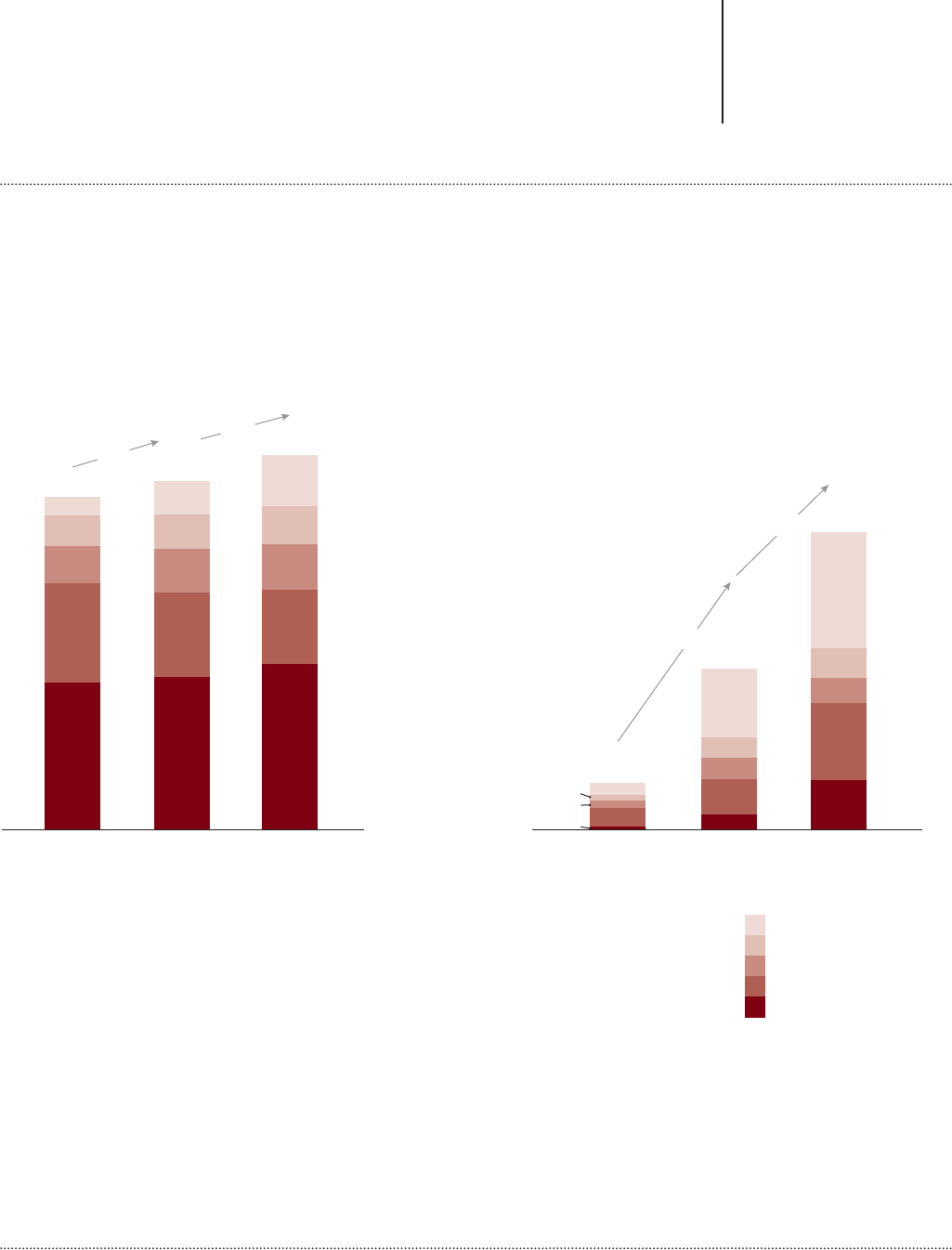
66 Strategy&
Still, the overall health of Australia’s creative content industries is strong
due to the Internet. Digital revenues have been boosting the sector’s
growth in recent years— increasing 35 percent annually from 2011 to
2015— and they will continue to do so as the sector, and particularly its
digital component, recovers by the end of the decade (see Exhibit 21).
Creative sector market size,
by sector
(in AU$ billions)
CAGR
(2011–20F)
+1%
+1%
2011
$21.2
44%
30%
11%
9%
6%
2020
(forecast)
$23.9
44%
20%
12%
10%
14%
2015
$22.3
44%
24%
12%
10%
10%
–5%
+2%
+1%
+2%
+9%
2011
$1.1
8%
40%
26%
2020
(forecast)
$7.0
26%
17%
8%
10%
39%
2015
$3.8
22%
12%
10%
43%
13%
CAGR
(2011–20F)
+14%
+17%
+34%
+19%
+28%
Digital creative sector market size,
by sector (in AU$ billions)
15%
12%
+35%
+13%
Games
Music
Books
Video
Print
Note: Results of
calculations may not be
exact due to rounding.
Source: PwC’s Australian
Entertainment and Media
Outlook; Strategy& analysis
Exhibit 21
Growth mainly from digital

67
Since 2012, digital media has compensated for more than half of the
contraction in the revenues of traditional media. Moving forward, digital
media is expected to more than oset the losses in revenues from
traditional media and restore overall growth in the sector.
Among the world’s most advanced smartphone markets. Australia
benefits from strong mobile connectivity; as of 2015, penetration was
100 percent for mobile phones
48
and 78 percent for smartphones
(many Australians have more than one). Smartphone penetration is
higher than in other developed countries, such as the U.S. (69 percent
in 2015), the U.K. (63 percent), and Germany (55percent).
49
In fact, despite a comparatively small population, Australia has the
ninth-highest number of smartphone subscriptions in the world, and
the majority of Australians’ time in front of a digital screen is spent on
a mobile device.
50
According to a July 2015 Nielsen study, Australians
spend 42 percent of their online time on their smartphones, 17 percent
on their tablets, and 41 percent on desktops. Nearly two-thirds of their
online smartphone time is spent on social media, entertainment, and
games (see Exhibit 22, next page).
The proliferation of mobile devices is driving an explosion of short-
form content in Australia, leading to the emergence of new artists
experimenting with alternative genres. This is opening up significant
opportunities in the market— greater diversity of content available to
users, and innovative business models for organizations. Much of this
trend will be a determining factor in the growth of Australia’s creative
economy. We will elaborate on these opportunities in more detail in the
next section.
In the following sections, we analyze the potential of the Internet and
digital technologies to revive the growth of the creative sector in
Australia in four areas: empowering emerging talent, who in turn fuel
local content creation; increasing consumers’ willingness to pay for
digital content; enabling content majors to increase their reach and
relations with audiences; and increasing the level of the country’s
creative exports.
Diverse, local, and bigger: How digital content is creating
opportunities for emergent artists
The Internet has opened up opportunities for emerging artists by
providing greater access to open distribution platforms, increased
support from platforms such as multichannel networks, better access to
funding, and the ability to reach international audiences at optimal cost.

68 Strategy&
The rise of independent creators has also greatly increased the amount
of locally produced content in Australia. Nick O’Byrne, manager of the
popular, award-winning singer-songwriter Courtney Barnett, says, “The
Internet lowers barriers to entry for nascent artists looking to explore
niche content.”
51
Open distribution platforms provide artists with a greater ability
to connect and build relationships with audiences. The many new
Internet-enabled distribution platforms have allowed nascent artists to
gain access to a wider audience, and build deeper relationships with
their fans, learning more about their likes and dislikes.
Source: Nielsen Mobile
Ratings Report, July 2015
Exhibit 22
Distribution of time spent on smartphones
Health
Entertainment
Social
Other
Productivity
Games
Messaging
Commerce
News and information
Search
34%
3%
2%
14%
3%
3%
4%
9%
13%
15%

69
• Online music streaming services have been especially helpful to new
artists such as Patrick James, who rose to fame thanks to Triple J
Unearthed, which focuses on unknown Australian artists, and to
Golden Features, Tkay Maidza, Safia, and Asta, whose popularity
was a direct result of exposure on Spotify.
• SketchShe, an Australian comedy trio whose parody videos are
filmed on phones with the support of friends, attained 765,000
subscribers in one year (by May 2016) to their YouTube channel; the
group is now getting oers from TV agents who would never have
talked to them before, says Shae-Lee, a member of SketchShe and its
producer and director.
• Independent artists increasingly use social media platforms to
connect with their audiences and build relationships. Says
Emmanuel Candi and Gavin Perry, head of strategy and HR and
head of digital, respectively, at Sony Music Australia, “We encourage
artists to share as much about themselves as possible, not just their
music content, in order to create a relationship with their fans.”
52
Jane Huxley, managing director of Pandora Australia and New
Zealand, concurs with this view: “We believe that true value is
created in the link between the fan and the artist.”
53
• These platforms also allow artists to analyze listener profiles and
to understand audience preferences more deeply. Artists can get
information on the geographic locations of their listeners, helping
them to more eectively plan their tours. Spotify, for example,
provides artists with data on their popularity city by city, allowing
them to decide which songs to play where. “We communicate with
fans through YouTube and other social media to obtain direct
feedback on our work,” says SketchShe’s Shae-Lee. “We incorporate
their feedback in future creations. People are very honest online.
You should take them into account.”
54
Increased support from platforms such as multichannel networks.
A variety of video platforms, led by YouTube, have also contributed to
the rise of new Australian artists. Seven of the top 10 YouTube artists
in Australia in May 2016 were represented by MCNs, which provide
individual artists with assistance in production and distribution, as
well as monetization and audience development. The most popular,
HowToBasic, which appears on the Fullscreen MCN channel, had close
to 7.2 million subscribers in May 2016.
The sheer number and popularity of these digital platforms and the
local artists they promote are unleashing the creative potential of
talented Australian youth. This is driving a wave of consumption of
locally produced content as opposed to imported content.

70 Strategy&
Crowdfunding to fuel the creative economy. Among other creative
sectors, Australia’s film industry has benefited from the democratization
of access to funds. The number of new platforms dedicated not just to
funding but also to distribution is rapidly increasing. Pozible, the most
successful Australian crowdfunding platform, is estimated to have
secured more than $3 million for new feature films between 2010 and
2013. Pozible enabled Tim Lea, an independent film director and writer,
to finance his sci-fi film, 54 Days, raising more than $45,000 in just one
month. Once finished, the film was made available to the public on three
dierent video-on-demand platforms, and won considerable critical
acclaim.
Similarly, Dean Francis turned to Tugg, a cinema-on-demand platform
through which people can request film screenings, to distribute his 2015
independent drama, Drown. Tugg helped promote the film by preselling
tickets, rewarding Francis with a percentage of the profits.
The Van Vuuren Bros expand to TV
A further demonstration of the cultural
power of the Internet is its role in
bringing new artists into traditional
mainstream media. The Van Vuuren
Bros are a case in point. Among
Australia’s most popular television
comedy talent, the team— Christiaan
and Connor Van Vuuren— first found
their audience online. When Christiaan
was hospitalized for six months with
tuberculosis, he and his brother made a
series of satirical music videos starring
the character the Fully Sick Rapper,
which they uploaded to YouTube.
As of May 2016, the series had received
more than 17 million views worldwide,
and the duo’s YouTube channel had
more than 60,000 subscribers. Their
popularity led to a series on ABC TV
called Soul Mates, which was renewed
for a second season and will air by the
end of 2016.
Among the virtues of the Internet,
according to brother Christiaan, is
that it allows the duo to invest minimal
capital into assets and equipment,
and to employ a small team of writers,
keeping production costs to a minimum.
“We focus on creating content that
can be produced quickly and cheaply,”
he said in an interview with PwC and
Strategy&, conducted with Chloe
Rickard, on Aug. 14, 2015. Without
the need to invest significant capital,
the brothers have been able to focus
on developing ideas and content.
Currently, they have seven TV and
film projects under development.
“The major benefits of the Internet,”
Christiaan points out, “include the
direct relationship between audience
and creators, creating exactly what you
want, and the consequent shift of power
toward content creators.”

71
The consumer’s surplus
Australia’s consumers have benefited considerably from content variety,
convenience, and flexibility.
The unique advantages of anytime, anywhere content. With the
proliferation of distribution platforms such as Netflix for movies and
Pandora for music, consumers benefit from greater variety, quality,
convenience, and aordability. As a result, they are spending more time
consuming content and their willingness to pay has increased. In fact,
the Internet has given consumers access to all their favorite music in one
place, and, as a consequence, more people than ever before are listening
to music.
Sony Music Australia’s Candi and Perry have been working to deliver a
unique proposition to consumers by “moving to a global release date,
where content is released globally on the same day,” rather than
staggering release dates across geographies, and by “making music
legally accessible in a very broad way and very cost-eectively.”
55
Streaming uptake has been significant in Australia and is expected to
further increase as younger people grow up. In fact, a survey cited by
the Australian Communications and Media Authority in June 2015
demonstrated that streaming-video-on-demand (SVOD) was particularly
popular among young adults: One-third of those ages 18 to 34 use
streaming services and consume an average of 9.9 hours of content
each week, with only 11 percent of those 35 and older using streaming
services, consuming an average of 5.2 hours of content weekly.
Being able to consume content in a timely manner was listed by
49 percent of respondents as one of the main benefits of streaming
I Quit Sugar: From a $100 investment into a $1.8 million annual business
With an initial $100 investment in a
website, Sarah Wilson started writing
her health and nutrition blog, I Quit
Sugar, in January 2011; its popularity
grew organically through word of
mouth, reaching 1.5 million monthly
page views in 2016, with 69 percent
of the audience coming from outside
Australia.
Wilson followed up her success with an
e-book in 2011, and then a print edition,
which became a bestseller in Australia
and the United States. In 2013, she
created and launched an eight-week
online health and wellness program,
which now brings in 60 percent of her
business’s revenues. All in all, following
her initial $100 investment she now
generates $1.8 million annually.

72 Strategy&
services, while 44 percent cited greater choice and 21 percent named
the lower cost.
56
Netflix’s experience in Australia demonstrates that a combination of
up-to-date content, accessibility, and aordable pricing is a winning
strategy. Launched in Australia in March 2015, Netflix drew in 2.5
million users in the first half of 2015 and has been leading the country’s
SVOD services.
57
In addition, the introduction of Netflix and other legal distribution
platforms has caused a decrease in casual pirates through a combination
of high quality and more aordable content. In fact, according to Netflix
CFO David Wells, a country’s piracy rate is a significant factor when
determining the pricing model. In Australia, Netflix oered its lower-
tier services for a cheaper price than it does in other developed
countries to give Australians an incentive to opt for legal options.
Results were satisfying: In less than six months on the market,
Netflix had already attracted 2.6 million people and 960,000 paying
subscribers.
Spreading Australia’s cultural wealth. Not only does the Internet
facilitate the dissemination of creative content for commercial benefit,
but it also supports the preservation of Australia’s cultural and historical
heritage. Historical documents and artifacts, as well as educational
texts, have been digitized for private use and academic research. The
State Library of New South Wales, which holds the world’s most
extensive collection of documents, manuscripts, journals, maps, books,
objects, and artwork related to Australia and Oceania, including the
region’s indigenous prehistory and the history of European settlement,
is three years into a 10-year program of digitizing the most valuable and
fragile parts of the collection. This will allow it to preserve the material
and increase its usefulness, ultimately enabling thousands of people to
access it seamlessly. The collection has an estimated value of AU$3.2
billion, according to Dr. Alex Byrne, the library’s former CEO and state
librarian. “Holding this collection is important, of course, but the real
value is in making it available,” he says. “We have a full-hearted
commitment to making our materials accessible online to people
constrained by health, age, geography, or a limited amount of time.
We’re now open 24/7 from wherever people can get connectivity.”
58
The Internet doesn’t only oer access to the collection; it enables the
library to contribute to it more easily and enhance it. For instance, the
library has launched a new transcription tool that allows volunteers
to assist with transcribing hard-to-read materials such as World War
One journals. “In the past, volunteers had to come in and sit with a
photocopy of the original. Now they can do it from their home or
garden,” says Byrne. Users can also extract data to make new

73
connections and add to the collection’s knowledge, taking images of
land grants, for example, and combining them with geo-tagging to
understand patterns of settlement, or searching digitized newspapers
to discover when certain words became popular. And by collecting
materials from the digital age, the library will give future audiences a
better understanding of life in Australia today. Says Byrne, “In two
centuries’ time, people will want to get a good picture of life today—
and we will have it.”
Content majors gain access to bigger audiences and more
consumer time
Although the Internet has yielded a much larger base of audience time
and engagement for traditional content, it is simultaneously altering the
business models for traditional content creators in many ways.
Some traditional players, notably print companies, are still struggling to
recover revenues lost to online sources over the past decade, yet the
Internet allowed them to expand their audience reach both locally and
internationally while using analytics to gain greater insights into who
their users are and their likes and dislikes.
The Internet has also forced media companies to innovate and
experiment with new content oerings and new customer experiences,
and to diversify their business models in their search for new sources of
revenue.
Increasing the reach of content majors. Australians are rapidly
coming to rely less and less on traditional print media for their news,
and turning instead to online sources and social media. Between 2013
and 2015 alone, newspapers in Australia experienced an 11 percent
decrease in print subscriptions.
59
A survey issued in the Reuters Institute
Digital News Report 2015 shows that just 7 percent of Australians rely
on print newspapers as their main source of news, compared with 12
percent relying on social media and fully 44 percent on online overall.
60
At the same time, however, subscribers on both online and mobile
platforms have increased by 50 percent during the same period,
contributing to a net increase of 7.5 percent in traditional publishers’
total audience
61
(see Exhibit 23, next page). In fact, all three of the
country’s top newspapers, the Sydney Morning Herald, the Daily
Telegraph, and the Herald Sun, have boosted their overall number of
subscriptions, even as print subscriptions have declined.
The changing nature of Australia’s print publishing business can be seen
clearly in the case of Bauer Media Group, the country’s largest consumer

74 Strategy&
Note: Results for the top
14 newspapers in Australia.
Source: EMMA audience
reports; Strategy& analysis
Exhibit 23
Growth in news consumption in Australia
Breakdown of publishers’ audiences
(in millions of people)
1.77
2015Additional users
(2013–15)
0.7
2.2
3.7
-2.2
2.1
31.7
11.1
18.5
1.4 (5%)
29.5
20.7 (70%)
7.4 (25%)
2013
Mobile onl
y
Print only
Web only
magazine publisher, with 60 titles and more than 65 million copies sold
annually. (See “Bauer Media diversifies on the Internet,” next page.)
As with print, TV content majors are looking to the Internet to make up
for their decreasing oine reach. Between 2012 and 2014, the
percentage of Australians watching ABC’s broadcasts declined 3
percent, while downloads of videos on iView, ABC’s online oering
launched in 2008, rose 41 percent. In 2015, iView became the 19th most
visited site in Australia, thanks largely to the ability of its audiences to
watch all kinds of content anytime, anywhere.
Southern Cross Austereo (SCA) has been very successful in its eorts to
leverage digital opportunities. SCA is Australia’s largest regional radio

75
Bauer Media diversifies on the Internet
Bauer Media Group is Australia’s largest
publisher of consumer magazines. Its
flagship titles include such well-known
magazines as Cosmopolitan, Elle, and
Harper’s Bazaar, all licensed from Hearst
in the United States. Marina Go, former
general manager of Bauer’s Hearst titles,
has a strong interest in new digital
business models and how publishers can
use the opportunities (and challenges)
brought by the Internet to prove the value
of magazines as well as to build audiences
and explore new avenues of creativity.
Despite the challenges she faces in
bringing her business to the Web, Go has
already made a number of moves online
that she expects will pay o with more
subscribers and increased revenues.
• An audience pipeline.
Cosmopolitan, Bauer’s most popular
title, has doubled its online audience
since the mid-1990s, from 1 million
to more than 2 million. These new
online readers are younger— in
their 20s, versus mid-30s for the
print magazine. Go expects online
readers to serve as a pipeline for
subscribers to the print edition,
which oers a dierent experience.
• Diverse business models. Go’s
division is exploring a variety of new
revenue streams for the magazines
she manages, as circulation and
advertising revenues from their
print editions decline. Events and
licensing will certainly be part of the
mix— Cosmopolitan, for example,
is launching a branded fragrance,
and Elle has started up a line of home
furnishings and children’s wear.
• Interactive content. In addition
to video, Go is focusing on oering
useful tools, such as a “try this
hairstyle” tool, and interactive
games and quizzes. Oering
sponsorships can help monetize
these tools, which are also boosting
return visits and social media shares.
• Quality versus quantity. Despite
all the new options at her disposal
online, Go is not willing to sacrifice
quality for quantity in the eort to
compete with digital-only players.
Maintaining high standards for
content, both online and in print, is
a key reason her company has never
lost an advertiser to a digital-only
player, Go believes.

76 Strategy&
group, with 71 stations, including in the country’s five biggest markets.
SCA’s online numbers are equally impressive: It has the largest online
audience of any terrestrial broadcaster in the world, with more than
1.1 million users and 3.7 million fans on Facebook, and it is the 10th-
biggest mobile publisher in Australia.
Content majors leverage the Internet to make wiser programming
decisions. SCA’s former chief digital ocer, Vijay Solanki, notes that
the company’s complex, multipronged digital strategy is dependent on
data analysis and richer content to build audiences and drive revenues.
Key digital initiatives undertaken by the group include the following:
• Oering innovative and creative content for youth through
eorts such as a curated video channel, called YouTube Hits, and
SCA’s partnership with YouTube on Fan Fests, live events where
popular YouTube creators can meet their fans. The partnership will
enable SCA to introduce younger audiences to its youth-oriented
presenters.
• Reaching listeners in a dierent way through digital platforms
like Facebook, YouTube, Twitter’s Periscope, and its own popular
online sites, which allow SCA to create (and monetize) videos to
supplement its audio content.
• Using data to analyze how content is consumed online to inform
better content decisions. Understanding when users turn o videos
and podcasts enables SCA producers and content professionals to
oer better, more popular content. SCA has also built a tool that
analyzes listening patterns on social media to provide insights into
the kinds of content of greatest interest to listeners.
• Providing on-demand and “snackable” content such as podcasts,
on-demand highlights packages, and YouTube videos. These allow
listeners to consume SCA’s content whenever they want to, and in
bite-sized portions.
• Selling advertising in a dierent way, such as a partnership with
Triton Digital to bring the first programmatic audio and mobile ad
exchange to Australia, giving SCA automatic access to ad revenues
from programmatic purchases. SCA has also partnered with music-
streaming app Shazam to create the “Shazam Top 20” show.
A turning point
Australia’s creative industry is at a turning point, which is clearly
exhibited by the following developments:

77
Local content boom and cultural renaissance. Digital has
contributed to Australia’s growing demand for local content from
traditional media such as newspapers and from emerging artists, while
increasing its supply at the same time.
• Online Australian news sources are increasingly popular: 61 percent
of total trac on the top 12 sites is devoted to visiting local news
websites, up from 55 percent in 2012, according to Nielsen. And the
number of Australian visitors to “.au” websites is growing faster than
visitors to “.com” websites.
• Local short-form audio/video content is much more popular on
digital platforms than on long-form box oce platforms. Local
YouTube artists are capturing and engaging with a much larger share
of the Australian audience than is the box oce; there was just one
local movie in the top 20 box oce films in Australia for each year
between 2010 and 2015.
• More and more local artists who began their careers on digital
platforms are securing deals with traditional media outlets. The
Van Vuuren Bros have produced content for TV; and I Quit Sugar,
SketchShe, and Draw with Jazza have all been approached by TV and
publishing companies following their success online. As more local
emerging artists enter the traditional realm, the local content
industry in Australia is likely to strengthen further.
• All in all, the Internet is driving a much wider variety and volume of
the creative sector’s output with a higher share of local production.
From content import to content export. Besides being popular at
home, many of Australia’s new Internet-based artists have also been
able to establish themselves in markets across the globe thanks to the
diminishment of physical borders, aording them significant additional
revenues. Unsurprisingly, Australia’s cultural exports are especially
popular in English-speaking countries like the U.K., the U.S., Canada,
South Africa, and New Zealand. However, they are also proving popular
in non-English-speaking countries like Germany, Sweden, Singapore,
Malaysia, and even El Salvador.
Josiah Brooks launched his Draw with Jazza YouTube channel in 2012 to
oer tutorials on the art of animation, allowing him to communicate
with audiences and respond to their comments. Since then, the channel’s
format has evolved to include hosting other people’s content and
competitions. Draw with Jazza generated 5,000 subscriptions in its first
six months, and boasted more than 585,000 subscribers in May 2016.
The majority of Brooks’s followers are in the U.S., with another 20
percent in Europe and the United Kingdom. Recently, thanks to his

78 Strategy&
international reach, Brooks was asked by an American publisher to create
a book on the subject of animation. “If you build a large enough audience
on digital, traditional media will want to work with you,” Brooks notes.
62
Australian film distribution platforms have also found success in
international markets. Beamafilm, for example, oers niche content via
video-on-demand that has not necessarily been released theatrically,
focusing on independent films that are prizewinners and film festival
favorites. It also licenses its films to libraries, where patrons can access
its full collection for free. These distribution models allow Beamafilm to
sidestep the barriers put up by traditional theatrical models, and it now
reaches audiences across Australia and New Zealand, and farther afield,
in the U.K., the U.S., France, Germany, and Mexico. The company’s dual
public and institutional oerings give independent filmmakers much
greater exposure than they’ve had in the past.
Increased adoption of legal distribution channels. Finally, the
proliferation in Australia of legal distribution platforms such as Netflix
for movies and Pandora and Google Play Music for music oers
consumers more variety, quality, convenience, and aordability,
increasing their willingness to pay and reducing piracy rates. More and
more consumers are signing up for paid streaming services, which is a
positive for the music industry. As it is, indeed, for the creative industry
overall. And as consumers become more willing to pay for digital
entertainment, they will also likely become more willing to pay for all
kinds of quality digital content, allowing traditional players such as
newspapers and TV and radio broadcasters to more eectively profit
from their own digital trac.
These trends point to a brighter future for the entire creative sector in
Australia if the full potential of digital can be harnessed.
Conclusion
The Internet has propelled a notable increase in the daily consumption
of media in Australia, at a rate much greater than in the other countries
in this study. Almost all of this incremental time is spent on digital
platforms, resulting in a democratization of content creation. Many
nascent artists are emerging, along with new business models and
financing mechanisms to support their growth. In addition, content
majors of every type have been able to significantly broaden their
audiences and share of their time.
As traditional media businesses adapt to the online environment, the
growth they are now achieving through digital technologies is more
than making up for all the losses experienced in traditional outlets.

79
In addition, the rise of nascent artists and their passion for creating
local content is driving a cultural boom in Australia. “Born-digital”
artists in Australia are crossing over into mainstream media and
making use of traditional platforms at a faster pace than we’ve seen
anywhere else in the world. Not only is the local content catering to the
untapped demand of the Australian people, but it is also generating a
new appreciation for Australian content in international markets, as the
country shifts its status from importer of international content of
traditional media to exporter of digital-only content.

80 Strategy&
Chapter 4
South Korea: Opening the
creative sector to the world
South Korea is the most digitally advanced market in our study, and its
creative sector has the second-highest share of digital content, after
Japan, among the five countries we researched. It is characterized by a
high level of mobility and adoption of messaging platforms for content
sharing. South Koreans are more willing to pay for digital content than
are consumers in most other countries (see Exhibit 24, next page), and
they regularly pay through micropayment platforms. Accordingly,
though per capita consumption of media content is lower in South
Korea than in the other countries in our study (six hours per day,
33 percent lower than the average), the country has a robust creative
sector. And time spent on media content has been growing, largely
due to incremental extra time being spent on the Internet.
Trends shaping South Korea’s creative market
South Korea’s creative sector grew 6 percent annually from 2011 until
2015 to reach $25.5 billion in revenues. That growth is very largely
attributable to revenues from digital, which grew 21 percent over the
same period, compared with 0.7 percent growth for traditional media
revenues. Indeed, digital media continues to grow multiple times faster
than South Korea’s overall GDP (see Exhibit 25, page 82).
Video, including TV and home entertainment, was the largest creative
industry in Korea in 2015, contributing 37 percent of creative market
revenues. The overall video market grew at a healthy rate of 6 percent
per year from 2011 to 2015. Indeed, South Korea tops the global ranking
in terms of online video consumption: 96 percent of Internet users
regularly watch online videos, whereas the comparable numbers for the
U.K. and the U.S. stand at 80 and 78 percent, respectively (see Exhibit
26, page 83).
Despite a large online video penetration, online TV revenues are still
nascent and constitute only 1 percent of the TV market; they are
expected to grow at 19 percent per year from 2015 to 2020.

81Strategy&
Time spent on media
(in hours/day)
Monetization by hour of usage
(in US$ per 1,000 capita for print and TV, and per
1,000 Internet population for digital)
10%
6%
56%
28%
8%
4%
53%
35%
2010 2013
5
6
TV
Internet
+11%
+2%
–8%
–3%
Radio
Print
2013
2010
Print TV Internet
$719
$737
$116
$111
$135
$262
+1%
–1%
+25%
+4.0% CAGR
Note: Results of calculations may not be exact
due to rounding.
Source: Newswire, 2014; Strategy& analysis
Exhibit 24
Increasing willingness to pay for online media in South Korea
Source: PwC’s Global Entertainment and Media
Outlook; eMarketer; Statista; Strategy& analysis

82 Strategy&
Source: PwC’s Global
Entertainment and Media
Outlook; Euromonitor;
Strategy& analysis
Exhibit 25
Growth in South Korea’s digital media
Growth of nominal GDP, media market, and digital media market
(year-over-year growth)
10
15
25
30
35
20
0
5
-2%
2014–15
11%
6%
2013–14
17%
6%
8%
2012–13
21%
7%
5%
2011–12
34%
2%
7%
Digital media market
Media market
GDP

83Strategy&
Source: eMarketer; TNS
Exhibit 26
South Korea leads in online video consumption
Penetration of online video content by Internet users, 2014
Argentina
India
U.K.
U.S.
Australia
Brazil
France
Japan
Germany
96%
92%
91%
90%
90%
85%
84%
84%
80%
78%
77%
77%
75%
74%
71%
Italy
Mexico
South Korea
Spain
Canada
China

84 Strategy&
South Korea has a vibrant local film production industry. In 2014,
local movies, such as My Love, Don’t Cross That River, outperformed
Hollywood blockbusters such as Interstellar and Exodus, earning more
than $71 million at the box oce.
South Korea has a large newspaper market with about 300 titles.
Some of them— such as the Chosun Ilbo and JoongAng Ilbo— rank
among the best-selling papers in the world. Print players, however, have
lost a consistent 5 percent of their top line over the past five years as
social networks and digital videos gain in popularity and news content
becomes freely available online.
South Korea has the ninth-largest book market in the world.
Consumption is shifting from physical books to e-readers. As a
consequence, brick-and-mortar bookshops have suered: According
to the Korean Publishers Association, the number of bookshops fell
from 2,042 in 2007 to 1,752 in 2014.
Music revenues are growing slowly in Korea, mainly driven by digital
sales, which have witnessed an average 12.7 percent growth per year
from 2011 to 2015, compared with 1.9 percent for non-digital music.
The electronic games industry, however, has been the key driver of
growth in the creative market in South Korea, contributing 26 percent
of the entire media sector’s revenues in 2014, compared with 12 percent
in Japan, 6 percent in Australia and Thailand, and 3 percent in India
(see Exhibit 27, next page).
Several trends characterize this rapid growth:
Powerful culture of mobile usage and micropayments. South
Korea benefits from a highly connected population exhibiting a
propensity to pay for digital content. With 99 percent of the
population owning smartphones in 2016,
63
a strong broadband
Internet infrastructure, and convenient mobile payment methods,
more than half the country’s population spends regularly on digital
content.
The use of mobile devices accounted for about a third of the country’s
total Internet traffic in 2015.
64
In August 2015, South Korea was
ranked as the fourth-highest market worldwide in terms of
smartphone penetration. Mobile has become a vital part of South
Koreans’ lifestyles and media consumption: More than 50 percent
of smartphone users watch online videos on a weekly basis, and
40 and 30 percent use their phones for music and game consumption,
respectively (see Exhibit 28, page 86). Indeed, digital games account
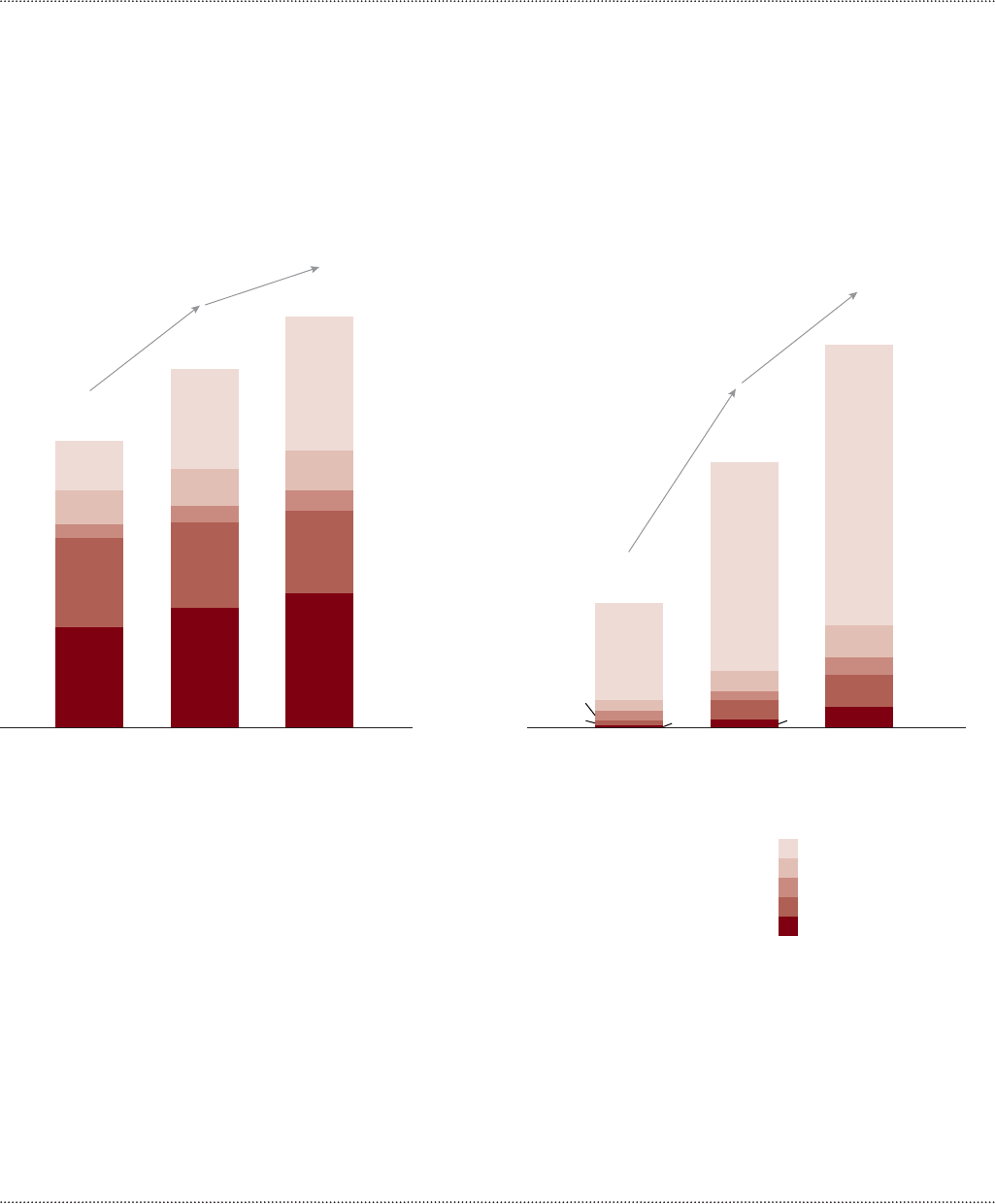
85Strategy&
Note: Results of
calculations may not be
exact due to rounding.
Source: PwC’s Global
Entertainment and Media
Outlook; Strategy& analysis
Exhibit 27
Digital media and games drive growth
17%
10%
4%
24%
20%
5%
33%
$25.6
2015
33%
10%
33%
$29.3
2020
(forecast)
+6%
+3%
2011
28%
$20.4
35%
31%
5%
12%
Music
Print
Video
Books
Games
-1%
+3%
+12%
+2%
+5%
CAGR
(2011–20F)
Creative sector market size by sector
(in US$ billions)
Digital creative sector market size
(in US$ billions)
+16%
+21%
+8%
+12%
+14%
2015
8%
3%
7%
3%
$8.9
+13%
73%
8%
4%
9%
5%
78%
78%
9%
$12.8
2011
$4.2
7%
2%
+24%
4%
CAGR
(2011–20F)
2020
(forecast)

86 Strategy&
Source: TNS Infratest;
Google; Strategy& analysis
Exhibit 28
Mobile devices in South Korea
Check email
Visit social networks
50%
Watch online videos
47%
48%
Use search engines
88%
Purchase products/services
14%
Play games
30%
Listen to music
40%
Look up maps and directions
43%
Look for product information
44%
South Koreans’ smartphone activities, 2015
Which of the following do you do on your smartphone at least weekly?
South Koreans’ electronic device usage, 2015
Which, if any, of the following devices do you currently use?
Computer
Digital device to save
or record TV programs
Tablet
MP3 player
Internet-enabled TV
15%
31%
15%
27%
98%
Mobile phone
68%
Smartphone
TV
93%
83%
Media activity
for 92 percent of the country’s spending on digital content; only
Japan comes close among the five countries we studied (see Exhibit 29,
next page). Game expenditures in 2013 were $153 per capita in Korea,
compared with $77 in Japan, and just $46 in the United States.
65
South Korea’s ecient payment schemes allow game makers to easily
profit from their games. The majority of games are paid for through
online micro-transactions, which have enabled revenues to grow at
a remarkable 23 percent annually from 2011 to 2015. The freemium
model— the game is given away, but new elements or levels must be
paid for— is overtaking the physical and digital sales of games. Social
gaming is also growing robustly, by 10 percent per year from 2011 to
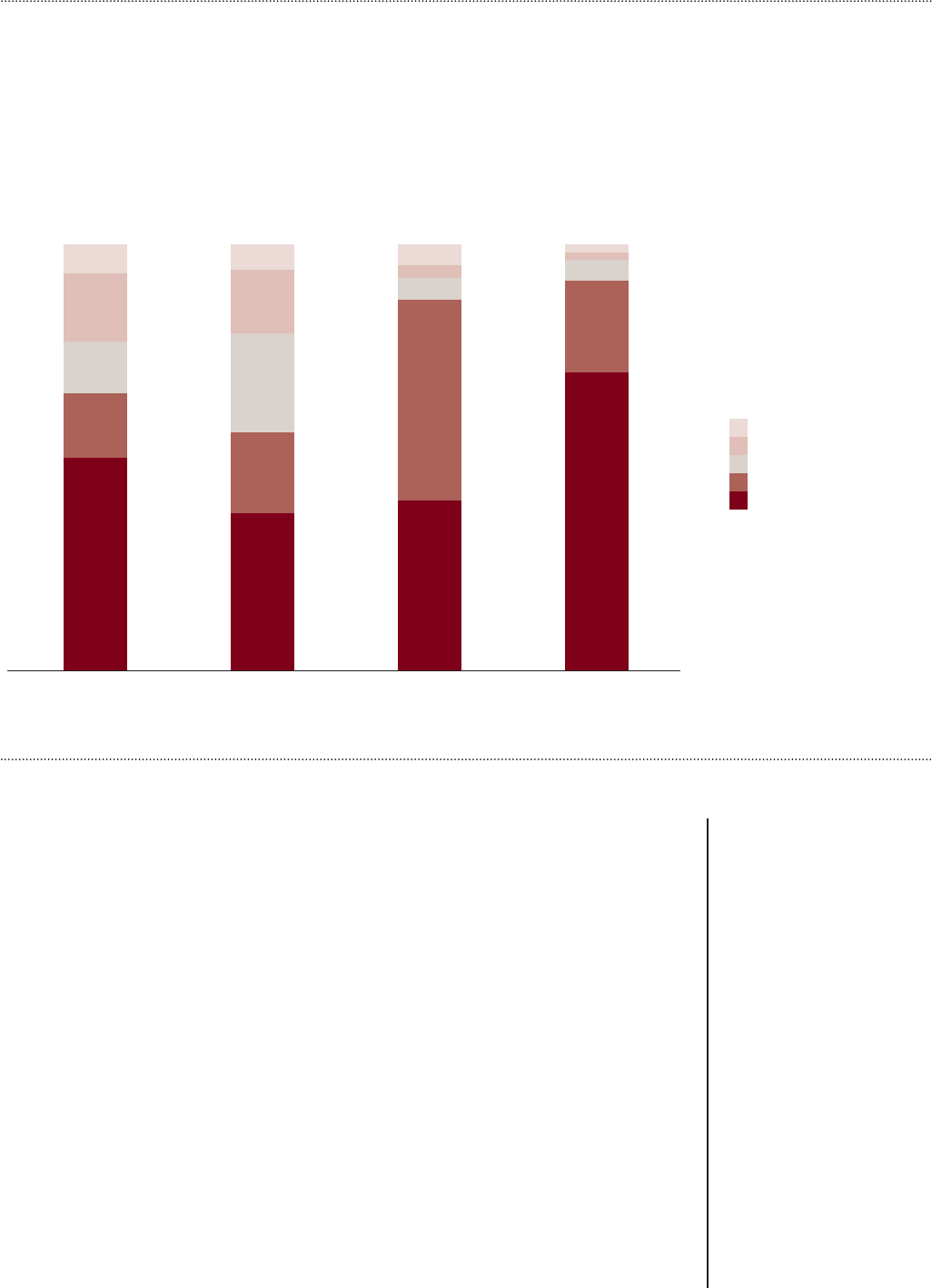
87Strategy&
Note: Percentages may not
equal 100 due to rounding.
Source: “Digital Content
Report 2013,” by HIS
Technology and App Annie;
Strategy& analysis
Exhibit 29
Spending on digital content by country
50%
37%
40%
70%
15%
19%
47%
22%
12%
23%
16%
15%
5%
South Korea
5%
2%
2%
Japan
3%
5%
U.S.
6%
Germany
7%
Digital games (excluding apps
)
Online movies
App-based games
Online music
Other apps
Composition of digital content spending
(% of total content spending, 2013)
2015, thanks mostly to app-based games and the rapidly expanding
trend to mobile gaming.
66
The strength of South Korea’s digital industry demonstrates just
how vibrant a country’s creative sector can become. In the following
sections, we’ll look at how the Internet has positively aected several
other aspects of Korea’s thriving creative industries.
Korean consumers embrace social and mobile platforms for
content. A key virtue of mobility is that it allows users to consume
games and music socially, sharing the activities with friends. Kakao
Talk, South Korea’s most popular mobile chat app,is a case in point. In
2012, Kakao Corp., the company that owns the app, introduced Kakao
Games, its gaming service, which allows users to download games
and play with each other and share scores through the Kakao Talk

88 Strategy&
messaging app. Players buy virtual items and make in-app purchases
usingKakao Talk’s virtual coins, called choco. In just three months
after its release, Kakao Games had been downloaded 82 million times
by 23 million unique users, and since then it has consistently grown its
audiences and revenues. The company’s music app, called Kakao Music
Room, has proved almost as popular. The app oers users a personal
space that displays all songs purchased as well as comments left for
users by their friends. Launched in September 2013, it had been
downloaded 15 million times by August 2014.
67
The revival of South Korea’s music market. As with the music
industry everywhere, South Korea’s CD sales began to contract in
2002 and continued shrinking through 2005, thanks to fast-growing
broadband adoption and the explosion of illegal downloading. During
that period, 85 percent of physical music retailers in South Korea closed
up shop. But in 2006, P2P file-sharing services for the transfer of MP3
files, long viewed as a detriment to the country’s multibillion-dollar
music industry, were ruled illegal by South Korean courts. The result
was rapid growth in the digital sale of music through a number of
online distribution platforms. That same year saw digital sales of music
in South Korea outpace physical sales for the first time (see Exhibit 30,
next page).
Online music distribution platforms such as MelOn, Mnet, Bugs,
Soribada, Dosirak, and Cyworld, all of which oer high-quality services
with flexible pricing and the convenience of entertainment anytime,
anywhere, and anyhow, have become key drivers of the growth of
digital music sales. Between 2011 and 2015, online music sales in South
Korea grew 13 percent annually, compared with 0.4 percent growth in
India and declines of 10 percent in Japan and 1 percent in Thailand.
68
Now, thanks to the country’s high rates of broadband and mobile
penetration (70 percent of which is 3G or better), South Korea’s music
consumption market is shifting from ownership to access via streaming,
the same trend we’ve seen in the equally mature music markets of
Sweden, Finland, and Norway.
Consider the success of MelOn, the leading music distribution site in
South Korea, with a market share of more than 50 percent in 2015.
69
Founded in 2004 by SK Telecom, MelOn allows users to download or
stream music over the Internet on PCs, mobile phones, and even digital
cameras; create personal playlists; and post recommendations of songs
and artists. The site increased its registered users by 19 percent
annually between 2011 and 2014. In 2015, registered users reached a
total of 28 million (more than 55 percent of the country’s total Internet
population). The number of paying users rose 75 percent annually

89Strategy&
Source: IFPI “Digital Media
Report,” 2015; Midia;
Strategy& analysis
Exhibit 30
The impact of online distribution platforms on the Korean music market
$50
$100
$150
$200
$5
$10
$15
$20
$25
$30
2000 2001 2002 2003 2004 2005 2006 2007 2008 2009 20102011 2012
2000 2001 2002 2003 2004 2005 2006 2007 2008 2009 2010 2011 2012
South Korean recorded music revenues
Recorded music revenues
(in US$ millions)
Global recorded music revenues
Recorded music revenues
(in US$ billions)
Digital
Physical
“Gangnam Style”
(1 billion YouTube views)
2000 revenue level
2000 revenue level
MelOn
launch
iTunes launch

90 Strategy&
between 2011 and 2013, thanks to MelOn’s 16 dierent pricing plans
(see Exhibit 31, next page). And the site has expanded internationally,
with a strong user base in Indonesia. Today, MelOn is one of the largest
subscription services in the world.
MelOn plans to continue to boost its user base while retaining current
customers through value-added services such as music
recommendations and promotions, and expanding further into Asian
markets. Still, challenges remain: The South Korean government has
mandated increased subscription prices, partly in response to the
negative press attention that music-streaming services have gotten
because of their perceived unfair royalty payments to artists, which may
hinder MelOn’s ability to increase its paid subscriber base. In January
2016, MelOn sold 76.4 percent of its shares to Kakao, valuing the
company at $1.6 billion.
70
Stronger local creative sector enhances global appeal for South
Korea’s creative content. South Korea’s unique Internet culture is
driving growth of the local economy. In turn, the quality of local talent
and content is enhancing the global appeal and competitiveness of
South Korea’s creative output. This is most visible in the music (K-pop)
and gaming sectors.
Widespread adoption of legal online music distribution platforms
(MelOn, Mnet, etc.) has led to the revival of the music sector.
Consequently, South Korea’s music market more than doubled in
value from 2006 to 2012. The resurgence of the local music industry is
vitalizing the impact of K-pop in international markets. Today, K-pop is
being searched for on global Internet platforms more by international
users than by users in Korea.
The gaming sector, too, has helped drive international interest in
Korean content. Online sports games are increasingly popular on TV,
with e-sports competitions now at the very heart of sports channels’
television programming. The championship tournament for League of
Legends, for instance, was streamed around the world, attracting an
audience of 8.5 million— the same as the peak viewership for the
deciding game of North America’s professional hockey league’s June
2014 Stanley Cup finals. Game competitions are also becoming a key
category in online videos and the largest category in terms of YouTube
subscribers after music. South Korea’s game export revenues have
increased from $1.6 billion in 2010 to $2.9 billion in 2014, while K-pop
music is finding growing appeal in every corner of the globe, including
the U.S., the U.K., and Japan.
71

91Strategy&
Content majors reach new audiences
A further benefit of the Internet is the boost in terms of audience reach
and relations it has given content providers in several key sectors of
South Korea’s creative industries— video, radio, books, and music.
Consider the following case studies:
Online video. Video is perhaps the best example of this eect. South
Korea’s traditional broadcasters have been actively expanding their
distribution of both broadcast and original online videos, through their
own as well as third-party channels. That’s because online video oers
multiple advantages for content owners— the ability to reach new,
younger demographics; to target specific niche audiences; to build an
in-depth understanding and relationship with audiences; and to
monetize this understanding through relevant advertising.
Moreover, according to experts, online video does not lead to a loss of
oine users who “cut the cord.” Indeed, the eect appears to be quite
the opposite; online video can complement and support oine TV by
attracting new demographics to particular shows, by oering the
opportunity to catch up with missed episodes, and the like.
MBC, a leading traditional TV broadcaster, was an early adopter of
online video programming. In 2000, it launched its digital arm, iMBC,
which features video-on-demand (VOD). Since then, the service has
consistently updated the quality of its oerings and its pricing schemes.
In 2009, MBC began making some of its most popular shows available
Source: Korean Insight;
Pitchfork; Korea Times;
IFPI “Digital Music
Report,” 2015; Midia; PwC;
Strategy& analysis
Exhibit 31
Increase in MelOn’s paying subscriber base
Registered users on MelOn
(in millions)
18.00
4.50
2006 2014
Paying users on MelOn
(in millions)
2.30
0.75
20132011
+19%
+75%

92 Strategy&
on YouTube, and now the company oers six YouTube channels, with
more than 140,000 videos uploaded, to its fast-growing subscriber base.
It had 4.4 million subscribers by April 2016.
72
Combined revenues from
its VOD and YouTube oerings reached $46.8 million in 2014, up from
$41.9 million in 2012.
73
Radio. The Internet is rapidly transforming the traditional broadcast
radio business in South Korea as well. As a producer at South Korea’s
SBS Radio notes, “The Internet has brought positive eects to the radio
industry by enabling users to listen to the radio through their phone or
computer. You don’t need to be in your car or have a radio device to
listen to radio anymore.” At the same time, however, says the SBS
producer, “traditional radios have long had a distinct advantage— the
bond they can create between DJs and the audience, which is very
dicult to replicate on online streaming sites.”
74
Now, however, South Korea broadcasters like SBS and Arirang Radio
are learning how to take better advantage of the Internet. Both oer
several online features, including radio sites featuring various programs
throughout the day, smartphone apps for both iOS and Android,
dedicated YouTube channels, and dedicated pages on social media
such as Facebook. DJs and users can communicate through both sites’
increasingly popular online messaging services. Their online forums
allow the stations to collect users’ opinions on shows and songs. “We
have opened communication channels with our audience and welcome
their feedback,” says SeoungHa, Kim, a director at Arirang Radio.
75
And thanks to data analytics, Arirang and SBS can measure the
responses to each show online by number of views and by consumer
age group. One result of the move online is that these radio sites have
significantly increased their audience reach, especially among listeners
ages 10 to 20.
Retail book sales. The Internet has also vastly expanded the ability of
South Korean readers to buy books online. Among the earliest online
bookstores, and currently the most popular, is Yes24, founded in 1999.
By 2014 it controlled 42 percent of South Korea’s online book market.
It oers discounted pricing, online author interviews and video clips
introducing new books, and a mobile-enabled payment service. The
site gets 7.3 million monthly unique visitors
76
— fully 16 percent of the
country’s entire Internet population— and its 9 million registered users
buy 100,000 e-books every day.
77
Kyobo, South Korea’s largest chain of physical bookstores, has taken a
somewhat dierent approach. It launched Sam, an e-book subscription
service that allows subscribers to buy as many as five e-books a month
and oers a bundled package of e-book rentals and Kyobo’s proprietary

93
e-book reader. Its family-based model allows four individuals to share
as many as 12 e-books for six months.
78
Online music. SM Entertainment, a leading South Korean record label,
has profited considerably from the increased popularity of Korean pop
music and its ability to reach substantial audiences outside its home
country. Founded in 1995, the label now provides film production,
event management, concert production, and talent agency services,
in addition to developing new artists and recording and distributing
their music.
Now, says Juhan Kim, general manager at SM Entertainment, “with
the Internet, the reach is definitely broader. We can launch [an] artist
internationally at the same time.”
79
According to Kim, SM grew 35
percent annually from 2007 to 2013, and continues to grow quickly,
thanks in part to increased Internet penetration in China and
developing countries in Southeast Asia. As of 2014, almost half of
SM’s revenues came from overseas sales.
Access to global audiences
SM Entertainment’s international success should come as no surprise,
given just how popular Korean pop music— and indeed many of South
Korea’s cultural exports— have become worldwide. Much of the success
of what’s known as K-pop can be attributed to one song: “Gangnam
Style,” by the artist Psy (Gangnam is a particularly trendy Seoul
neighborhood). Released in 2012, the song’s YouTube video was the first
YouTube video to surpass 1 billion views, and it has since been viewed
more than 2.6 billion times.
80
Thanks to “Gangnam Style,” interest in
K-pop has grown exponentially throughout the globe, as illustrated by
how frequently it is searched for on YouTube (see Exhibit 32, next page).
And the popularity of the many Psy parodies available online has only
further increased his appeal to an international audience and
contributed to a whole new image of South Korea.
Dae-Yong Lee, CEO of Rich World Record Label, notes a further virtue
of the Internet: “[R]eaching both domestic and international markets
has become much easier. Most of the major record labels now showcase
their artists in various countries through Internet outlets. And because
artists don’t have to physically appear in specific countries for
promotional purposes, the costs of promotion are greatly reduced.”
81
South Korea’s gaming industry, too, has benefited substantially from the
Internet’s ability to cross borders. As noted, gaming already contributes
a large portion of the creative sector’s digital revenues, and exports are
bringing in an increasing proportion of those revenues. The industry
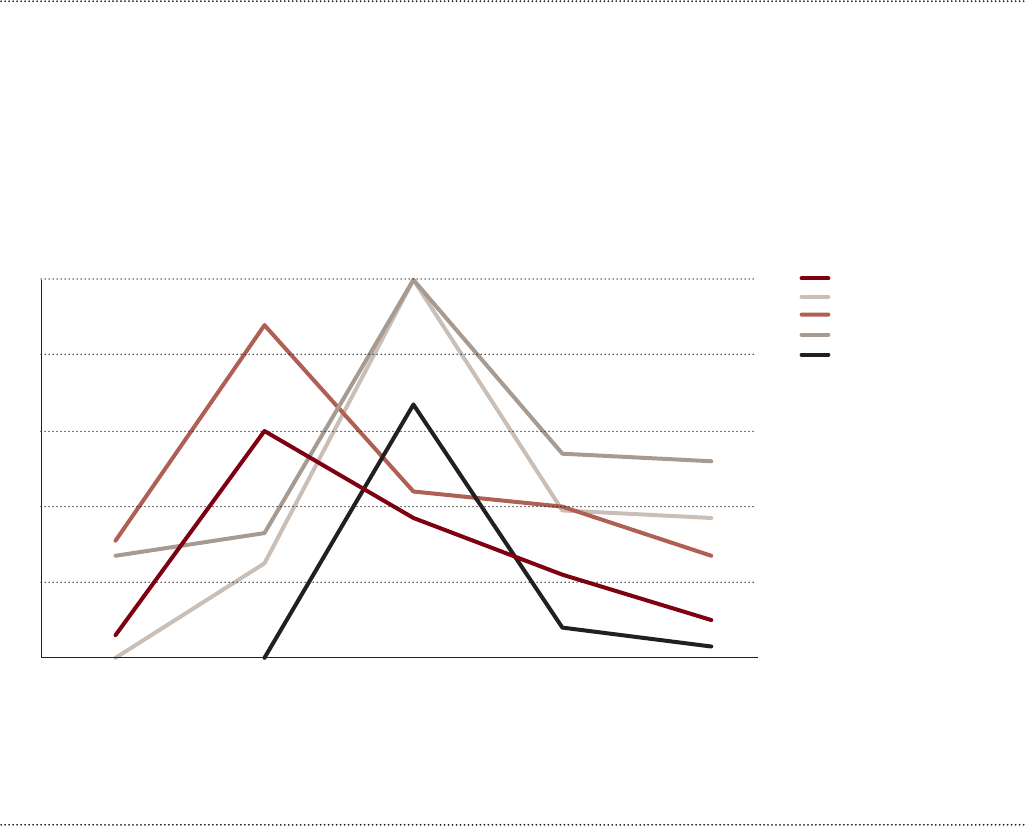
94 Strategy&
Note: The index shows the
total searches for a term,
relative to the total number
of searches done on
Google over time— a line
trending downward means
a search term’s popularity
is decreasing compared
with other searches, but it
doesn’t necessarily mean
that the total number of
searches for that term is
going down.
Source: Google Trends;
Strategy& analysis
Exhibit 32
Booming export of K-pop music
20112010 2012 2013 2014
South Korea
U.K.
Japan
Worldwide
U.S.
Search of K-pop by country
(index of
YouTube search, September 2010–14)
20
40
60
80
100

95
took in a total of $9.29 billion in revenues in 2015, and exports made
up a third of that, up from a quarter just four years earlier. And while
online games represent the majority of the gaming exports, mobile
games have become the key driver of the growth in exports, up 13
percent annually between 2010 and 2015 (see Exhibit 33, next page).
82
One particularly successful export example is MapleStory, a 2D, side-
scrolling online game developed by Nexon and launched in April 2003.
The game brought in an average of $176 million in revenue annually
through 2013. In 2014, 18 million Koreans, along with 150 million
people more worldwide, played MapleStory.
Several versions of the game are customized for specific countries; for
example, in the Japanese version, cherry blossom backgrounds and
items are used during the cherry blossom season. MapleStory’s success
is mainly driven by such localization of gaming experiences. However,
South Korea’s gaming market isn’t just an export success: Domestic sales
grew by 6 percent per year from 2010 to 2015, reaching $6.4 billion by
2013.
83
Emerging artists flourish, bringing new types of content to
audiences
The Internet’s ability to democratize content creation, in both South
Korea’s gaming and music industries, has led to the rise of many new
artists and game creators.
Emerging artists enjoy direct access to audiences. In music, digital
platforms such as YouTube, MelOn, Mnet, and others are serving as
open distribution channels for independent artists to promote their
music and reach new audiences. Under these circumstances, it is fans,
and not the record labels, the media, or large companies, that build the
careers of these new artists, based solely on their likes and dislikes.
Singer Sungha Jung, for instance, released his first YouTube video in
2006; since then his videos have been viewed more than 1.2 billion
times. With 3.9 million subscribers by April 2016, he is the biggest
YouTube music creator in Korea today.
84
Social media, too, is playing a major role in this process. The band
Hyukoh, for instance, went mainstream following the release of its
concert video feeds, uploaded through social media channels.
Young game creators also have found real success thanks to the
openness and transparency of the Internet. Traditionally, it was dicult
for independent game makers to release their games on consoles, as
large game makers exerted virtually absolute control over the physical
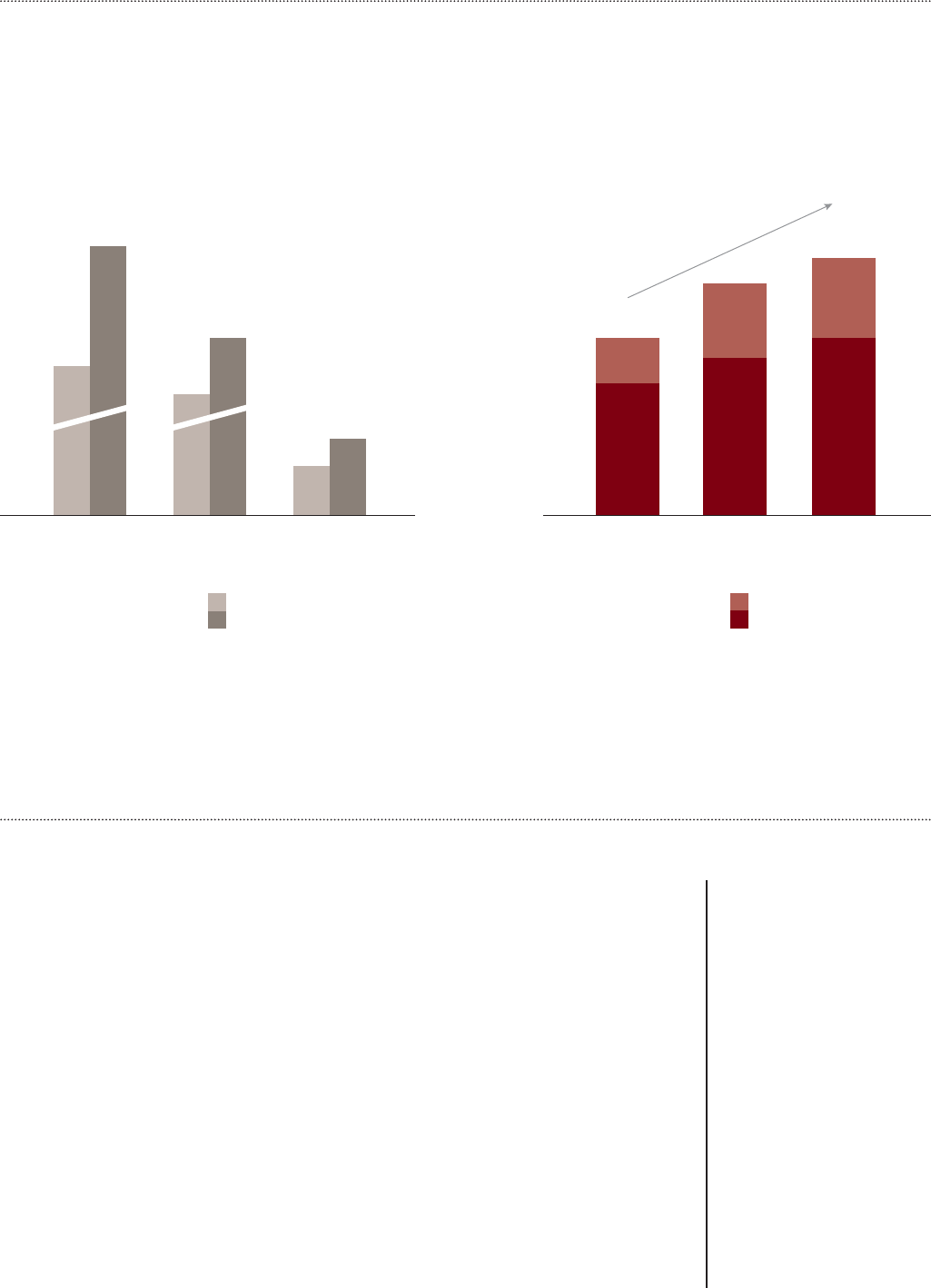
96 Strategy&
release of new games on CDs and DVDs. Digital distribution platforms
have changed all that, allowing independent developers to distribute
their games online without having to negotiate deals with publishers,
and with little or no distribution cost.
Moreover, online platforms allow developers to interact with consumers
and build a following even before their games are released. Steam’s
Greenlight system for PCs and Macs, for instance, encourages users to
pick the games they want to see released on its platform through ratings
and feedback. In one example, an experimental PC game called 6180
the Moon, developed by the independent Korean studio Turtle Cream,
was “greenlit” by consumers and then released on Steam, to rave
reviews. Since then, the game has been released on other platforms,
including Desura and Nintendo Wii U.
0.1
0.2
$2.4
Online games
$2.5
Total games
$2.3
$2.7
Mobile games
2011
2013
Korean game exports
(in US$ billions)
Korean game industry
(in US$ billions)
$9.3
2015
$8.4
2013
31%
69%
25%
75%
$6.4
32%
2010
68%
International sales +13%
Local sales +6%
+8%
Source: KOCCA and Korea
Economic Institute; “White
Paper on Korean Games,”
KOCCA, 2012 and 2014
Exhibit 33
Increasing export revenues for the South Korean gaming industry

97
Designers of mobile games have benefited as well. Bu Knight, a role-
playing app developed by Bu Studio, an independent studio run by a
single individual, was initially released as an Android app. Within a few
weeks of its launch in October 2014, Bu Knight had been downloaded
more than 100,000 times, and it has since become the top paid app in
both Japan and Taiwan.
85
More recently, indie game developers who are short on money and
distribution ability have been integrating their new games with mobile
messaging and social apps such as Kakao Games— a business model
that is boosting both parties. Developers benefit from social apps
because they can eectively promote their games through the apps’
social invite function, and the messaging and social platforms can
expand their user base and thus boost revenues.
A case in point is AniPang, a casual game oered by social game developer
SundayToz and first launched in 2009 on a regular Web-based platform,
meeting with limited success. Then, in 2012, it was chosen as the first
game to be launched on Kakao Talk’s new gaming platform, Kakao Games.
The new, mobile version integrated Kakao’s social media and messaging
platforms, where friends can send each other virtual goods and compete
for the top score. Within a year, AniPang became the most popular mobile
game in South Korea, reaching more than 25 million downloads and 20
million active users from 2012 to 2013. AniPang was estimated to bring in
$500,000 in revenues per day within a year of its release.
86
Passions converted to successful businesses. Games are also at the
heart of another Internet-driven shift in South Korea’s creative sector.
Online video platforms have unleashed any number of user-generated
video commentaries on games and other creative pastimes such as
makeup entertainment (in which cosmetics artists show how to create
various looks), and succeeded in converting the artists’ passions into
careers, profiting from content they create. More than 15 YouTube
channels of independent artists in all genres are ranked in the top 100
Korean channels with the most subscriptions.
Indeed, the largest video category on YouTube in South Korea is
commentaries about gaming. One of the most popular is the YD Gaming
Channel, which oers user-generated content about video games and
commentary from players. On average it takes just two weeks for videos
on the channel to reach 200,000 views, and its subscriber base grew
34 percent, to 1.67 million, in the past year alone. South Korean
YouTube star Na Dong-hyun began his Great Library channel with video
commentaries of live gaming sessions, then moved on to oer more
general information, including movie reviews and cooking advice.
In 2014, Na’s channel drew in 200,000 subscribers; since then, the
number has increased to 1.2 million.
87

98 Strategy&
In another genre altogether, Ssin has become a pioneer of makeup
entertainment, popularizing the art of makeup. As of May 2016, she had
971,000 followers on her YouTube channel, and she is soon to release a
how-to book on makeup.
South Korea’s new artists have also benefited from the rise of MCNs—
companies that provide individual creators with assistance in
production, distribution, monetization, and audience development, and
then place the results of their creative eorts on distribution platforms
like YouTube.
Korean MCNs, less powerful than their counterparts in other countries
such as Australia and India due to the country’s dominant record labels,
are starting to attract interest from investors— in November 2015 the
MCN startup Makeus secured a $17 million investment from four
venture capitalists.
88
MCNs have created an ecosystem for bringing
emerging creators into the video business by incubating their content
and helping them succeed along their journey. Currently, through
YouTube, Facebook, and Kakao Story, Makeus has more than 25 million
subscribers. Its popular channels include Il-So-Ra, Snack Video, and
comedy channel Sae-Ut-Dong. Makeus aims to further enhance its video
production capabilities by creating a digital content studio and securing
leading content developers to strengthen its market share in mobile
broadcasting in Korea and other parts of Asia.
89
Other MCN companies
that have received investments include Treasure Hunter ($13.6 million),
Kongdoo ($1.7 million), Sandbox Network ($860,000), and Video
Village ($500,000).
Alternative funding models support independent artists.
Crowdfunding— raising money for specific projects over the Internet—
has become a popular means of supporting new artists and gamers in
South Korea, as in the other regions we studied. The country has more
than 10 local crowdfunding platforms. Many South Korean game
makers use international platforms such as Kickstarter. Magicians, a
role-playing PC game that helps users learn Korean, was developed by
Kyle Simmons, a student turned game developer living in Seoul, with
$35,000 he raised on Kickstarter. There are also several local platforms,
including Tumblbug, Fundu, and Upstart, that specialize in creative and
cultural projects, including Pied Pipers Entertainment, an independent
Korean startup that raised almost $17,000 on Tumblbug to fund Army
and Strategy: The Crusades, its PC-based strategy game.
90
Crowdfunding sites oer the further benefit of putting game developers
in direct contact with their many funders, which helps build demand for
the game even before its ocial release.

99
Conclusion
South Korea’s high level of Internet penetration and its people’s
propensity to pay for digital content have had a significant impact not
only on the growth of the local creative sector but also on the global
appeal of its creative content and the ability of new artists to find an
audience. Indeed, South Korea has one of the most robust creative
sectors in the world— its market for digital media grew an impressive
21 percent annually between 2011 and 2015.
In short, digital media is leading the way in South Korea’s creative
sector. Revenues from digital are growing much more quickly than
revenues from oine cultural content, and that will likely continue
well into the future.

100 Strategy&
Chapter 5
Thailand: Transition to digital
creative content
Thailand has a vibrant creative sector, growing faster than the country’s
GDP— 4 percent annually from 2011 to 2015,
91
compared with overall
GDP growth of 2 percent
92
— and at about the same rate as consumer
spending during the same period. Thai consumers are eagerly adopting
digital platforms for accessing creative content— especially on
smartphones, as the market is characterized by a 144 percent
penetration of mobile broadband. Thailand is already among the
world’s most active markets for online video usage, ahead of developed
countries such as the U.S., the U.K., and Australia in terms of percentage
of video viewing time on digital platforms.
But Thailand’s creative sector is still making the transition between
traditional and digital development and distribution of media content.
Fixed broadband connectivity is still relatively low, at about 30 percent
of households in 2015,
93
but mobile penetration has grown rapidly—
now, more than 147 percent of the population has mobile phones, some
people owning more than one device.
94
And more and more Thais can
access the mobile Internet, thanks to improved 3G coverage and the
recent introduction of 4G services, aordable data plans and mobile
devices, and a government determined to digitize the country’s
economy and boost digital inclusion.
Trends shaping Thailand’s creative market
Traditional media also has good penetration in Thailand; 98 percent
of households had TV sets in 2015.
95
As such, Thailand benefits
considerably from the tools required to consume creative content
both through traditional means and on digital devices.
Despite Thai consumers’ healthy appetite for content, however, the
economic contribution of digital oerings is still relatively low. Digital
made up just 9 percent of the sector’s total revenues in 2015, yet that
figure is expected to grow to 13 percent by 2020, driven mainly by
gaming (see Exhibit 34, next page).

101Strategy&
Note: Results of
calculations may not be
exact due to rounding.
Source: PwC’s Global
Entertainment and Media
Outlook; Strategy& analysis
Exhibit 34
Increasing growth from digital
Creative sector size, by industry
(in US$ billions
)
$8.0
51%
17%
17%
7%
8%
$6.5
47%
22%
18%
7%
7%
$5.6
46%
25%
17%
7%
5%
+0%
+6%
+9%
+4%
+4%
CAGR
(2011–20F)
Digital creative sector size, by industry
(in US$ billions)
2%
1%
31%
$1.0
+31%
+35%
+43%
+2%
64%
+11%
7%
9%
22%
11%
51%
$0.6
5%
6%
11%
16%
62%
$0.3
CAGR
(2011–20F)
Books
Print
Video
Music
Games
2015 2020
(forecast)
2011 20152011 2020
(forecast)
+4%
+4%
+13%
+13%

102 Strategy&
Thailand’s gaming sector, the largest in Southeast Asia, is driven
primarily by PC and console users, but app-based and social gaming
is on the rise. Gaming is the most digitized of the country’s creative
industries, and the fastest growing.
96
Thailand beats most developed nations in online video viewing.
Thais spend much more time accessing online videos than people
in developed countries. Fully 55 percent of the time people spend
watching video takes place online; 45 percent goes to traditional TV.
That’s an average of 12.3 hours per week on Internet video compared
with 10.3 hours on broadcast TV.
97
By contrast, just 16 percent of
viewing time is spent online in the United States.
98
“The Internet is gradually replacing traditional TV as viewers take
advantage of the flexibility and convenience of accessing online content
anytime, anywhere. Once viewers get used to watching the show
online, it is hard to bring them back to the traditional TV platform,”
says K. Issada, creator of Choc Chip Channel.
99
However, viewership on online channels is not yet a significant source
of earnings. More than 99 percent of the revenues from video in
Thailand still come from broadcast TV. Although top online channels
are funded by ads, they have not yet been able to bring in enough ads
to grow revenues significantly.
Overall, the prospects for the creative sector in Thailand are positive,
and the Internet will play a major role in its continuing growth. In the
following sections, we look at how the Internet is positively aecting
numerous aspects of the country’s creative industries.
Digital drives deeper engagement for consumers and open
access to content
The rise of digital platforms in Thailand’s creative sector has driven
greater end-user participation and has further enabled all of Thailand’s
population to access informational and educational content.
Improved variety and accessibility of video content. One
particularly noticeable eect of the Internet in Thailand has been the
rapid increase in so-called dual-screening— watching videos on a
traditional TV and online at the same time. By 2014, the percentage of
Thai Internet users consuming online and traditional TV simultaneously
had reached 94 percent, with 76 percent doing so on a daily basis.
100
Currently, the consumption of stand-alone TV is still slightly higher
than that of dual screening, but by 2020, TV-only and dual-screening
consumption are expected to reach parity.
101

103
The popularity of dual-screening demonstrates just how successful the
TV industry has been in its eorts to benefit from the Internet,
providing a dierentiated, interactive, and personalized viewing
experience. Two new online video companies, Hollywood HD and iFlix,
have been particularly successful in taking advantage of this trend.
Access to information. In addition to facilitating better engagement
with consumers, the Internet has been a key factor in increasing the
spread of information in Thailand. New platforms such as forums and
blogs allow Thais the opportunity to participate in all kinds of
experiences, from rating restaurants to uploading videos to commenting
on articles. Today, even political campaigns require candidates to be
present in social networks and answer the concerns of their
constituents.
Engagement with Thailand’s blogs and forums is among the highest in
the world, reaching more than 71 percent of Internet users in Thailand
in 2013, versus 54 percent in the rest of the world and 44 percent only
in Asia.
102
Pantip, one of Thailand’s largest forums, with more than 1.7 million
registered users and 3 million non-registered users as of January 2015,
Hollywood HD
Launched in March 2014, Hollywood HD
was modeled after Netflix to provide a
high-quality movie and TV service and
the convenience of watching anytime,
anywhere, anyhow, at a sensible price.
The company oers movies from
Hollywood and from Asia, TV series,
cartoons, and live TV. At any given
time, subscribers can watch more than
1,000 titles, and more than 100 new
titles are being added each month. The
content is available via iOS and Android
smartphones and tablets, through Apple
TV, and on PCs.
A few months after its launch,
Hollywood HD was ranked the top
entertainment app in Thailand for
iPhones and iPads, and in the top 10
across all categories.
*
More than 100,000
videos have been downloaded in six
months, and the company’s subscriber
base was expected to have reached more
than 1 million in 2015. Prices start at
$5 a month, cheaper than illegal DVDs,
and the expanding subscriber base
demonstrates that people won’t buy
pirated content if there is a reasonably
priced legal alternative.
**
* “Netflix of Thailand wants you to stop illegally
download movies and start paying for them,”
TechInAsia, Apr. 3, 2014.
** “Hollywood HDTV On Demand Movies and TV
Shows in Thailand,” thaitech by thaivisa.com, Apr.
20, 2015.

104 Strategy&
allows participants to discuss political news, religion, celebrities,
education, sports, and other hot topics.
103
The site’s most talked-about
recent topics included a comfort food recipe by Mun-kaew-kub-hua-
moo, which was chosen as the top topic of 2014, and “My little oce”
by Mommam777, a collection of photos taken by a pilot that was shared
on Facebook more than 170,000 times, with 1 million “likes.”
104
Says Apisil Trungkanont, co-founder of Pantip, “We depend on and
support user-generated content. We have a culture which encourages
sharing of such content by allowing votes on high-quality content and
popular posts.”
105
The result of this support is impressive: With 4.5
million unique visitors and 16 million page views daily by September
2015, Pantip was ranked as Thailand’s top local site in terms of trac,
and the fifth site overall after Google (Thailand and U.S.), Facebook,
and YouTube.
106
Remote access to educational resources. In addition to the benefits
the Internet has brought to the commercial side of Thailand’s creative
sector, it has played a considerable role in widening social inclusion by
improving access to educational and cultural content for Thais living in
remote areas. Platforms such as YouTube and blogs not only can break
down the geographic barriers that leave people in rural areas feeling
isolated, but also can remedy the problem of teacher shortages by
making educational material readily accessible to all users.
Weerachai Martluplao, for example, is a music teacher in Thailand who
has been using a mix of YouTube, SlideShare, and his blog to teach Thais
iFlix
An even more recent entrant into
Thailand’s video market is iFlix. Already
present in Malaysia and the Philippines
with 100,000 subscribers just six weeks
after launch, iFlix launched in Thailand
in September 2015, and currently
oers online movies, TV series, and
children’s content from Hollywood and
throughout Asia. Much as with Netflix,
the content can be accessed anytime,
from anywhere, and on any device, with
a focus on mobile devices; unlike with
Netflix, the user is able to download
content for later viewing.
Within a week of its launch in Thailand,
iFlix had attracted 15,000 subscribers,
mainly young people living in urban
areas. And because iFlix is already
spreading across Asia, its shared cost
structure allows it to oer among the
cheapest legal streaming services in
Thailand. A monthly subscription costs
just $2.80.* And, as with Hollywood HD,
iFlix’s attractive pricing helps reduce the
high level of piracy in Thailand.
* PwC and Strategy& interview with K. Artima
Surapongchai, country manager for Thailand at
iFlix, Sept. 2015.

105
how to play the khaen, a type of mouth organ. In the past, aspiring
khaen students had to train directly with teachers, with the shortage of
qualified teachers greatly limiting access. But Martluplao’s digital videos
on YouTube, which had been viewed more than 350,000 times by May
2016, have extended his reach not just in Thailand but beyond.
107
Designed for all skill levels, the videos can be watched by students as
many times as needed, while the blog lets them reach out to Martluplao
for more information on how to play the instrument.
On a larger scale is Ormschool, an online tutoring service for high
school and university students launched in 2005 that had been gaining
more than 300,000 new viewers a month by September 2015. The
company oers free, high-quality educational content to students all
over Thailand, who can access content through a variety of channels.
Ormschool reaches its audience primarily through YouTube videos,
which provide the actual content, and Facebook, through which it
promotes its content and other events. These tools let the company
test the eect of content by uploading sample versions and allowing
students to choose how they want to receive and interact with content.
And it plans to launch an application that will establish even closer
connections with its audience and enable it to answer student queries
in real time.
Further benefits of Ormschool include access for students in rural areas
who have an Internet connection, students who want to work from
home if they are sick, and those who want to rerun a specific class or
program. And it has extended its reach to include students in other
countries, including Laos, whose language is similar to Thai.
108
Traditional players are using digital platforms to build
new audiences
As Thailand’s creative sector becomes more digitized, traditional
players in virtually every creative industry are boosting growth and
driving profitability through the integration of their oine and online
businesses. Moreover, they are reaching new consumer segments—
most notably people younger than 30, who have been drifting away
from traditional oine media consumption— and their increased
reach has driven additional revenues, making up for the decline of
traditional advertising. The Internet has helped these old-line players
to boost margins too, since it makes it cheaper to distribute content or
market it. The following case studies indicate how companies in several
industries have leveraged the Internet to keep growing and increasing
their reach.

106 Strategy&
Newspapers. Thai Rath’s popular online news oering has been
instrumental in enabling the Thai-language newspaper— the country’s
oldest and most widely read— to rapidly expand its audience and
capture younger consumers.
The website had 5.8 million users in September 2015,
109
compared
with 2.4 million readers of the print edition.
110
“Our paper and online
versions cater to dierent readers. Online news is more appealing to the
30-and-under age group. This group was not a big reader of our oine
newspaper, and online has helped us increase our reach to them,” says
Vachara Vacharaphol, CEO of online and digital TV business at Thai
Rath.
111
Television. TV3, Thailand’s first commercial television station, was
launched in 1970, and it is now the second most popular traditional TV
station nationwide, after Channel 7. By May 2016, more than 18,500
videos had been uploaded to TV3’s ocial YouTube channel, and with
more than 1.9 billion views, TV3 now ranks number one among
traditional TV station channels on YouTube and 16th among all YouTube
channels in Thailand.
112
Overall, while TV3’s traditional TV ratings
declined by 21 percent between October 2014 and April 2015, monthly
views on YouTube increased by more than 300 percent during the same
period, from 16 million to 62 million views.
Books. Although Kledthai, a traditional publisher and distributor of
academic books and novels, has not yet begun publishing e-books, by
adapting its sales and marketing eorts to the Internet, the company
has improved its financial performance by 10 to 20 percent annually,
thanks primarily to lower sales and marketing costs. Kledthai leverages
the social application Line as a sales channel as well as a customer
service channel. The Internet also allows Kledthai to market its books
through Facebook, Twitter, and Instagram, to identify new book-buying
trends, and to target new customers.
113
Music. The music industry, too, has benefited from the Internet, as
traditional record labels promote their artists online and on social
media platforms, with impressive results. Thailand’s largest music
company, GMM Grammy, for example, is taking advantage of the rapid
digitization of the country’s music industry. In 2010, it launched the
GMM Grammy Ocial YouTube channel, which posts several music
videos featuring the label’s artists every day. The channel is now
ranked first in terms of total video views in Thailand, with its 5.3
million subscribers bringing in more than 160 million views in
January 2015. Since its launch, the channel has attracted more
than 4.5 billion views.
114

107
The Internet as catalyst for emerging artists’ growth
Increased engagement with fans is not happening only in the music
business.
Capturing consumer insights and engaging with users. As companies
in every creative industry in Thailand move online, they are finding new
ways to take advantage of better interaction with audiences, learning
more about audience preferences by gathering and analyzing customer
data, and tailoring content to the audience’s needs and expectations.
Thailand’s Nation TV has pioneered the integration of broadcasting with
social media. In July 2015, the company launched its “Social TV” project
to collect and analyze consumer insights on social media platforms in
collaboration with Computerlogy, a Thai software company. The project
uses real-time social media data analytics to better understand audience
preferences in all the company’s news programming covering the
economy, politics, and entertainment.
115
Digital platforms as a catalyst for entrepreneurship. Before the
advent of the Internet, content distributors were confined to a finite
amount of inventory space, and so had to be highly selective in deciding
which content they would distribute. It gave them little room to
experiment. The Internet has changed that entirely. Now, distributors in
every creative industry can make available a virtually unlimited library
of content and freely experiment with all kinds of niche oerings.
Non-mainstream content creators now have the opportunity to
distribute their content and reach audiences at little cost, while
providing consumers with much more choice.
At the most basic level, this has enabled creators to turn their passions into
businesses, often through videos they post on YouTube. Some examples
116
:
• Thanks to her videos, Pearypie is now one of the most famous
makeup artists in Thailand. Views of her YouTube channel increased
more than 50 percent, to almost 200,000, between February and
July 2015. Her success has given her opportunities to work with
fashion magazines and host her own makeup workshops.
• Bie the Ska is one of the biggest user-generated content channels in
Thailand, with 1 million views of its videos in July 2015. The channel
posts scripted comedy videos including vlogs and parodies twice a week.
• Begun by a group of Thai youngsters posting videos shot with their
mobile phones, Fedfe is now the biggest comedy content creator in
Thailand, with 1.2 million views in July 2015, making it the 57th
most popular YouTube channel in Thailand in July 2015.

108 Strategy&
Digital startups serve the untapped demand for niche and local
content. SpokeDark TV is a TV production company that struggled to
sell its content to traditional outlets because its non-mainstream
content— including political shows and niche oerings in beauty and
style— was a tough sell to advertisers. So the company created its own
YouTube channel and launched a website, and it is now thriving. The
website now is ranked as Thailand’s 96th most popular on Alexa, while
the viewer and subscriber numbers for its YouTube channel are all up
significantly (see Exhibit 35, next page).
The recent success of SpokeDark TV on digital distribution channels
is a testimony to the untapped demand for niche and local content in
Thailand. The digital online distribution platforms will continue to
play a key role in filling this gap.
Emerging artists lead Thailand’s gaming sector into exports. It has
long been dicult for independent game makers to distribute their
content on traditional gaming consoles. But now, thanks to the advent
of digital distribution platforms, independent game developers in
Thailand can distribute and sell their games widely and negotiate deals
with publishers. Such platforms are an easy way for indie game makers
to release their creations with minimal distribution costs— indeed,
new titles pop up regularly. Some independent game makers turn to
well-known global distribution platforms like Apple’s App Store, Google
Play, and Steam, while others have found success on local platforms
such as Thailand’s Sanook and Kapook.
In 2009, for example, Thai indie developer Kirakorn Chimkool launched
a puzzle game, called Unblock Me, designed on a $700 Mac Mini bought
with a 10-month installment loan. Just a few days after he submitted
the game to Apple’s App Store, the title went live with both a paid and a
free version. Within a few days of its release, the free version of Unblock
Me became the 60th most downloaded game and the most downloaded
app in every category on the App Store.
117
Since then, the game has been
released on Google Play, HTML5, and the Tizen OS. By May 2016, it had
been downloaded almost 120 million times.
Room 39 is another concrete example where a hobby was turned
into a profession: The Thai pop music band, casually formed in an
apartment in Los Angeles in 2010, performs remixes of popular
Thai and international songs. Boyd Kosiyabong, the co-founder of
record label Love Is, discovered Room 39 on YouTube in 2010. Today,
more than 25 of Room 39’s videos have surpassed 1 million views,
and the group’s latest single reached the top five just three weeks
after its debut, bringing value and fame to both Kosiyabong and
the artists.

109Strategy&
Note: “Audience retention”
represents the ability
of videos to keep the
audience’s attention/
interest.
Source: Alexa; Social
Bakers; YouTube; The Next
Web; Strategy& analysis
Exhibit 35
SpokeDark TV’s YouTube channel gains momentum
July
2015
158
Feb.
2015
135
687
614
Number of YouTube subscriptions
(in thousands)
Number of YouTube views
(in millions)
Audience retention on YouTube
(2015)
Average Thai
channel
25%
SpokeDark TV
42%
Average view duration per channel
(in minutes, 2015)
4
8
July
2015
Feb.
2015
Average Thai
channel
SpokeDark TV
+16%
+12%

110 Strategy&
Yet another example is Jannine Weigel, a teenage YouTube star living in
Thailand. She records covers and achieved 1.7 million subscribers and
300 million views between 2013 and May 2016. More than 60 of her
videos have garnered more than 1 million views. Her YouTube channel
was ranked number 30 in Thailand in September 2015.
Digital distribution models allow for more favorable
economics for authors
New distribution platforms enable independent creators not just to
reach an audience but also to allow their fans to assist in the process of
content creation. One example is Ookbee, a digital magazine and book
platform launched in 2010. It acts as a distribution platform for nascent
writers to publish their work, but it also provides a digital community
where writers and readers can interact, and a complete end-to-end
support solution for writers, including help and advice with content
preparation, storage, delivery, and even billing and payment for their
publications. Ookbee currently has an 85 percent share of Thailand’s
e-book market and a more than 90 percent share of the Thai digital
magazine market. With virtually no printing or distribution costs,
Ookbee’s business model is easily exported to new geographies— it
now has a leading market position in the Philippines, Malaysia, and
Vietnam. Already, the company has delivered more than 6 million
e-books and its app has been downloaded more than 8.5 million times;
as of May 2016, it had 5 million active users.
The success of distribution platforms like Ookbee has also opened up
opportunities for content creators to gain their rightful share of the
sales of their creations. Book publishing is a clear example of this
phenomenon. By lowering the cost of marketing, production, and
distribution, online publishers can give authors a larger percentage of
sales revenues (see Exhibit 36, next page). Authors also benefit from
direct access to their readers, through online forums and reviews.
This development has prompted considerable growth in the number of
self-published authors in Thailand, where in 2014, the number of self-
published books increased by five times according to Ookbee. As a
result, while online book distribution made up just 1 percent of the
Thai book market, it is expected to more than double in 2016.
Conclusion
Players in Thailand’s creative sector are working hard to leverage the
growing demand for digital content. Content majors are integrating
digital platforms into their mainstream businesses not only to gain

111Strategy&
Exhibit 36
Financial benefits of self-publication
Revenue allocation from books in Thailand
70%
45%
30%
10%
15%
30%
Online book
distribution
Traditional book
distribution
Publisher
Distributio
n
Production
Author
Source: PwC’s Global
Entertainment and Media
Outlook; interview with
manager at TCDC; Forbes
Thailand; Strategy& analysis
access to incremental audiences but also to drive increased eciency.
Newspaper Thai Rath, for instance, doubled its audience in 2015 by
accessing new demographic segments through its online news oering.
Similarly, book publisher Kledthai actively deploys its online channel
for improving the eciency of its marketing, which has enabled the
company to enhance its profitability by 10 to 20 percentage points.
On the other hand, emerging artists are leveraging digital platforms
to create sustainable businesses and take advantage of new business
models that yield a greater share of the income their products generate.
For instance, independent writers are deploying online channels such
as Ookbee to distribute their content without having to negotiate deals
with book publishers, thereby benefiting from the higher revenue share
of 70 percent as opposed to 10 percent in traditional models.
Eorts of emerging content creators are enabling a more easily
accessible and wider selection for consumers, who have a richer access
to niche and local content than was ever before served on mainstream
media channels. Populations in remote areas are also benefiting from
access to educational resources delivered to them through smartphone
apps.

112 Strategy&
Finally, emerging artists are leveraging digital platforms to tap into
international audiences. This trend is most notable in the gaming sector,
where nascent creators such as Kirakorn Chimkool use global online
distribution outlets to access international markets and contribute to
Thailand’s exports.
The integration of digital platforms into the creative sector is well under
way in Thailand, although in its early stages of development. There is
no doubt that an increasing proportion of the growth of Thailand’s
creative sector in future years will be driven by the digital creative
economy.

113Strategy&
Conclusion
Digital models, driven by the proliferation of Internet, are fueling a
renewed growth in creative sectors. Increasingly, the power is shifting
to the consumers, who decide what they want to make, what they want
to consume, and how and when they want to consume. This change has
been the primary driver of innovation and investment in creative
sectors. Succeeding in this digital environment requires a dierent
approach and recipe than in the past. Players that have managed to
adopt these new models have benefited from this growth.
Although this report focuses on the impact of the Internet on creative
sectors, the Internet is a powerful tool that has impacted all of society.
Transformative as the Internet is to individuals’ lives, it also creates new
economic opportunities. The increase in Internet activity has stimulated
economic expansion, job growth, and poverty reduction (especially in
developing countries).
The Internet’s impact on the creative sector follows a similar evolution.
From 2011 to 2015, across the five countries studied here, the
penetration of mobile broadband increased at a CAGR of 5 percent and
smartphones by a CAGR of 31 percent. During the same period, the
digital creative sector grew at a rate of 7.5 percent. In aggregate, 84
percent of the $15 billion of revenues added to the creative sectors can
be attributed to digital. Consequently, digital share of total creative
sector in these countries increased from 11 percent to 18 percent in the
same period.
Consumers have embraced the digital world. They are spending more
time interacting with creative products. The quantity and relevance of
creative products have increased steadily, and the barriers to becoming
a creator have been lowered. Consumers are actively engaged in the
creation of content, with many reaching global audiences. New creators
and companies that have emerged are providing locally relevant content
in new genres, adding to the variety of oerings. In developing nations
such as India, the Internet is also driving social inclusion by enabling
consumers in remote areas access for the first time to information,
education, and entertainment content.

114 Strategy&
Although the demand for creative content is increasing, it is also
fragmenting. Traditional media players must now compete with purely
digital brands and platforms for the time and attention of the consumer.
In this world, traditional oine media strategies will be very hard to
defend. Agility and speed are as important as size, and often favor new
players. Some established players have been held back by
cannibalization of traditional revenue streams and fear that their
current assets will be devalued. New propositions, frequently
technology-led, need to be launched quickly, tested in the market, and
adapted in the market. This approach can be challenging, especially for
large corporations. But as long as the consumer benefits and spends
more time with media, the creative sector will find a way to thrive.
Many new digital media possibilities will augment, rather than replace,
old media channels.
We are in the early stages of digitization of the creative sectors. The
evolving digital ecosystem in creative sectors will be much more fluid
than its predecessor, but it will also present abundant opportunities for
all players. We expect the Internet to contribute another $15 billion to
the creative sectors of the five countries studied here in the next five
years. Traditional players that are able to embrace the new models, in
the same way consumers have, stand to benefit immensely.

115Strategy&
Endnotes
Highlights
1
“Share of Time Spent per Day with Major Media by Australian Adults
(above 18),” GroupM.
Introduction
2
PwC’s Global Entertainment and Media Outlook.
3
PwC’s Global Entertainment and Media Outlook.
4
Reuters Institute Digital News Report 2015: Tracking the Future of News,
University of Oxford and Reuters Institute for the Study of Journalism, 2015.
5
PwC’s Global Entertainment and Media Outlook.
6
PwC’s Global Entertainment and Media Outlook.
7
Most of this growth was driven by new subscriptions and streaming
services: From 2011 to 2015, subscription revenue grew by 140 percent per
year, vs. 4 percent for downloads.
8
“Foxtel’s price cuts boost subscribers to 2.8 million, but at a cost,” Sydney
Morning Herald, Aug. 13, 2015.
9
PwC’s Global Entertainment and Media Outlook.
10
IMF and Euromonitor.
11
PwC’s Global Entertainment and Media Outlook.
12
PwC’s Global Entertainment and Media Outlook.
13
Social Blade.
14
Strategy& interview with Rajjat Bharjatya, Sept. 17, 2015.
15
Nielsen Online Ratings.
16
Korean Creative Content Agency.
17
“White Paper on Korean Games,” KOCCA, 2012 and 2014; Eurogamer.
18
PwC and Strategy& interviews with Shae-Lee Shackleford of SketchShe,
Oct. 2015, and with Josiah Brooks, Oct. 2015.
19
PwC and Strategy& interview with Hitendra Merchant, CEO of YoBoHo,
Sept. 21, 2015.

116 Strategy&
20
IAMAI-IMRB Internet in India report, 2014.
21
App Annie.
22
Nielsen CMV Thailand (2008–14).
23
“Meet the New Media Consumer in Thailand, 2014”, Videology and
Nielsen report.
24
Analysis of several Enhanced Media Metrics Australia (EMMA) audience
reports.
25
Social Blade.
26
PwC and Strategy& interview with Birathon Kasemri, chief commercial
officer at TrueVisions, Aug. 26, 2015.
25
PwC and Strategy& interview with Gil Scrine and Louise Van Rooyen,
co-founders and directors of Beamafilm, Aug. 21, 2015.
28
PwC and Strategy& interview with Martina Go, former general manager
of Hearst-Bauer in Australia, Aug. 13, 2015.
29
YouTube.
30
Game Sauce.
31
Game Sauce.
32
Next Big What, Wishberry.
33
Pozible, Australian Financial Review.
34
Social Bakers.
Chapter 1: Japan
35
Playism, Touch Arcade.
36
WBIS.
Chapter 2: India
37
PwC and Strategy& interview with Vivek R, head of books category at
Flipkart, Oct. 15, 2015.
38
PwC and Strategy& interview with Rajjat Bharjatya, CEO of Rajshri Media,
Sept. 17, 2015.
39
PwC and Strategy& interview with Vivek R, Flipkart, Oct. 15, 2015.
40
PwC and Strategy& interview with Rajjat Bharjatya, CEO of Rajshri Media,
Sept. 17, 2015.
41
“Fandango Acquires M-Go Movie Service from Dreamworks Animation
and Technicolor,” Variety, Jan. 29, 2016.
42
PwC and Strategy& interview with Rajjat Bharjatya, CEO of Rajshri Media,
Sept. 17, 2015.
43
PwC and Strategy& interview with Hitendra Merchant, CEO of YoBoHo,
Sept. 21, 2015.

117
Chapter 3: Australia
44
WBIS.
45
Statista from GroupM.
46
EMMA audience report.
47
Euromonitor; BCG; Strategy& analysis.
48
Informa Telecoms.
49
Informa Telecoms.
50
IAB/Nielsen Mobile Panel Pilot Data, July 2014.
51
PwC and Strategy& interview with Courtney Barnett and her manager
Nick O’Byrne, Aug. 18, 2015.
52
PwC and Strategy& interview with Emmanuel Candi, head of strategy and
HR, and Gavin Parry, head of digital, Sony Music Australia, Aug. 20, 2015.
53
PwC and Strategy& interview with Jane Huxley, managing director of
Pandora Australia and New Zealand, Aug. 19, 2015.
54
PwC and Strategy& interview with Shae-Lee Shackleford of SketchShe,
Oct. 2015.
55
PwC and Strategy& interview with Emmanuel Candi, head of strategy and
HR, and Gavin Parry, head of digital, Sony Music Australia, Aug. 20, 2015.
56
“Netflix Australia reaches 2.5M users: ACMA,” ZDNet, Nov. 16. 2015.
57
Australian Communications and Media Authority.
58
PwC and Strategy& interview with Alex Byrne, former CEO of the State
Library of NSW, Aug. 19, 2015.
59
EMMA audience report.
60
Based on a survey issued in Reuters Institute Digital News Report 2015:
Tracking the Future of News, University of Oxford and Reuters Institute for
the Study of Journalism, 2015.
61
EMMA audience report.
62
PwC and Strategy& interview with Josiah Brooks, Oct. 2015.
Chapter 4: Korea
63
Exports of Korea’s content industry exceeded $5 billion in 2014.
64
WCIS.
65
Stat Counter Global Stat.
66
“Digital Content Report 2013,” IHS Technology and App Annie.
67
PwC’s Global Entertainment and Media Outlook.
68
The Next Web, DaumKakao.
69
PwC’s Global Entertainment and Media Outlook.

118 Strategy&
70
Shinhan Investment.
71
“Kakao to buy South Korea’s top music streaming operator for $1.6 billion,”
Reuters, Jan. 11, 2016.
72
YouTube.
73
Louisa S. Ha and Richard J. Ganahl, Webcasting Worldwide: Business
Models of an Emerging Global Medium (Routledge, 2007).
74
PwC and Strategy& interview with Hye-Ryung Park, former producer at
SBS Radio.
75
PwC and Strategy& interview with SeoungHa, Kim, director of Arirang
Radio.
76
Alexa.
77
“The Changing Korean Book Retail Industry: Digital Publishing in Korea
2014,” Publishers Weekly, Mar. 21, 2014.
78
“The Changing Korean Book Retail Industry: Digital Publishing in Korea
2014,” Publishers Weekly, Mar. 21, 2014.
79
PwC and Strategy& interview with Juhan Kim, general manager at SM
Entertainment.
80
“PSY’s ‘Gangnam Style’ Hits 1 Billion Views on YouTube,” Billboard, Dec.
21, 2012.
81
PwC and Strategy& interview with Dae-Yong, Lee, CEO of Rich World
Record Label.
82
“White paper on Korean Games,” KOCCA, 2012 and 2014; Eurogamer.
83
“White paper on Korean Games,” KOCCA, 2012 and 2014.
84
Social Blade.
85
“Buff Knight — Pixel RPG Runner,” buffknight.wordpress.com.
86
“The Candy Crush Saga of Korea: SundayToz’s Anipang generating
$500,000 a day,” AdWeek, Mar. 29, 2013.
87
Social Blade, Korean Herald.
88
“MCN startup ‘Makeus’ secure $17m investment from 4 venture capitals,”
beSUCCESS, Nov. 12, 2015.
89
“MCN startup ‘Makeus’ secure $17m investment from 4 venture capitals,”
beSUCCESS, Nov. 12, 2015.
90
UC–Berkeley International Symposium on Crowdfunding.
Chapter 5: Thailand
91
PwC’s Global Entertainment and Media Outlook.
92
Oxford.
93
WBIS.

119
94
WCIS.
95
Informa Telecoms and Media.
96
PwC’s Global Entertainment and Media Outlook.
97
“Meet the New Media Consumer in Thailand, 2014”, Videology and
Nielsen report.
98
Monthly time spent on watching video content in the U.S. from Nielsen.
99
Strategy& interview with K. Issada, Sept. 7, 2015.
100
“Meet the New Media Consumer in Thailand, 2014”, Videology and
Nielsen report.
101
Nielsen CMV Thailand (2008–14).
102
comScore 2013.
103
PwC and Strategy& interview with Apisil Trungkanont, co-founder of
Pantip, Aug. 26, 2015.
104
Forbes Thailand.
105
PwC and Strategy& interview with Apisil Trungkanont, co-founder of
Pantip, Aug. 26, 2015.
106
Alexa.
107
“Music teacher uses YouTube to enhance ancient skills,” The Nation
Multimedia (Thailand), Mar. 17, 2015.
108
PwC and Strategy& interview with Khun Jack of Ormschool, Sept. 7, 2015.
109
Alexa.
110
Brand Connections.
111
PwC and Strategy& interview with Vachara Vacharaphol, CEO of online
and digital TV business at Thai Rath, Aug. 21, 2015.
112
Social Blade.
113
PwC and Strategy& interview with K. Anuk, top manager of Kledthai,
Aug.
21, 2015.
114
Social Bakers.
115
The Nation Multimedia (Thailand).
116
Social Bakers.
117
Game Sauce.
Strategy&

© 2016 PwC. All rights reserved. PwC refers to the PwC network and/or one or more of its member firms, each of which is a separate legal entity. Please see www.pwc.com/structure for further
details. Mentions of Strategy& refer to the global team of practical strategists that is integrated within the PwC network of firms. For more about Strategy&, see www.strategyand.pwc.com.
No reproduction is permitted in whole or part without written permission of PwC. Disclaimer: This content is for general purposes only, and should not be used as a substitute for consultation
with professional advisors.
www.strategyand.pwc.com
Strategy& is a global team
of practical strategists
committed to helping you
seize essential advantage.
We do that by working
alongside you to solve your
toughest problems and
helping you capture your
greatest opportunities.
These are complex and
high-stakes undertakings
— often game-changing
transformations. We bring
100 years of strategy
consulting experience
and the unrivaled industry
and functional capabilities
of the PwC network to the
task. Whether you’re
charting your corporate
strategy, transforming a
function or business unit, or
building critical capabilities,
we’ll help you create the
value you’re looking for
with speed, confidence,
and impact.
We are part of the PwC
network of firms in 157
countries with more than
223,000 people committed
to delivering quality in
assurance, tax, and advisory
services. Tell us what
matters to you and find out
more by visiting us at
strategyand.pwc.com.

